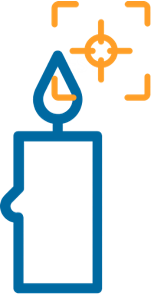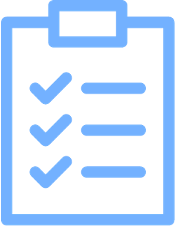Accelerate Growth – Workshop 1 (Growth Sources)
The Appleton Greene Corporate Training Program (CTP) for Accelerate Growth is provided by Dr. Fankhauser Certified Learning Provider (CLP). Program Specifications: Monthly cost USD$2,500.00; Monthly Workshops 6 hours; Monthly Support 4 hours; Program Duration 12 months; Program orders subject to ongoing availability.
If you would like to view the Client Information Hub (CIH) for this program, please Click Here
Learning Provider Profile
Dr. Fankhauser, PhD, is a Certified Learning Provider (CLP) with Appleton Greene. He has a background as an entrepreneur and 25 years of experience, culminating in global senior executive roles in Pharma, Biotech and Medtech. Having led and shaped the global strategy of businesses in healthcare exceeding $12 billion in annual turnover, he is passionate about deep insights into physician and patient needs, smart use of technology to develop and pull through solutions and delivering results and accelerating growth in markets around the world. During his time in industry, his areas of responsibility expanded rapidly from sales and marketing leadership positions in Europe and North America to global executive roles at Roche and Genentech and Shire, where he built global product strategy as a member of the Corporate Executive committee. He led acquisitions, licensing deals and initiatives to accelerate growth through additional indications and profitable geographic expansion. He shaped the global commercial and medical strategy of 20+ brands with sales of >500 million each. As an entrepreneur, he identified, started and grew several small companies in consulting, healthcare and biotechnology. Ueli Fankhauser has hands-on experience in European, North American, Asian and Middle Eastern markets. He is fluent in English, German and French and has conversational skills in Italian and Spanish. He co-founded and co-leads FFI Ventures, a Switzerland-based boutique consulting and digital transformation company working with more than 30 companies in pharma, biotech and medtech. His service skills include business strategy, medical, marketing & sales strategies, digital transformation, agile leadership, effective use of big data, artificial intelligence and generative ai, advanced communications and presentation skills.
MOST Analysis
Mission Statement
The first workshop of the program, Growth Sources, helps participants identify market and organizational growth drivers and barriers. Select the dominant strategy to follow by starting with the basic options of pursuing differentiation or expanding the market. Participants identify the key drivers and barriers to growth and leverage the design thinking approach (Stanford School of Design). They learn to empathize deeply with the target groups that they want to engage, define the challenge, ideate possible solutions, develop prototypes, and test their approaches to accelerate growth. This forms a foundational framework for the program, enabling the creation of a growth opportunity map focused on short-term, low-resource expansion prospects aligned with the organizational objectives.
Objectives
01. Market Growth Drivers – Analyze trends, technology, and competition to identify opportunities for business expansion.
02. Organizational Growth Drivers – Achieve growth through leadership, innovation, efficiency, strategic partnerships, and customer satisfaction.
03. Fundamental Strategic Choices – Market Expansion or Differentiation: Make strategic choices balancing market expansion and unique value propositions.
04. Design Thinking Methodology – Apply a human-centered problem-solving approach to foster creativity and innovation.
05. Empathy with Customers – Prioritize understanding customer needs deeply for product development.
06. Define the Challenge – Craft a clear problem statement using affinity mapping and prioritization.
07. Ideation – Encourage creative thinking for diverse and unconventional solutions.
08. Prototype – Bring ideas to life for iterative improvements and user interaction.
09. Test – Gather user feedback to refine solutions and make informed decisions.
10. Develop a Portfolio of Growth Projects – Create a growth project portfolio aligned with organizational objectives.
11. Create a Growth Opportunity Map – Visualize growth opportunities, users, challenges, solutions, metrics, budgets, and resources.
12. Prioritize Short Term and Low Resource Requirements – Efficiently allocate resources by prioritizing short-term, low-resource growth opportunities.
Strategies
01. Market Growth Drivers: Develop an approach to capitalize on emerging market trends and technological advancements, positioning the company as an industry leader.
02. Organizational Growth Drivers: Implement strategies focused on fostering a culture of innovation, optimizing operational efficiency, forging strategic partnerships, and ensuring exceptional customer experiences.
03. Fundamental Strategic Choices: Market Expansion or Differentiation: Formulate a careful balance between market expansion initiatives and the creation of unique value propositions to enhance competitiveness.
04. Design Thinking Methodology: Integrate Design Thinking principles into the organizational culture, fostering a collaborative and innovative problem-solving approach.
05. Empathy with Customers: Systematically gather and analyze customer feedback, ensuring a deep understanding of their needs and expectations throughout the product development lifecycle.
06. Define the Challenge: Utilize affinity mapping and prioritization techniques to articulate a well-defined problem statement that guides subsequent ideation and prototyping processes.
07. Ideation: Encourage and channel creative thinking within the team, ensuring the generation of diverse and innovative solutions.
08. Prototype: Employ rapid and iterative prototyping to bring ideas to life, allowing for continuous refinement based on user feedback.
09. Test: Establish continuous feedback loops in the user testing process, enabling the refinement of solutions and informed decision-making.
10. Develop a Portfolio of Growth Projects: Align the growth project portfolio with the overall organizational objectives and priorities.
11. Create a Growth Opportunity Map: Strategically visualize and analyze growth opportunities, users, challenges, solutions, metrics, budgets, and resources to inform decision-making and resource allocation.
12. Prioritize Short Term and Low Resource Requirements: Allocate resources strategically, prioritizing short-term, low-resource growth opportunities to ensure efficient use of resources in achieving strategic goals.
Tasks
01. Go through the Study Guide and Distance Learning lessons first and make notes.
02. Identify the key stakeholder groups to ensure project success.
03. Determine needs, critical drivers, concerns, and interests for each stakeholder.
04. Maintain and deepen these relationships regularly, test ideas, ask for targeted inputs and feedback.
05. Before the end of the workshop, schedule a meeting of all participants to meet and review the workshop within 30 days.
06. Participate actively and provide their best input to accelerate growth during the workshop.
07. Set a deadline for determining and analyzing the time commitment for each of the participants and key stakeholder and input groups.
08. Review design thinking methodology resources and select at least one area where you will incorporate it in your regular work, starting within 72 hours following the workshop.
09. Experience the opportunity of identifying growth opportunities through cross-functional interaction.
10. Gain a cross-functional perspective and appreciate the challenge of aligning priorities from different points of view.
11. Discuss the results and process with the group and share your personal experience.
12. Complete the project by identifying and prioritizing the growth opportunities.
Introduction
Overview
This first workshop of the Accelerate Growth program has been developed to enable you to find sources of growth, both external and internal. It builds on a structured analysis of market and organizational growth drivers and barriers that then enables to select a dominant strategy—either differentiation or market expansion. Employing the Stanford School of Design’s Design Thinking approach, a five-step process is introduced in detail: empathizing with target groups, defining challenges, ideating solutions, developing prototypes, and testing approaches. This practical methodology leads to a thorough understanding of target audiences and makes possible effective problem-solving.
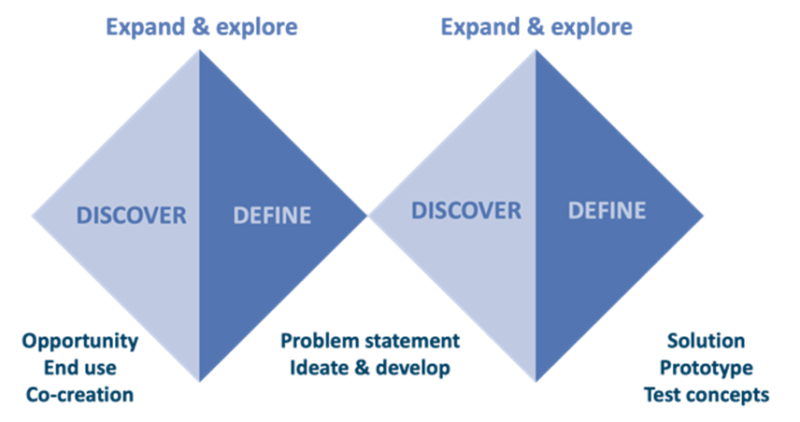
The program emphasizes a comprehensive approach tailored to the pharmaceutical, biotech, and medtech industries, providing participants with tools to navigate industry complexities. By integrating Design Thinking, the workshop fosters creativity and innovation while offering a practical framework to systematically address the growth drivers and barriers, aligning with industry needs for user-centric solutions.
The workshop’s outcome is a strategic growth opportunity map aligned with organizational objectives. This map prioritizes short-term, low-resource expansion prospects, ensuring efficient resource deployment. Through the adoption of a Design Thinking approach, Accelerate Growth delivers practical and strategic insights, equipping participants with skills to drive tangible growth in a competitive landscape. The workshop serves as a catalyst for transformative thinking and action, empowering companies to thrive in the dynamic pharmaceutical, biotech, and medtech sectors.
History
The growth trajectory of the pharmaceutical, medtech, and biotech industries has been marked by a dual approach, combining disruptive innovations with strategic incremental strategies. Disruption, catalyzed by technological breakthroughs and regulatory shifts, has been a pivotal growth source, ushering in personalized medicine and transformative medical technologies. Concurrently, industry leaders have demonstrated the effectiveness of incremental growth through franchise-building strategies. This involves synergistically expanding indications, incorporating new uses for medical devices and drugs, and tapping into diverse patient populations.
Key to sustained success in these industries is the recognition that growth extends beyond traditional boundaries. Companies that excel actively seek inspiration and learning from other industries, incorporating best practices and novel perspectives into their approaches. Additionally, effective lifecycle management plays a central role in unlocking incremental value. Combining both medical and commercial perspectives, companies engage in strategic planning throughout a product’s lifecycle. This involves not only optimizing clinical benefits but also identifying and capitalizing on market opportunities. By proactively managing the entire lifecycle, from development to market maturity, companies ensure that their products evolve in response to changing healthcare landscapes, thereby maximizing their impact and value. In essence, a dynamic interplay between disruptive innovation, strategic incrementalism, cross-industry learning, and comprehensive lifecycle management is imperative for sustained growth and success in these dynamic industries.
Current Position
The pharmaceutical industry finds itself at a crossroads, grappling with productivity challenges such as rising research and development costs and lengthy timelines for drug development. Growth drivers include breakthroughs in biotechnology, the expansion of precision medicine, and increased focus on rare diseases. Leading companies are leveraging innovative technologies like artificial intelligence and data analytics to streamline research processes and enhance decision-making, accelerating their growth cycles. Strategic collaborations, both within and outside the industry, have become pivotal for accessing new technologies and expertise, allowing effective companies to navigate challenges and drive meaningful advancements in drug development.
Biotech companies are experiencing a surge in demand and investor interest, driven by a robust pipeline of novel therapies and advancements in gene and cell therapies. Despite productivity challenges related to the complexity and cost of biologic drug development, the sector benefits from a dynamic ecosystem that fosters innovation. The most effective biotech companies emphasize strategic partnerships, tapping into external expertise, and adopting agile development approaches. They actively explore niche therapeutic areas, harnessing genomic insights to tailor treatments. This flexibility and collaborative mindset enable biotech companies to adapt quickly to evolving scientific landscapes and capitalize on emerging opportunities for growth.
In the medtech industry, the current landscape is marked by a dual focus on technological innovation and value-based healthcare. Productivity challenges include navigating complex regulatory environments and addressing reimbursement uncertainties. Growth drivers involve the integration of digital health solutions, advancements in minimally invasive procedures, and the increasing demand for connected medical devices. The most effective medtech companies are embracing a holistic approach that combines hardware with software and data analytics. They prioritize user-centric design, demonstrating a commitment to improving patient outcomes and enhancing the overall healthcare experience. Strategic acquisitions and partnerships are key tactics employed by successful medtech companies to broaden their portfolios and accelerate growth in an evolving healthcare ecosystem.

Future Outlook
The future outlook for the pharmaceutical industry anticipates a continued emphasis on breakthrough technologies and disruptive treatments. Companies are expected to invest heavily in precision medicine, gene therapies, and advanced biotechnologies. Simultaneously, a relentless focus on incremental growth strategies will persist, driven by optimizing access and reimbursement opportunities. Adapting to local therapeutic standards and navigating the competitive landscape will be crucial, with effective companies leveraging strategic collaborations and digital technologies to maximize growth cycles. Tailoring drug development to niche markets and enhancing portfolio agility will be paramount, allowing pharmaceutical companies to remain agile in an evolving healthcare environment.
For biotech companies, the future holds promise in furthering groundbreaking therapies and personalized medicine. Investments in innovative research and development will remain a priority, with a focus on disruptive treatments such as CRISPR-based technologies and cell therapies. Incremental growth strategies will involve strategic partnerships, acquisitions, and market expansion, optimizing access to reimbursement opportunities. Successful biotech companies will navigate local therapeutic standards and competitive dynamics by continuously adapting to emerging scientific trends and fostering a culture of innovation. Flexibility in responding to evolving market needs will be a hallmark of those poised for sustained growth.

In the medtech sector, the future outlook anticipates a continued integration of breakthrough technologies, especially in the realms of digital health and connected medical devices. Companies will invest in disruptive treatments and technologies that enhance patient outcomes. Incremental growth strategies will involve optimizing access and reimbursement pathways, adhering to local therapeutic standards, and understanding specific competitive landscapes. Effective medtech companies will prioritize user-centric design, strategic collaborations, and data-driven solutions. Harnessing the potential of artificial intelligence and the Internet of Things will be critical for maximizing growth cycles and maintaining a competitive edge in an increasingly complex and interconnected healthcare ecosystem.
Executive Summary

The goal of this workshop is to assist in identifying market and organizational growth drivers and barriers. Select the dominant strategy to follow by starting with the basic options of pursuing distinctiveness or expanding the market. Use technology to break through into new markets, develop new ones, or change ones that already exist thanks to innovative solutions or service integrations that connect existing markets and forge new ones. This strategy has been successfully used by businesses like Genentech to pinpoint and rank expansion prospects for particular brands, franchises, and the company as a whole. Based on the belief that every firm possesses important market insights that may be leveraged to accelerate growth, several avenues for prospective growth are methodically identified and examined. In order to obtain insights into the changing expectations of users and strategies for enhancing their customer experience, we also analyze how the newest technology and information that is readily available to the public are used intelligently.
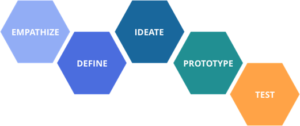
The practical introduction to the Stanford School of Design’s Design Thinking methodology is also included in this subject. The five steps of empathy, definition, ideation, prototyping, and testing are taught to participants. This approach is regularly used by cutting-edge healthcare and IT organizations to generate novel ideas and test them quickly, spurring growth. We establish a strong foundation because this framework will be used throughout the program. This helps create an initial growth opportunity map, concentrating on prospects with short-term effects and low resource requirements. Consequently, this workshop produces an initial list of growth opportunities, arranged based on various standards that correspond to the organization’s aims.

Chapter 1: Market Growth Drivers
This first course of the workshop focuses on the market-driven growth factors in the pharmaceutical, biotech, and medtech industries. The session covers the dynamics that influence market-driven growth, including population growth, aging, demographics, genetics, environmental factors, and lifestyle choices. Participants analyze how these factors impact the needs for tailored medical care and develop an understanding of the implications for tailoring care and increasing access to particular healthcare services.
The session explores the specific competitive setting, in particular entry barriers and how competitors are using them to strengthen and protect their market position. Participants learn about the impact of competition on innovation, collaboration, and the development of cutting-edge services for medical devices and therapeutics. Additionally, participants gain insights into the strategies that local and midsized pharmaceutical and biotech companies can employ to drive growth. Starting with the unmet medical and local needs, they identify market niches and attractive segments, opportunities arising from the local regulatory environment, and forming strategic partnerships with local providers to differentiate their offering.
For the take aways, participants identify the key market-driven growth factors and the most relevant opportunities that they can derive from them. They summarize the short-, medium- and long-term prospects and the expected competitive intensity, laying the foundation to prioritize growth opportunities and pursue long hanging fruit with short term impact in a next step.

Chapter 2: Organizational Growth Drivers
In this course, participants delve into the strategic foundation of organizational growth. This involves the meticulous process of portfolio optimization, aligning resources across diverse products or projects to maximize growth while mitigating risks. A real-world understanding is developed through case studies, emphasizing the agility required to adapt portfolios in response to dynamic market conditions. Additionally, the course explores the critical role of management focus, drawing insights from industry leaders. Novartis, Biogen, and Intuitive Surgical serve as illustrative examples, showcasing the transformative impact of aligning leadership attention with key growth drivers. Participants gain practical insights into fostering innovation and ensuring sustainable growth with a balanced approach that remains adaptable to market shifts.
Market Mastery: Deepening Insights and Leveraging Strengths
Moving beyond foundational principles, the second segment focuses on market mastery through deepening market insights and leveraging competitive strengths. Participants explore strategies employed by industry giants, gaining insights from AstraZeneca, Johnson & Johnson, and Becton Dickinson. The course emphasizes the strategic process of deepening market insights, involving a comprehensive understanding of market dynamics, consumer behavior, and emerging trends. The significance of continuous monitoring and adaptability is underscored. Furthermore, participants learn how successful organizations leverage and refine their competitive strengths, avoiding complacency and ensuring sustained innovation. Practical applications and case studies guide participants in mastering their markets.
Strategic Partnerships and Talent Deployment: Driving Innovation and Growth
The final segment explores the dynamic elements of organizational growth, focusing on identifying partnerships to drive growth and strategically assigning talent. Participants gain insights into successful partnerships exemplified by Sanofi, Biogen, and Medtronic, understanding how external collaborations can accelerate innovation and market reach. The course also dives into the strategic deployment of talent, a critical aspect of driving innovation. Novartis, Biogen, and Intuitive Surgical serve as models for aligning skilled personnel with strategic products, showcasing the impact of targeted talent deployment. Participants work through a strategic toolkit, enabling them to identify internal sources of incremental growth, evaluate these from an end user perspective and identifying the ones with the greatest and sustained differentiation.
Chapter 3: Fundamental Strategic Choices
This course delves into fundamental strategic choices that shape brands and portfolios, navigating the intricate challenges of dynamic industries. Participants explore scenarios where pursuing a market expansion strategy is pivotal. From achieving market leadership to being the sole player in a market or seizing opportunities presented by disruptive therapies, each scenario represents a strategic crossroads. Real-world examples illustrate when and how companies should strategically embark on a market expansion journey, providing participants with actionable insights and a strategic toolkit to foster innovation and navigate the evolving healthcare landscape.
Differentiation Dynamics: Shaping Distinctive Paths in Healthcare
This segment unravels the strategic choice of differentiation, a fundamental decision for companies in pharma, biotech, or medtech. Participants explore scenarios where adopting a differentiation strategy is opportune. Whether not a market leader, entering a market after competition, preparing for new entrants, introducing novel treatments, or addressing challenges in product positioning, each scenario requires a unique approach to carve out a distinctive market position. Real-world examples from Pfizer, Intuitive Surgical, Vertex Pharmaceuticals, Regeneron, and Siemens Healthineers highlight the transformative impact of a well-executed differentiation strategy, guiding participants in crafting strategies that reshape market perceptions and ensure sustained success.
Harmonizing Strategies: Balancing Differentiation and Market Expansion
This course provides participants with insights into the delicate balance between differentiation and market expansion strategies. By exploring scenarios where a mixed differentiation/market expansion strategy is most appropriate, participants gain strategic agility in adapting to dynamic market conditions. From transitioning from differentiation to market expansion when gaining market share to shifting from market expansion to differentiation in response to new competitors, real-world examples from Johnson & Johnson and Philips showcase the nuanced understanding required for strategic transitions. This segment equips participants with the strategic acumen needed to seamlessly navigate a mixed strategy, fostering sustained growth and leadership in the complex healthcare landscape. Working in small groups, participants list the most important strategies of the brands that they work with and the intended focus on differentiation vs. market expansion. Cross-checking the actual investment of resources on tactics that drive differentiation or market expansion ensures that the strategic direction is reflected in the pull through and tactical implementation.
Chapter 4: Design Thinking Methodology
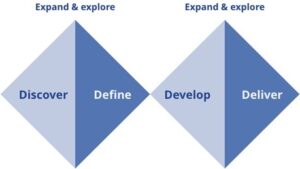
Distinguished by its collaborative, iterative, and empathetic nature, Design Thinking is a human-centered problem-solving methodology that thrives on ambiguity, promoting a mindset fostering creativity, innovation, and a relentless focus on user experience improvement. Its core principles, including empathy, cross-disciplinary collaboration, human-centered problem-solving, tolerance for ambiguity, and iterative prototyping, go beyond aesthetics. Design Thinking aims to address complex problems by uncovering insights, ideating solutions, and prototyping for refinement.
Shaped by thinkers like Herbert Simon and design firms such as IDEO, Design Thinking’s evolution spans decades, rooted in early design processes. The term gained prominence in the 20th century, and the 1990s marked a significant period with IDEO emphasizing human-centered design. Stanford’s d.school played a key role in popularizing Design Thinking, offering a structured yet flexible guide through its framework—empathize, define, ideate, prototype, and test. This systematic approach solidified Stanford’s role in development.
Revolutionizing problem-solving in Pharma, Biotech, and Medtech, Design Thinking is evident in patient-centric solutions. In Pharma, empathetic patient understanding, as seen in Eli Lilly’s connected insulin pen, transforms the landscape. Biotech focuses on patient-centric therapies, exemplified by Genentech’s personalized medicine. Medtech emphasizes user-centered design, as showcased by Medtronic’s minimally invasive surgical tools. Design Thinking ensures a deep understanding of end-users, leading to innovative and patient-friendly solutions in these sectors.
Pivotal for Design Thinking projects’ success, critical factors such as empathy, cross-disciplinary collaboration, iterative prototyping, a cultivated design mindset, user-centric ideation, openness to ambiguity, executive support, and organizational integration play crucial roles. In a practical application of these principles, the workshop task mirrors the real-world challenge of identifying and prioritizing growth possibilities. Participants collaboratively list and prioritize their organization’s five critical growth opportunities, applying Design Thinking principles to instill learning through practical, hands-on experience and reinforcing the methodology’s core concepts.

Chapter 5: Empathy With Customers
Empathizing stands as the foundational step in Design Thinking, forging a deep connection with end-users by understanding their needs and experiences. This multifaceted phase involves observation, engagement, immersion, and discovering emotions that drive behavior. By cultivating a human-centered approach, designers move beyond assumptions and iteratively empathize throughout the entire Design Thinking journey, ensuring continuous refinement based on user feedback.
Assuming a beginner’s mindset, integral to empathizing, involves shedding biases and approaching problems with fresh eyes. Embracing principles like non-judgment, questioning everything, genuine curiosity, finding patterns, and deep listening fosters creativity and prevents assumptions. The “What, How, Why” framework adds a structured approach to gather insights systematically, enhancing communication, and providing a holistic understanding of user experiences. This framework structures the empathizing process by exploring observable behaviors, process and interaction, and underlying motivations. The approach cultivates fresh perspectives, avoids assumptions, ensures a holistic understanding, and enhances communication between designers and users. It also adds depth to the designer’s understanding by providing a comprehensive view of user actions, interactions, and motivations.
To summarize findings, participants transition raw observations into cohesive stories, fostering empathy within the team. Sharing and capturing these narratives ensure effective communication of insights. Deepening the end user journey map involves tracing the entire user experience, identifying touchpoints, patterns, and anomalies. This comprehensive map guides the design process with precision and relevance, shaping subsequent stages. In the workshop, participants review current customer journey maps, putting themselves in various roles, and identify 2-3 priority moments for in-depth exploration. This practical application reinforces the empathetic principles learned, offering a hands-on experience and preparing participants for the next steps.

Chapter 6: Define The Challenge
The Define mode is a pivotal stage in Design Thinking, where insights from empathetic exploration are synthesized into a clear problem statement. This phase involves activities like affinity mapping and prioritization to structure and articulate the problem. Industry-specific examples illustrate how challenges are reframed for a human-centered approach. The desired output is a well-crafted Point of View (POV) statement that acts as a compass for subsequent ideation and prototyping.
The Powers of Ten approach explores the problem space at different scales, magnifying or narrowing focus for deeper insights. It involves magnifying the problem space, narrowing the focus, applying constraints, and iterative exploration. The approach ensures a comprehensive understanding, identifies patterns, aids informed decision-making, and integrates creativity with constraints. The 2×2 matrix organizes and visualizes data, mapping items along two dimensions to analyze and prioritize actions. Steps include selecting dimensions, mapping items, gaining insights, and prioritizing. The matrix offers visual clarity, aids in pattern recognition, guides informed decision-making, and facilitates collaborative analysis. The Why-How Ladder is a structured approach to uncovering user needs and motivations, guiding solution development. Steps involve starting with meaningful user needs, asking why iteratively, reaching fundamental needs, and reversing the process by asking how. Benefits include a deeper understanding, identification of fundamental needs, systematic solution generation, and user-centric solutions.
Creating a Point of View Statement: Crafting a POV statement in the Define mode involves using vivid language, adding details, incorporating surprise moments, sharing perspective shifts, and identifying a major cause for change. A compelling POV statement inspires ideation, maintains a user-centric focus, engages with empathy, and guides solution development. In the workshop, participants select a growth opportunity, develop a Why-How ladder, and use it to formulate a POV statement. This practical application reinforces the principles learned, encouraging a hands-on exploration of a growth opportunity and translating it into a human-centered problem statement.

Chapter 7: Ideation
In the Ideate mode of Design Thinking, the focus is on generating innovative ideas to address identified problems. Key strategies involve driving innovation, uncovering unexpected areas, creating fluency and flexibility, fluctuating between focus and flare, going wide during idea generation, and postponing evaluation until later in the process. The benefits of collective ideation include diverse perspectives, innovation, exploration of outlandish ideas, a comprehensive idea pool, and fostering a positive team dynamic.
Stoke Activities to Loosen Up and Focus: these activities are employed to foster a creative and open-minded mindset within the team. These activities serve the dual purpose of loosening up team members and enhancing focus on generating innovative ideas. Effective stoke activities include improv games, mindfulness exercises, creative icebreakers, and a change of environment. The benefits include increased creativity, improved focus, elevated team morale, reduced inhibition, and enhanced team dynamics.
Facilitation of brainstorming sessions in the Ideate mode is crucial for stimulating creativity, encouraging collaboration, and fostering an open-minded environment. Techniques like the “No Yes, But” approach, setting clear goals, managing energy, introducing strategic constraints, creating physical and mental space, and incorporating various brainstorming techniques contribute to an effective facilitation. The benefits include cultivating diverse ideas, creating a positive and inclusive atmosphere, maintaining continuous momentum, and fostering positive team dynamics. Selecting brainstormed ideas involves methodologies such as post-it voting, categorization into four groups, using tools like Bingo, and evaluating ideas based on digital, physical, or experiential prototype suitability. Key considerations include feasibility, alignment with project objectives, innovation potential, and user-centricity. Benefits of diverse methodologies include inclusive decision-making, engagement and creativity, systematic evaluation, and targeted prototyping.
In the hands-on workshop, teams select growth opportunities, engage in activities to loosen up, brainstorm ideas, and prioritize these. The teams use different methodologies and review their respective experiences and feelings during the brainstorming and the prioritizing process. This practical exercise reinforces the principles of ideation and selection learned in the course curriculum.

Chapter 8: Prototype
In the Prototype mode of Design Thinking, designers transform abstract ideas into tangible manifestations, fostering empathy and understanding. Prototyping for empathy involves creating representations that bridge the gap between designers and users, facilitating a deeper connection. Through sketching, playing, and simulating, designers bring concepts to life, enabling users to interact with prototypes for valuable insights.
Sketch, Play, and Simulate to Prototype for Empathy: In this phase, designers utilize sketching to visually communicate design concepts, playing to incorporate interactive elements, and simulating to recreate scenes with necessary props and roles. These activities aim to create prototypes that resonate with users emotionally and functionally. The process is iterative, encouraging creativity and exploration in translating ideas into tangible forms. Testing prototypes with users is a pivotal step to refine and optimize designs. By presenting users with different prototypes and allowing interaction, designers gather valuable feedback. This testing phase aids in deciding between various ideas, refining the chosen concept, and validating design assumptions. User involvement is key to shaping prototypes based on preferences, needs, and behaviors.
Experience rapid prototyping for a selected growth opportunity, providing participants with a hands-on understanding of both the power and challenges of this process. Through ideation, sketching, playing, and simulating, participants collaboratively develop a rapid prototype. This immersive experience allows individuals to comprehend the iterative nature of design thinking, emphasizing the role of prototypes in refining and optimizing solutions.

Chapter 9: Test And Iterative Learning
In the fifth step of Design Thinking, the focus is on testing to gain deeper insights into user needs, refine prototypes and solutions, and iterate on the initial point of view. Testing serves as a crucial means to validate assumptions and enhance the understanding of user preferences and behaviors. This iterative process ensures that designs are user-centric, refining and optimizing solutions based on real-world feedback.
Feedback Capture Matrix for Comprehensive Insights: A Feedback Capture Matrix is employed during testing to systematically gather insights. This matrix categorizes feedback into preferred functionalities and features (likes), constructive criticism (wishes), questions arising during testing, and new ideas. This comprehensive approach helps in capturing diverse perspectives, ensuring that the testing phase provides rich and multifaceted insights for further refinement. Testing insights play a pivotal role in refining the storytelling process. The course emphasizes combining empathy, insights, prototypes, and learnings from testing to craft a compelling narrative. By integrating these elements, designers develop a cohesive story for the identified growth opportunity, highlighting the impact on the end user. The storytelling process becomes a powerful tool for conveying the essence of the design solution and its meaningful implications.
Video Summary for Effective Communication: To support project communication and mobilization, participants learn to develop a video summary of the story. This step involves capturing the essence of the design solution with intent, aiming for a specific impact among the target audience. The video summary serves as a concise and engaging medium to convey the journey, insights, and transformative potential of the prioritized growth opportunity. As part of the course, participants develop a testing plan specifically tailored to the prioritized growth opportunity. This hands-on experience equips them with the skills to structure and implement effective testing strategies.

Chapter 10: Develop A Portfolio Of Growth Projects
leveraging the insights into market-driven and organizational sources of growth. Building on the foundation of the Design Thinking methodology, participants consolidate a comprehensive list of potential growth ideas. This strategic ideation process involves synthesizing market trends, organizational strengths, and user needs to identify promising avenues for growth. The process builds on what is known based on primary and secondary market research, quantitative and qualitative information about the Needs, Wants and Fears of market participants. The data is consolidated into key insights and supports formulating the main challenge. For each growth idea generated, participants develop a compelling Point of View (POV) statement. These statements serve as concise and impactful narratives that encapsulate the essence of each growth idea. Crafting persuasive POV statements is a critical step to ensure clarity, alignment, and a human-centered focus, setting the stage for effective communication and decision-making.
Stakeholder Validation for Informed Decision-Making: the stakeholder perspective is a crucial checkpoint in identifying and confirming growth projects. Participants view the list of growth ideas from the perspective of key stakeholders, including patients, caregivers, and healthcare professionals. Specifically, they seed solutions that reduce the negative experience, increase the focus on the positive, question assumptions, explore opposites and identify unexpected resources. This validation process ensures that the proposed growth projects resonate with the diverse needs and expectations of stakeholders, hence contributing to informed decision-making and strategic alignment. The output is a first list of growth opportunities, arranged along the customer journey to keep the user experience at the center.

Chapter 11: Create A Growth Opportunity Map
In this course, participants are guided through the process of developing a growth opportunity map for a portfolio of projects. The first step involves defining users and customers, leveraging insights gained from empathetic exploration, and aligning them with the problem description and current solutions. A crucial aspect is the identification and articulation of the business challenge, paving the way for a comprehensive understanding of the problem space.
The course delves into the envisioning of an improved future solution, detailing its functionalities and how users will interact with it. Strategies for adoption are specified, along with key user metrics essential for tracking progress. Budget and resource assessments are conducted for both short and long-term perspectives, ensuring a realistic and sustainable approach. The measurement of business benefits, including early indicators, is outlined, providing a robust framework for evaluating project success. Opportunity mapping offers a multifaceted approach to strategic planning with several advantages. It serves as a powerful tool for uncovering hidden growth opportunities, enabling organizations to unearth potential avenues for development that may not be immediately evident. Moreover, the process facilitates the prioritization of growth initiatives, ensuring that efforts are strategically aligned and resources are efficiently utilized. The practice also nurtures a culture of innovation within the organization, encouraging teams to think creatively and explore novel solutions. By aligning teams with strategic goals, opportunity mapping ensures that projects are cohesive and contribute meaningfully to overarching objectives. Additionally, it enhances organizational adaptability and agility, fostering a dynamic environment that can respond effectively to evolving market conditions. However, challenges such as data overload, stakeholder alignment, continuous adaptation, resource allocation, and ensuring objectivity must be navigated to maximize the benefits of this strategic approach.
Participants create a list of growth opportunities and characterize them based on vital criteria such as contribution to the topline and bottom-line impact over a specified time horizon. They select 2-4 key dimensions, typically involving sales contribution, required resources, and time horizon to lay a solid foundation for assessing and prioritizing growth opportunities.

Chapter 12: Prioritize Short Term And Low Resource Requirements
The primary objective of this course is to equip participants with the skills and knowledge necessary to effectively rank and prioritize various growth opportunities. Understanding the significance of making strategic decisions in resource allocation, several methodologies are reviewed to streamline the prioritization process of growth opportunities. One such method introduced is the RICE framework, which assesses opportunities based on their Reach, Impact, Confidence, and Effort required for implementation. The Urgent/Important Matrix, commonly known as the Eisenhower Matrix, offers a simple yet powerful approach by categorizing tasks into four quadrants to prioritize based on urgency and importance. Participants also explore the ICE method, evaluating opportunities based on their Impact, Confidence, and Ease of execution. The Value/Complexity Matrix provides a visual tool for mapping opportunities along two dimensions, allowing for a nuanced assessment. Additionally, the course covers the Weighted Scoring technique, which involves assigning weights to different dimensions for a comprehensive evaluation.
Using the Weighted Scoring methodology, participants consider apply the key criteria to evaluate the growth opportunities: the magnitude of impact on the topline, capturing the potential revenue growth each opportunity generates. The second criterion revolves around the effort and complexity required for execution, accounting for the practical challenges and resources needed. The third key criterion is the time horizon of impact, when the effects of pursuing a particular opportunity are expected to materialize. Additional and optional criteria such as portfolio synergies or competitive differentiation can be included.
During the workshop task, participants engage in hands-on application of the Weighted Scoring methodology. They create a table listing the identified growth opportunities and define clear thresholds for each key dimension. Assigning values to each growth opportunity based on the criteria of impact, effort, complexity, and time horizon, participants prioritize opportunities with a focus on short-term impact and low resource requirements. The objective is to identify the top 1-3 most attractive opportunities to pursue. Specific budget and internal Full-Time Equivalents (FTE) are projected to support informed decision making and alignment with the organizational goals.
Curriculum
Accelerate Growth – Workshop 1 – Growth Sources
- Market Growth Drivers
- Organizational Growth Drivers
- Fundamental Strategic Choices
- Design Thinking Methodology
- Empathy With Customers
- Define The Challenge
- Ideation
- Prototype
- Test
- Develop A Portfolio Of Growth Projects
- Create A Growth Opportunity Map
- Prioritize Short Term And Low Resource Requirements
Distance Learning
Introduction
Welcome to Appleton Greene and thank you for enrolling on the Accelerate Growth corporate training program. You will be learning through our unique facilitation via distance-learning method, which will enable you to practically implement everything that you learn academically. The methods and materials used in your program have been designed and developed to ensure that you derive the maximum benefits and enjoyment possible. We hope that you find the program challenging and fun to do. However, if you have never been a distance-learner before, you may be experiencing some trepidation at the task before you. So we will get you started by giving you some basic information and guidance on how you can make the best use of the modules, how you should manage the materials and what you should be doing as you work through them. This guide is designed to point you in the right direction and help you to become an effective distance-learner. Take a few hours or so to study this guide and your guide to tutorial support for students, while making notes, before you start to study in earnest.
Study environment
You will need to locate a quiet and private place to study, preferably a room where you can easily be isolated from external disturbances or distractions. Make sure the room is well-lit and incorporates a relaxed, pleasant feel. If you can spoil yourself within your study environment, you will have much more of a chance to ensure that you are always in the right frame of mind when you do devote time to study. For example, a nice fire, the ability to play soft soothing background music, soft but effective lighting, perhaps a nice view if possible and a good size desk with a comfortable chair. Make sure that your family know when you are studying and understand your study rules. Your study environment is very important. The ideal situation, if at all possible, is to have a separate study, which can be devoted to you. If this is not possible then you will need to pay a lot more attention to developing and managing your study schedule, because it will affect other people as well as yourself. The better your study environment, the more productive you will be.
Study tools & rules
Try and make sure that your study tools are sufficient and in good working order. You will need to have access to a computer, scanner and printer, with access to the internet. You will need a very comfortable chair, which supports your lower back, and you will need a good filing system. It can be very frustrating if you are spending valuable study time trying to fix study tools that are unreliable, or unsuitable for the task. Make sure that your study tools are up to date. You will also need to consider some study rules. Some of these rules will apply to you and will be intended to help you to be more disciplined about when and how you study. This distance-learning guide will help you and after you have read it you can put some thought into what your study rules should be. You will also need to negotiate some study rules for your family, friends or anyone who lives with you. They too will need to be disciplined in order to ensure that they can support you while you study. It is important to ensure that your family and friends are an integral part of your study team. Having their support and encouragement can prove to be a crucial contribution to your successful completion of the program. Involve them in as much as you can.
Successful distance-learning
Distance-learners are freed from the necessity of attending regular classes or workshops, since they can study in their own way, at their own pace and for their own purposes. But unlike traditional internal training courses, it is the student’s responsibility, with a distance-learning program, to ensure that they manage their own study contribution. This requires strong self-discipline and self-motivation skills and there must be a clear will to succeed. Those students who are used to managing themselves, are good at managing others and who enjoy working in isolation, are more likely to be good distance-learners. It is also important to be aware of the main reasons why you are studying and of the main objectives that you are hoping to achieve as a result. You will need to remind yourself of these objectives at times when you need to motivate yourself. Never lose sight of your long-term goals and your short-term objectives. There is nobody available here to pamper you, or to look after you, or to spoon-feed you with information, so you will need to find ways to encourage and appreciate yourself while you are studying. Make sure that you chart your study progress, so that you can be sure of your achievements and re-evaluate your goals and objectives regularly.
Self-assessment
Appleton Greene training programs are in all cases post-graduate programs. Consequently, you should already have obtained a business-related degree and be an experienced learner. You should therefore already be aware of your study strengths and weaknesses. For example, which time of the day are you at your most productive? Are you a lark or an owl? What study methods do you respond to the most? Are you a consistent learner? How do you discipline yourself? How do you ensure that you enjoy yourself while studying? It is important to understand yourself as a learner and so some self-assessment early on will be necessary if you are to apply yourself correctly. Perform a SWOT analysis on yourself as a student. List your internal strengths and weaknesses as a student and your external opportunities and threats. This will help you later on when you are creating a study plan. You can then incorporate features within your study plan that can ensure that you are playing to your strengths, while compensating for your weaknesses. You can also ensure that you make the most of your opportunities, while avoiding the potential threats to your success.
Accepting responsibility as a student
Training programs invariably require a significant investment, both in terms of what they cost and in the time that you need to contribute to study and the responsibility for successful completion of training programs rests entirely with the student. This is never more apparent than when a student is learning via distance-learning. Accepting responsibility as a student is an important step towards ensuring that you can successfully complete your training program. It is easy to instantly blame other people or factors when things go wrong. But the fact of the matter is that if a failure is your failure, then you have the power to do something about it, it is entirely in your own hands. If it is always someone else’s failure, then you are powerless to do anything about it. All students study in entirely different ways, this is because we are all individuals and what is right for one student, is not necessarily right for another. In order to succeed, you will have to accept personal responsibility for finding a way to plan, implement and manage a personal study plan that works for you. If you do not succeed, you only have yourself to blame.
Planning
By far the most critical contribution to stress, is the feeling of not being in control. In the absence of planning we tend to be reactive and can stumble from pillar to post in the hope that things will turn out fine in the end. Invariably they don’t! In order to be in control, we need to have firm ideas about how and when we want to do things. We also need to consider as many possible eventualities as we can, so that we are prepared for them when they happen. Prescriptive Change, is far easier to manage and control, than Emergent Change. The same is true with distance-learning. It is much easier and much more enjoyable, if you feel that you are in control and that things are going to plan. Even when things do go wrong, you are prepared for them and can act accordingly without any unnecessary stress. It is important therefore that you do take time to plan your studies properly.
Management
Once you have developed a clear study plan, it is of equal importance to ensure that you manage the implementation of it. Most of us usually enjoy planning, but it is usually during implementation when things go wrong. Targets are not met and we do not understand why. Sometimes we do not even know if targets are being met. It is not enough for us to conclude that the study plan just failed. If it is failing, you will need to understand what you can do about it. Similarly if your study plan is succeeding, it is still important to understand why, so that you can improve upon your success. You therefore need to have guidelines for self-assessment so that you can be consistent with performance improvement throughout the program. If you manage things correctly, then your performance should constantly improve throughout the program.
Study objectives & tasks
The first place to start is developing your program objectives. These should feature your reasons for undertaking the training program in order of priority. Keep them succinct and to the point in order to avoid confusion. Do not just write the first things that come into your head because they are likely to be too similar to each other. Make a list of possible departmental headings, such as: Customer Service; E-business; Finance; Globalization; Human Resources; Technology; Legal; Management; Marketing and Production. Then brainstorm for ideas by listing as many things that you want to achieve under each heading and later re-arrange these things in order of priority. Finally, select the top item from each department heading and choose these as your program objectives. Try and restrict yourself to five because it will enable you to focus clearly. It is likely that the other things that you listed will be achieved if each of the top objectives are achieved. If this does not prove to be the case, then simply work through the process again.
Study forecast
As a guide, the Appleton Greene Accelerate Growth corporate training program should take 12-18 months to complete, depending upon your availability and current commitments. The reason why there is such a variance in time estimates is because every student is an individual, with differing productivity levels and different commitments. These differentiations are then exaggerated by the fact that this is a distance-learning program, which incorporates the practical integration of academic theory as an as a part of the training program. Consequently all of the project studies are real, which means that important decisions and compromises need to be made. You will want to get things right and will need to be patient with your expectations in order to ensure that they are. We would always recommend that you are prudent with your own task and time forecasts, but you still need to develop them and have a clear indication of what are realistic expectations in your case. With reference to your time planning: consider the time that you can realistically dedicate towards study with the program every week; calculate how long it should take you to complete the program, using the guidelines featured here; then break the program down into logical modules and allocate a suitable proportion of time to each of them, these will be your milestones; you can create a time plan by using a spreadsheet on your computer, or a personal organizer such as MS Outlook, you could also use a financial forecasting software; break your time forecasts down into manageable chunks of time, the more specific you can be, the more productive and accurate your time management will be; finally, use formulas where possible to do your time calculations for you, because this will help later on when your forecasts need to change in line with actual performance. With reference to your task planning: refer to your list of tasks that need to be undertaken in order to achieve your program objectives; with reference to your time plan, calculate when each task should be implemented; remember that you are not estimating when your objectives will be achieved, but when you will need to focus upon implementing the corresponding tasks; you also need to ensure that each task is implemented in conjunction with the associated training modules which are relevant; then break each single task down into a list of specific to do’s, say approximately ten to do’s for each task and enter these into your study plan; once again you could use MS Outlook to incorporate both your time and task planning and this could constitute your study plan; you could also use a project management software like MS Project. You should now have a clear and realistic forecast detailing when you can expect to be able to do something about undertaking the tasks to achieve your program objectives.
Performance management
It is one thing to develop your study forecast, it is quite another to monitor your progress. Ultimately it is less important whether you achieve your original study forecast and more important that you update it so that it constantly remains realistic in line with your performance. As you begin to work through the program, you will begin to have more of an idea about your own personal performance and productivity levels as a distance-learner. Once you have completed your first study module, you should re-evaluate your study forecast for both time and tasks, so that they reflect your actual performance level achieved. In order to achieve this you must first time yourself while training by using an alarm clock. Set the alarm for hourly intervals and make a note of how far you have come within that time. You can then make a note of your actual performance on your study plan and then compare your performance against your forecast. Then consider the reasons that have contributed towards your performance level, whether they are positive or negative and make a considered adjustment to your future forecasts as a result. Given time, you should start achieving your forecasts regularly.
With reference to time management: time yourself while you are studying and make a note of the actual time taken in your study plan; consider your successes with time-efficiency and the reasons for the success in each case and take this into consideration when reviewing future time planning; consider your failures with time-efficiency and the reasons for the failures in each case and take this into consideration when reviewing future time planning; re-evaluate your study forecast in relation to time planning for the remainder of your training program to ensure that you continue to be realistic about your time expectations. You need to be consistent with your time management, otherwise you will never complete your studies. This will either be because you are not contributing enough time to your studies, or you will become less efficient with the time that you do allocate to your studies. Remember, if you are not in control of your studies, they can just become yet another cause of stress for you.
With reference to your task management: time yourself while you are studying and make a note of the actual tasks that you have undertaken in your study plan; consider your successes with task-efficiency and the reasons for the success in each case; take this into consideration when reviewing future task planning; consider your failures with task-efficiency and the reasons for the failures in each case and take this into consideration when reviewing future task planning; re-evaluate your study forecast in relation to task planning for the remainder of your training program to ensure that you continue to be realistic about your task expectations. You need to be consistent with your task management, otherwise you will never know whether you are achieving your program objectives or not.
Keeping in touch
You will have access to qualified and experienced professors and tutors who are responsible for providing tutorial support for your particular training program. So don’t be shy about letting them know how you are getting on. We keep electronic records of all tutorial support emails so that professors and tutors can review previous correspondence before considering an individual response. It also means that there is a record of all communications between you and your professors and tutors and this helps to avoid any unnecessary duplication, misunderstanding, or misinterpretation. If you have a problem relating to the program, share it with them via email. It is likely that they have come across the same problem before and are usually able to make helpful suggestions and steer you in the right direction. To learn more about when and how to use tutorial support, please refer to the Tutorial Support section of this student information guide. This will help you to ensure that you are making the most of tutorial support that is available to you and will ultimately contribute towards your success and enjoyment with your training program.
Work colleagues and family
You should certainly discuss your program study progress with your colleagues, friends and your family. Appleton Greene training programs are very practical. They require you to seek information from other people, to plan, develop and implement processes with other people and to achieve feedback from other people in relation to viability and productivity. You will therefore have plenty of opportunities to test your ideas and enlist the views of others. People tend to be sympathetic towards distance-learners, so don’t bottle it all up in yourself. Get out there and share it! It is also likely that your family and colleagues are going to benefit from your labors with the program, so they are likely to be much more interested in being involved than you might think. Be bold about delegating work to those who might benefit themselves. This is a great way to achieve understanding and commitment from people who you may later rely upon for process implementation. Share your experiences with your friends and family.
Making it relevant
The key to successful learning is to make it relevant to your own individual circumstances. At all times you should be trying to make bridges between the content of the program and your own situation. Whether you achieve this through quiet reflection or through interactive discussion with your colleagues, client partners or your family, remember that it is the most important and rewarding aspect of translating your studies into real self-improvement. You should be clear about how you want the program to benefit you. This involves setting clear study objectives in relation to the content of the course in terms of understanding, concepts, completing research or reviewing activities and relating the content of the modules to your own situation. Your objectives may understandably change as you work through the program, in which case you should enter the revised objectives on your study plan so that you have a permanent reminder of what you are trying to achieve, when and why.
Distance-learning check-list
Prepare your study environment, your study tools and rules.
Undertake detailed self-assessment in terms of your ability as a learner.
Create a format for your study plan.
Consider your study objectives and tasks.
Create a study forecast.
Assess your study performance.
Re-evaluate your study forecast.
Be consistent when managing your study plan.
Use your Appleton Greene Certified Learning Provider (CLP) for tutorial support.
Make sure you keep in touch with those around you.

Tutorial Support
Programs
Appleton Greene uses standard and bespoke corporate training programs as vessels to transfer business process improvement knowledge into the heart of our clients’ organizations. Each individual program focuses upon the implementation of a specific business process, which enables clients to easily quantify their return on investment. There are hundreds of established Appleton Greene corporate training products now available to clients within customer services, e-business, finance, globalization, human resources, information technology, legal, management, marketing and production. It does not matter whether a client’s employees are located within one office, or an unlimited number of international offices, we can still bring them together to learn and implement specific business processes collectively. Our approach to global localization enables us to provide clients with a truly international service with that all important personal touch. Appleton Greene corporate training programs can be provided virtually or locally and they are all unique in that they individually focus upon a specific business function. They are implemented over a sustainable period of time and professional support is consistently provided by qualified learning providers and specialist consultants.
Support available
You will have a designated Certified Learning Provider (CLP) and an Accredited Consultant and we encourage you to communicate with them as much as possible. In all cases tutorial support is provided online because we can then keep a record of all communications to ensure that tutorial support remains consistent. You would also be forwarding your work to the tutorial support unit for evaluation and assessment. You will receive individual feedback on all of the work that you undertake on a one-to-one basis, together with specific recommendations for anything that may need to be changed in order to achieve a pass with merit or a pass with distinction and you then have as many opportunities as you may need to re-submit project studies until they meet with the required standard. Consequently the only reason that you should really fail (CLP) is if you do not do the work. It makes no difference to us whether a student takes 12 months or 18 months to complete the program, what matters is that in all cases the same quality standard will have been achieved.
Support Process
Please forward all of your future emails to the designated (CLP) Tutorial Support Unit email address that has been provided and please do not duplicate or copy your emails to other AGC email accounts as this will just cause unnecessary administration. Please note that emails are always answered as quickly as possible but you will need to allow a period of up to 20 business days for responses to general tutorial support emails during busy periods, because emails are answered strictly within the order in which they are received. You will also need to allow a period of up to 30 business days for the evaluation and assessment of project studies. This does not include weekends or public holidays. Please therefore kindly allow for this within your time planning. All communications are managed online via email because it enables tutorial service support managers to review other communications which have been received before responding and it ensures that there is a copy of all communications retained on file for future reference. All communications will be stored within your personal (CLP) study file here at Appleton Greene throughout your designated study period. If you need any assistance or clarification at any time, please do not hesitate to contact us by forwarding an email and remember that we are here to help. If you have any questions, please list and number your questions succinctly and you can then be sure of receiving specific answers to each and every query.
Time Management
It takes approximately 1 Year to complete the Accelerate Growth corporate training program, incorporating 12 x 6-hour monthly workshops. Each student will also need to contribute approximately 4 hours per week over 1 Year of their personal time. Students can study from home or work at their own pace and are responsible for managing their own study plan. There are no formal examinations and students are evaluated and assessed based upon their project study submissions, together with the quality of their internal analysis and supporting documents. They can contribute more time towards study when they have the time to do so and can contribute less time when they are busy. All students tend to be in full time employment while studying and the Accelerate Growth program is purposely designed to accommodate this, so there is plenty of flexibility in terms of time management. It makes no difference to us at Appleton Greene, whether individuals take 12-18 months to complete this program. What matters is that in all cases the same standard of quality will have been achieved with the standard and bespoke programs that have been developed.
Distance Learning Guide
The distance learning guide should be your first port of call when starting your training program. It will help you when you are planning how and when to study, how to create the right environment and how to establish the right frame of mind. If you can lay the foundations properly during the planning stage, then it will contribute to your enjoyment and productivity while training later. The guide helps to change your lifestyle in order to accommodate time for study and to cultivate good study habits. It helps you to chart your progress so that you can measure your performance and achieve your goals. It explains the tools that you will need for study and how to make them work. It also explains how to translate academic theory into practical reality. Spend some time now working through your distance learning guide and make sure that you have firm foundations in place so that you can make the most of your distance learning program. There is no requirement for you to attend training workshops or classes at Appleton Greene offices. The entire program is undertaken online, program course manuals and project studies are administered via the Appleton Greene web site and via email, so you are able to study at your own pace and in the comfort of your own home or office as long as you have a computer and access to the internet.
How To Study
The how to study guide provides students with a clear understanding of the Appleton Greene facilitation via distance learning training methods and enables students to obtain a clear overview of the training program content. It enables students to understand the step-by-step training methods used by Appleton Greene and how course manuals are integrated with project studies. It explains the research and development that is required and the need to provide evidence and references to support your statements. It also enables students to understand precisely what will be required of them in order to achieve a pass with merit and a pass with distinction for individual project studies and provides useful guidance on how to be innovative and creative when developing your Unique Program Proposition (UPP).
Tutorial Support
Tutorial support for the Appleton Greene Accelerate Growth corporate training program is provided online either through the Appleton Greene Client Support Portal (CSP), or via email. All tutorial support requests are facilitated by a designated Program Administration Manager (PAM). They are responsible for deciding which professor or tutor is the most appropriate option relating to the support required and then the tutorial support request is forwarded onto them. Once the professor or tutor has completed the tutorial support request and answered any questions that have been asked, this communication is then returned to the student via email by the designated Program Administration Manager (PAM). This enables all tutorial support, between students, professors and tutors, to be facilitated by the designated Program Administration Manager (PAM) efficiently and securely through the email account. You will therefore need to allow a period of up to 20 business days for responses to general support queries and up to 30 business days for the evaluation and assessment of project studies, because all tutorial support requests are answered strictly within the order in which they are received. This does not include weekends or public holidays. Consequently you need to put some thought into the management of your tutorial support procedure in order to ensure that your study plan is feasible and to obtain the maximum possible benefit from tutorial support during your period of study. Please retain copies of your tutorial support emails for future reference. Please ensure that ALL of your tutorial support emails are set out using the format as suggested within your guide to tutorial support. Your tutorial support emails need to be referenced clearly to the specific part of the course manual or project study which you are working on at any given time. You also need to list and number any questions that you would like to ask, up to a maximum of five questions within each tutorial support email. Remember the more specific you can be with your questions the more specific your answers will be too and this will help you to avoid any unnecessary misunderstanding, misinterpretation, or duplication. The guide to tutorial support is intended to help you to understand how and when to use support in order to ensure that you get the most out of your training program. Appleton Greene training programs are designed to enable you to do things for yourself. They provide you with a structure or a framework and we use tutorial support to facilitate students while they practically implement what they learn. In other words, we are enabling students to do things for themselves. The benefits of distance learning via facilitation are considerable and are much more sustainable in the long-term than traditional short-term knowledge sharing programs. Consequently you should learn how and when to use tutorial support so that you can maximize the benefits from your learning experience with Appleton Greene. This guide describes the purpose of each training function and how to use them and how to use tutorial support in relation to each aspect of the training program. It also provides useful tips and guidance with regard to best practice.
Tutorial Support Tips
Students are often unsure about how and when to use tutorial support with Appleton Greene. This Tip List will help you to understand more about how to achieve the most from using tutorial support. Refer to it regularly to ensure that you are continuing to use the service properly. Tutorial support is critical to the success of your training experience, but it is important to understand when and how to use it in order to maximize the benefit that you receive. It is no coincidence that those students who succeed are those that learn how to be positive, proactive and productive when using tutorial support.
Be positive and friendly with your tutorial support emails
Remember that if you forward an email to the tutorial support unit, you are dealing with real people. “Do unto others as you would expect others to do unto you”. If you are positive, complimentary and generally friendly in your emails, you will generate a similar response in return. This will be more enjoyable, productive and rewarding for you in the long-term.
Think about the impression that you want to create
Every time that you communicate, you create an impression, which can be either positive or negative, so put some thought into the impression that you want to create. Remember that copies of all tutorial support emails are stored electronically and tutors will always refer to prior correspondence before responding to any current emails. Over a period of time, a general opinion will be arrived at in relation to your character, attitude and ability. Try to manage your own frustrations, mood swings and temperament professionally, without involving the tutorial support team. Demonstrating frustration or a lack of patience is a weakness and will be interpreted as such. The good thing about communicating in writing, is that you will have the time to consider your content carefully, you can review it and proof-read it before sending your email to Appleton Greene and this should help you to communicate more professionally, consistently and to avoid any unnecessary knee-jerk reactions to individual situations as and when they may arise. Please also remember that the CLP Tutorial Support Unit will not just be responsible for evaluating and assessing the quality of your work, they will also be responsible for providing recommendations to other learning providers and to client contacts within the Appleton Greene global client network, so do be in control of your own emotions and try to create a good impression.
Remember that quality is preferred to quantity
Please remember that when you send an email to the tutorial support team, you are not using Twitter or Text Messaging. Try not to forward an email every time that you have a thought. This will not prove to be productive either for you or for the tutorial support team. Take time to prepare your communications properly, as if you were writing a professional letter to a business colleague and make a list of queries that you are likely to have and then incorporate them within one email, say once every month, so that the tutorial support team can understand more about context, application and your methodology for study. Get yourself into a consistent routine with your tutorial support requests and use the tutorial support template provided with ALL of your emails. The (CLP) Tutorial Support Unit will not spoon-feed you with information. They need to be able to evaluate and assess your tutorial support requests carefully and professionally.
Be specific about your questions in order to receive specific answers
Try not to write essays by thinking as you are writing tutorial support emails. The tutorial support unit can be unclear about what in fact you are asking, or what you are looking to achieve. Be specific about asking questions that you want answers to. Number your questions. You will then receive specific answers to each and every question. This is the main purpose of tutorial support via email.
Keep a record of your tutorial support emails
It is important that you keep a record of all tutorial support emails that are forwarded to you. You can then refer to them when necessary and it avoids any unnecessary duplication, misunderstanding, or misinterpretation.
Individual training workshops or telephone support
Please be advised that Appleton Greene does not provide separate or individual tutorial support meetings, workshops, or provide telephone support for individual students. Appleton Greene is an equal opportunities learning and service provider and we are therefore understandably bound to treat all students equally. We cannot therefore broker special financial or study arrangements with individual students regardless of the circumstances. All tutorial support is provided online and this enables Appleton Greene to keep a record of all communications between students, professors and tutors on file for future reference, in accordance with our quality management procedure and your terms and conditions of enrolment. All tutorial support is provided online via email because it enables us to have time to consider support content carefully, it ensures that you receive a considered and detailed response to your queries. You can number questions that you would like to ask, which relate to things that you do not understand or where clarification may be required. You can then be sure of receiving specific answers to each individual query. You will also then have a record of these communications and of all tutorial support, which has been provided to you. This makes tutorial support administration more productive by avoiding any unnecessary duplication, misunderstanding, or misinterpretation.
Tutorial Support Email Format
You should use this tutorial support format if you need to request clarification or assistance while studying with your training program. Please note that ALL of your tutorial support request emails should use the same format. You should therefore set up a standard email template, which you can then use as and when you need to. Emails that are forwarded to Appleton Greene, which do not use the following format, may be rejected and returned to you by the (CLP) Program Administration Manager. A detailed response will then be forwarded to you via email usually within 20 business days of receipt for general support queries and 30 business days for the evaluation and assessment of project studies. This does not include weekends or public holidays. Your tutorial support request, together with the corresponding TSU reply, will then be saved and stored within your electronic TSU file at Appleton Greene for future reference.
Subject line of your email
Please insert: Appleton Greene (CLP) Tutorial Support Request: (Your Full Name) (Date), within the subject line of your email.
Main body of your email
Please insert:
1. Appleton Greene Certified Learning Provider (CLP) Tutorial Support Request
2. Your Full Name
3. Date of TS request
4. Preferred email address
5. Backup email address
6. Course manual page name or number (reference)
7. Project study page name or number (reference)
Subject of enquiry
Please insert a maximum of 50 words (please be succinct)
Briefly outline the subject matter of your inquiry, or what your questions relate to.
Question 1
Maximum of 50 words (please be succinct)
Maximum of 50 words (please be succinct)
Question 3
Maximum of 50 words (please be succinct)
Question 4
Maximum of 50 words (please be succinct)
Question 5
Maximum of 50 words (please be succinct)
Please note that a maximum of 5 questions is permitted with each individual tutorial support request email.
Procedure
* List the questions that you want to ask first, then re-arrange them in order of priority. Make sure that you reference them, where necessary, to the course manuals or project studies.
* Make sure that you are specific about your questions and number them. Try to plan the content within your emails to make sure that it is relevant.
* Make sure that your tutorial support emails are set out correctly, using the Tutorial Support Email Format provided here.
* Save a copy of your email and incorporate the date sent after the subject title. Keep your tutorial support emails within the same file and in date order for easy reference.
* Allow up to 20 business days for a response to general tutorial support emails and up to 30 business days for the evaluation and assessment of project studies, because detailed individual responses will be made in all cases and tutorial support emails are answered strictly within the order in which they are received.
* Emails can and do get lost. So if you have not received a reply within the appropriate time, forward another copy or a reminder to the tutorial support unit to be sure that it has been received but do not forward reminders unless the appropriate time has elapsed.
* When you receive a reply, save it immediately featuring the date of receipt after the subject heading for easy reference. In most cases the tutorial support unit replies to your questions individually, so you will have a record of the questions that you asked as well as the answers offered. With project studies however, separate emails are usually forwarded by the tutorial support unit, so do keep a record of your own original emails as well.
* Remember to be positive and friendly in your emails. You are dealing with real people who will respond to the same things that you respond to.
* Try not to repeat questions that have already been asked in previous emails. If this happens the tutorial support unit will probably just refer you to the appropriate answers that have already been provided within previous emails.
* If you lose your tutorial support email records you can write to Appleton Greene to receive a copy of your tutorial support file, but a separate administration charge may be levied for this service.

How To Study
Your Certified Learning Provider (CLP) and Accredited Consultant can help you to plan a task list for getting started so that you can be clear about your direction and your priorities in relation to your training program. It is also a good way to introduce yourself to the tutorial support team.
Planning your study environment
Your study conditions are of great importance and will have a direct effect on how much you enjoy your training program. Consider how much space you will have, whether it is comfortable and private and whether you are likely to be disturbed. The study tools and facilities at your disposal are also important to the success of your distance-learning experience. Your tutorial support unit can help with useful tips and guidance, regardless of your starting position. It is important to get this right before you start working on your training program.
Planning your program objectives
It is important that you have a clear list of study objectives, in order of priority, before you start working on your training program. Your tutorial support unit can offer assistance here to ensure that your study objectives have been afforded due consideration and priority.
Planning how and when to study
Distance-learners are freed from the necessity of attending regular classes, since they can study in their own way, at their own pace and for their own purposes. This approach is designed to let you study efficiently away from the traditional classroom environment. It is important however, that you plan how and when to study, so that you are making the most of your natural attributes, strengths and opportunities. Your tutorial support unit can offer assistance and useful tips to ensure that you are playing to your strengths.
Planning your study tasks
You should have a clear understanding of the study tasks that you should be undertaking and the priority associated with each task. These tasks should also be integrated with your program objectives. The distance learning guide and the guide to tutorial support for students should help you here, but if you need any clarification or assistance, please contact your tutorial support unit.
Planning your time
You will need to allocate specific times during your calendar when you intend to study if you are to have a realistic chance of completing your program on time. You are responsible for planning and managing your own study time, so it is important that you are successful with this. Your tutorial support unit can help you with this if your time plan is not working.
Keeping in touch
Consistency is the key here. If you communicate too frequently in short bursts, or too infrequently with no pattern, then your management ability with your studies will be questioned, both by you and by your tutorial support unit. It is obvious when a student is in control and when one is not and this will depend how able you are at sticking with your study plan. Inconsistency invariably leads to in-completion.
Charting your progress
Your tutorial support team can help you to chart your own study progress. Refer to your distance learning guide for further details.
Making it work
To succeed, all that you will need to do is apply yourself to undertaking your training program and interpreting it correctly. Success or failure lies in your hands and your hands alone, so be sure that you have a strategy for making it work. Your Certified Learning Provider (CLP) and Accredited Consultant can guide you through the process of program planning, development and implementation.
Reading methods
Interpretation is often unique to the individual but it can be improved and even quantified by implementing consistent interpretation methods. Interpretation can be affected by outside interference such as family members, TV, or the Internet, or simply by other thoughts which are demanding priority in our minds. One thing that can improve our productivity is using recognized reading methods. This helps us to focus and to be more structured when reading information for reasons of importance, rather than relaxation.
Speed reading
When reading through course manuals for the first time, subconsciously set your reading speed to be just fast enough that you cannot dwell on individual words or tables. With practice, you should be able to read an A4 sheet of paper in one minute. You will not achieve much in the way of a detailed understanding, but your brain will retain a useful overview. This overview will be important later on and will enable you to keep individual issues in perspective with a more generic picture because speed reading appeals to the memory part of the brain. Do not worry about what you do or do not remember at this stage.
Content reading
Once you have speed read everything, you can then start work in earnest. You now need to read a particular section of your course manual thoroughly, by making detailed notes while you read. This process is called Content Reading and it will help to consolidate your understanding and interpretation of the information that has been provided.
Making structured notes on the course manuals
When you are content reading, you should be making detailed notes, which are both structured and informative. Make these notes in a MS Word document on your computer, because you can then amend and update these as and when you deem it to be necessary. List your notes under three headings: 1. Interpretation – 2. Questions – 3. Tasks. The purpose of the 1st section is to clarify your interpretation by writing it down. The purpose of the 2nd section is to list any questions that the issue raises for you. The purpose of the 3rd section is to list any tasks that you should undertake as a result. Anyone who has graduated with a business-related degree should already be familiar with this process.
Organizing structured notes separately
You should then transfer your notes to a separate study notebook, preferably one that enables easy referencing, such as a MS Word Document, a MS Excel Spreadsheet, a MS Access Database, or a personal organizer on your cell phone. Transferring your notes allows you to have the opportunity of cross-checking and verifying them, which assists considerably with understanding and interpretation. You will also find that the better you are at doing this, the more chance you will have of ensuring that you achieve your study objectives.
Question your understanding
Do challenge your understanding. Explain things to yourself in your own words by writing things down.
Clarifying your understanding
If you are at all unsure, forward an email to your tutorial support unit and they will help to clarify your understanding.
Question your interpretation
Do challenge your interpretation. Qualify your interpretation by writing it down.
Clarifying your interpretation
If you are at all unsure, forward an email to your tutorial support unit and they will help to clarify your interpretation.
Qualification Requirements
The student will need to successfully complete the project study and all of the exercises relating to the Accelerate Growth corporate training program, achieving a pass with merit or distinction in each case, in order to qualify as an Accredited Accelerate Growth Specialist (APTS). All monthly workshops need to be tried and tested within your company. These project studies can be completed in your own time and at your own pace and in the comfort of your own home or office. There are no formal examinations, assessment is based upon the successful completion of the project studies. They are called project studies because, unlike case studies, these projects are not theoretical, they incorporate real program processes that need to be properly researched and developed. The project studies assist us in measuring your understanding and interpretation of the training program and enable us to assess qualification merits. All of the project studies are based entirely upon the content within the training program and they enable you to integrate what you have learnt into your corporate training practice.
Accelerate Growth – Grading Contribution
Project Study – Grading Contribution
Customer Service – 10%
E-business – 05%
Finance – 10%
Globalization – 10%
Human Resources – 10%
Information Technology – 10%
Legal – 05%
Management – 10%
Marketing – 10%
Production – 10%
Education – 05%
Logistics – 05%
TOTAL GRADING – 100%
Qualification grades
A mark of 90% = Pass with Distinction.
A mark of 75% = Pass with Merit.
A mark of less than 75% = Fail.
If you fail to achieve a mark of 75% with a project study, you will receive detailed feedback from the Certified Learning Provider (CLP) and/or Accredited Consultant, together with a list of tasks which you will need to complete, in order to ensure that your project study meets with the minimum quality standard that is required by Appleton Greene. You can then re-submit your project study for further evaluation and assessment. Indeed you can re-submit as many drafts of your project studies as you need to, until such a time as they eventually meet with the required standard by Appleton Greene, so you need not worry about this, it is all part of the learning process.
When marking project studies, Appleton Greene is looking for sufficient evidence of the following:
Pass with merit
A satisfactory level of program understanding
A satisfactory level of program interpretation
A satisfactory level of project study content presentation
A satisfactory level of Unique Program Proposition (UPP) quality
A satisfactory level of the practical integration of academic theory
Pass with distinction
An exceptional level of program understanding
An exceptional level of program interpretation
An exceptional level of project study content presentation
An exceptional level of Unique Program Proposition (UPP) quality
An exceptional level of the practical integration of academic theory
Preliminary Analysis
In order to achieve growth, organizations need to conduct systematic analyses and make use of a wide variety of sources that collectively lead to sustained development. Developing a market-oriented growth strategy requires doing an in-depth analysis of several external aspects, including developing market trends, shifting consumer habits, and developing preferences. Organizations are able to uncover possibilities that have not yet been exploited, evaluate patterns of demand, and strategically position themselves to fulfill the ever-changing requirements of their target audience by conducting market research.
The increase of one’s portfolio is yet another essential reason for growth. Performing this requires conducting a thorough analysis of the products or services that are currently being offered by a firm. Establishing opportunities for improvement, innovation, or diversification can be accomplished by businesses through the process of evaluating the performance of each component contained within the portfolio. By doing this internal reflection, the company ensures that the product or service mix is in perfect harmony with the expectations of the market, so optimizing the potential for growth within the existing offerings.
Not only is it essential to comprehend the competitive landscape, but it is also essential to react to it. Conducting a competition analysis can provide valuable insights regarding industry benchmarks, prospective opportunities for collaboration, and areas in which a business can differentiate itself from its competitors. Through the identification of voids in the market and the anticipation of actions made by competitors, companies have the ability to strategically position themselves to acquire a competitive advantage, which in turn fosters growth.
Task: Conduct an analysis of each identified source of growth—market, portfolio, competitors, and internal capabilities. Develop a report that outlines key findings and insights from each source. Utilize market research data, portfolio performance metrics, competitive intelligence, and internal assessments to provide a well-rounded perspective. Based on these findings, propose a strategic roadmap that highlights actionable steps to leverage these growth sources effectively. This roadmap should serve as a guiding document for future decision-making and resource allocation, ensuring a holistic approach to sustainable growth.
Valuable resources to consider:
• design thinking in healthcare
• design thinking examples

Growth Inhibitors – External and Internal
Identifying and understanding growth inhibitors is crucial for organizations aiming to overcome obstacles and achieve sustainable development. External inhibitors often arise from factors beyond the organization’s control, such as economic downturns, regulatory changes, or shifts in consumer behavior. An in-depth analysis of external inhibitors involves monitoring the macro-environment, staying abreast of industry trends, and conducting scenario planning to anticipate potential challenges. This proactive approach enables organizations to develop adaptive strategies to navigate external obstacles effectively.
Internal growth inhibitors, on the other hand, stem from factors within the organization itself. These may include inefficient processes, lack of innovation, organizational culture issues, or inadequate resource allocation. Conducting a thorough internal audit involves assessing the organization’s structure, workflows, and cultural dynamics. By identifying and addressing internal inhibitors, organizations can enhance operational efficiency, foster a culture of innovation, and optimize resource utilization, thereby eliminating barriers to growth from within.
Task: Conduct a dual-pronged analysis of growth inhibitors—external and internal. For external inhibitors, compile a detailed report outlining potential challenges arising from the broader market, regulatory landscape, and other external factors. Utilize market research, industry reports, and expert analyses to provide a comprehensive overview. Simultaneously, conduct an internal audit to identify and document any obstacles stemming from organizational processes, culture, or resource management. Based on the findings, develop a strategic plan that outlines actionable steps to mitigate or overcome these inhibitors, ensuring a resilient and adaptive approach to sustained growth.

Success Factors in Driving Growth Over the Past 3 Years
Analyzing the factors that have contributed to growth over the past three years is essential for extracting valuable insights and leveraging successful strategies. Organizations should closely examine successful initiatives, market trends, and internal capabilities that have fueled growth during this period. This involves conducting a retrospective analysis of key projects, product launches, marketing campaigns, or any other significant undertakings. By identifying patterns and success drivers, organizations can distill the essential elements that have propelled their growth trajectory.
Market responsiveness and adaptability are often key contributors to growth. Assessing how well the organization has aligned itself with evolving market demands, emerging trends, and changing consumer preferences is crucial. Successful strategies may involve timely product innovations, effective marketing strategies, or agile responses to industry shifts. Organizations should delve into market data, customer feedback, and performance metrics to pinpoint instances where they have successfully navigated and capitalized on market dynamics.
Task: Undertake a comprehensive retrospective analysis of the past three years to identify and document initiatives, strategies, and market dynamics that have positively influenced growth. Utilize performance data, customer feedback, and market trends to discern patterns of success. Develop a detailed report summarizing the key drivers of growth, with a focus on specific initiatives and their impact. Additionally, outline the lessons learned from these successes and propose actionable insights that can inform future strategic planning.

Analysis of Growth Setbacks
Understanding the factors that have impeded growth, both internally and within the competitive landscape, is crucial for strategic refinement. Organizations should conduct a comprehensive examination of initiatives that did not yield the expected results, learning valuable lessons from setbacks. This involves dissecting failed projects, unsuccessful product launches, or any other endeavors that fell short of expectations. By identifying the root causes of these failures, organizations can develop a proactive approach to address challenges and avoid repeating past mistakes.
Competitive analysis plays a pivotal role in assessing what has not worked for both the organization and its competitors. Studying the missteps of industry peers provides valuable insights into common pitfalls and challenges within the market. This involves scrutinizing competitor strategies, product failures, and any setbacks that may have hindered their growth. By learning from the mistakes of competitors, organizations can refine their own strategies to navigate challenges more effectively and gain a competitive edge.
Task: Conduct a thorough analysis of initiatives that have not met expectations, both internally and within the competitive landscape, over the past three years. Identify specific projects, product launches, or strategies that did not achieve the desired outcomes. Analyze the root causes of these failures, considering factors such as market dynamics, internal processes, or external influences. Compile a comprehensive report outlining the key lessons learned from these setbacks and propose actionable recommendations for mitigating similar challenges in future endeavors.

Current Processes and Tools for Growth Focus
Strategic Planning and Alignment: Organizations employ strategic planning processes to align their activities with overarching growth objectives. This involves defining clear goals, outlining actionable plans, and allocating resources effectively. Tools such as SWOT analysis, PESTLE analysis, and OKRs (Objectives and Key Results) are commonly used to facilitate strategic planning. These tools provide a structured framework for assessing internal strengths and weaknesses, external opportunities and threats, guiding the organization toward growth.
Market Research and Analytics: Leveraging market research tools and analytics platforms is essential for gaining insights into market trends, customer behavior, and competitor activities. Organizations use tools like Google Analytics, Marketo, or customer relationship management (CRM) systems to track and analyze data. These tools provide valuable information for making data-driven decisions, identifying growth opportunities, and optimizing marketing strategies to stay competitive.
Innovation and Idea Management: To foster innovation and new growth ideas, companies often implement processes and tools for idea generation and management. Innovation management platforms, brainstorming sessions, and hackathons are methods to encourage employee creativity. Tools like idea boards, collaborative platforms, and innovation management software streamline the process of capturing, evaluating, and implementing new ideas, fostering a culture of innovation that fuels growth.
Performance Metrics and Continuous Improvement: Monitoring key performance indicators (KPIs) is a fundamental aspect of growth-focused processes. Organizations track and measure various metrics related to sales, customer acquisition, retention, and financial performance. Balanced Scorecards, dashboards, and performance management software help visualize and interpret data, enabling timely adjustments to strategies. Continuous improvement mechanisms through employee feedback, customer surveys, and regular performance reviews contribute to refining processes and strategies.
Cross-Functional Collaboration Platforms: Enhancing growth often involves collaboration across departments. Organizations utilize collaboration tools such as Slack, Microsoft Teams, or project management software to facilitate communication and coordination among teams. These platforms enable seamless collaboration, breaking down silos and fostering a cross-functional approach to address challenges and capitalize on growth opportunities.
Task: Conduct an audit of the current processes and tools being used to focus on growth within your organization. Identify the key tools and methodologies employed in strategic planning, market research, innovation management, and continuous improvement. Evaluate the effectiveness of these tools in supporting growth initiatives. Based on the evaluation, propose recommendations for optimizing or introducing new tools and processes that align with the organization’s growth objectives.
Key Performance Indicators (KPIs) for Tracking Initiatives
Sales and Revenue Metrics: Tracking sales and revenue metrics is fundamental to assessing the success of growth initiatives. Organizations often monitor metrics such as total sales, revenue growth, and average transaction value. These KPIs provide insights into the financial impact of initiatives and help measure the effectiveness of strategies aimed at increasing sales and overall revenue.
Customer Acquisition and Retention: KPIs related to customer acquisition and retention are crucial indicators of the success of growth initiatives. Metrics like customer acquisition cost (CAC), customer lifetime value (CLV), and churn rate provide insights into how well initiatives attract and retain customers. Analyzing these metrics helps organizations refine their strategies to acquire and retain customers effectively.
Conversion Rates and Funnel Metrics: Understanding how users move through the sales or conversion funnel is essential for optimizing growth initiatives. Conversion rate metrics at various stages of the funnel, such as lead to customer conversion rate, offer insights into the efficiency of the sales process. By tracking these metrics, organizations can identify bottlenecks and optimize the customer journey to enhance overall conversion rates.
Digital and Social Media Metrics: In the digital age, online presence and engagement are critical for growth. Organizations monitor KPIs related to digital marketing and social media performance, including website traffic, click-through rates, social media engagement, and conversion rates from online channels. These metrics help evaluate the impact of digital marketing initiatives and guide adjustments to optimize online strategies.
Task: Conduct a comprehensive review of the KPIs currently used to track initiatives within your organization. Identify the key performance indicators related to sales, revenue, customer acquisition, retention, conversion rates, and digital marketing. Evaluate the relevance and effectiveness of these KPIs in providing actionable insights into the success of growth initiatives. Propose any necessary adjustments or additions to the set of KPIs to ensure a more comprehensive and insightful tracking of initiatives aligned with organizational growth goals.

Initiative Review and Learning Incorporation
Regular Review Meetings: Organizations typically conduct regular review meetings to assess the progress and impact of growth initiatives. These meetings involve key stakeholders, team leaders, and relevant departments. The purpose is to provide a comprehensive overview of the initiatives, evaluate performance against established KPIs, and identify any challenges or opportunities. Regular reviews create a structured forum for collaborative discussion, ensuring that the entire organization remains informed and aligned with the goals of the growth initiatives.
Post-Implementation Analysis: After the implementation of specific initiatives, a thorough post-implementation analysis is crucial for extracting valuable learnings. This involves a detailed examination of the initiative’s outcomes, comparing them against the expected results, and identifying the factors that contributed to or hindered success. Post-implementation analysis often includes feedback sessions, data-driven assessments, and qualitative evaluations. The goal is to gain insights into what worked well, what could be improved, and what unexpected lessons were learned during the execution of the initiative.
Knowledge Sharing and Documentation: Effective initiatives review and learning incorporation involve the systematic documentation and sharing of insights. This can include the creation of detailed reports, case studies, or knowledge repositories that capture the experiences, challenges, and successes of different initiatives. Documentation serves as a valuable resource for future planning and decision-making. Additionally, organizing knowledge-sharing sessions or workshops ensures that the insights gained from one initiative are disseminated across the organization, fostering a culture of continuous learning and improvement.
Task: Assess the current processes in place for reviewing initiatives and incorporating learnings within your organization. Identify the frequency and format of review meetings, the depth of post-implementation analysis conducted, and the mechanisms for knowledge sharing. Propose any enhancements or adjustments to improve the efficiency and effectiveness of these processes. Develop a plan for creating a centralized repository or system for documenting and sharing insights from various initiatives, facilitating a more systematic approach to organizational learning and improvement.
Elements for a Preliminary Growth Acceleration Plan
As a foundational stage in the process of establishing a preliminary plan to accelerate growth, doing a complete SWOT analysis (which stands for strengths, weaknesses, opportunities, and threats) is essential. Examine the internal strengths that can be utilized, determine the weaknesses that need to be addressed, identify the rising opportunities in the market, and identify the potential threats that may be there. The purpose of this analysis is to provide a comprehensive overview of the current state of the organization and to act as a foundation for making strategic decisions.
Market Research and Trend Analysis: In order to quicken the pace of expansion, it is essential to have a keen awareness of the dynamics of the market and the trends that are developing. In order to discover changing client needs, technology breakthroughs, and variations in consumer behavior, it is important to conduct extensive market research. When organizations have a solid understanding of market trends, they are able to match their plans with the way that the industry is heading. This helps to ensure that growth initiatives are both current and relevant. The continual monitoring of the competitive landscape and an in-depth examination of the market factors that shape the business environment are both activities that are included in this component.
Cooperation and Alignment Across Functional Areas: In order to expedite growth, it is frequently necessary to make a concerted effort that encompasses a number of different departments and functions within a business. In order to guarantee that different teams are in agreement with growth objectives and are actively contributing to the overall plan, it is important to encourage communication across functional lines. The establishment of transparent communication channels, the dismantling of silos, and the promotion of free flow of ideas and knowledge are all important. In order to ensure that the organization functions as a cohesive entity, this collaborative strategy ensures that resources and talents are pooled together in order to propel growth projects forward.
Task: Initiate the development of a preliminary growth acceleration plan by conducting a SWOT analysis for your organization. Identify key strengths and weaknesses internally, and assess external opportunities and threats. Additionally, conduct market research to understand current trends and shifts in your industry. Facilitate cross-functional workshops or meetings to promote collaboration and gather insights from different departments. Based on the findings, begin outlining a preliminary plan that aligns internal capabilities with external opportunities, addressing weaknesses and mitigating potential threats to set the stage for accelerated growth.
Course Manuals 1-12
Course Manual 1: Market Growth Drivers
In the pharmaceutical industry, one of the fastest-growing market categories is driven by monoclonal antibodies, particularly in oncology. These targeted therapies have revolutionized cancer treatment by selectively targeting cancer cells, improving efficacy, and minimizing side effects. The expanding use of monoclonal antibodies is further evident in immunology, where these drugs are providing breakthroughs in treating autoimmune diseases. Additionally, the emergence of GLP-1 medicines has shifted focus to obesity management, offering pharmaceutical companies a new avenue for growth as they address the rising global prevalence of obesity-related conditions.
Similarly, the biotech sector is experiencing rapid growth, with monoclonal antibodies playing a pivotal role in oncology and other therapeutic areas. The precision and specificity of these biologics have contributed to their success in treating various diseases. Beyond oncology, gene therapies are gaining prominence, targeting genetic disorders at their root cause. This represents a paradigm shift in treatment approaches, with the potential to cure previously incurable conditions. The biotech market is also witnessing substantial growth in the development of mRNA-based vaccines, showcasing the industry’s adaptability and responsiveness to emerging health challenges. This ground-breaking technology that had been in the making for more than a decade rose up to the challenges that conventional vaccines could not address when the COVID pandemic hit. Out of it emerged an entire array of mRNA-based therapeutics, resulting in a significant market expansion.

In the medtech sector, market-driven growth is notable in categories related to connected health and remote patient monitoring. The increasing prevalence of chronic diseases, coupled with advancements in wearable technology and telemedicine, has fueled the demand for devices that enable continuous health monitoring. Smart devices, such as wearable fitness trackers and remote monitoring tools, have become integral to managing and preventing health conditions. Additionally, robotic-assisted surgical devices are gaining traction, enhancing precision and efficiency in surgical procedures.
Market-driven growth factors are profoundly influenced by various dynamics, including population growth, aging demographics, genetics, environmental factors, and evolving lifestyles. Population growth contributes to increased demand for healthcare services, while aging demographics drive the prevalence of age-related diseases and conditions. Genetics play a pivotal role in the development of personalized medicine, tailoring treatments based on individuals’ genetic makeup. Environmental factors and lifestyle choices impact disease prevalence, emphasizing the importance of preventive and lifestyle-focused healthcare initiatives.

The state of medical infrastructure, available insurance, and affordability are critical market-driven factors. Developed healthcare markets, such as those in North America and Western Europe, often boast well-established medical infrastructures and comprehensive insurance coverage, fostering accessibility to advanced treatments. In contrast, emerging healthcare markets, like those in certain Asian countries, are witnessing rapid advancements in medical infrastructure and a growing middle class, driving increased healthcare spending. However, challenges persist in developing world markets, where issues of affordability, limited access to medical infrastructure, and insufficient insurance coverage hinder widespread healthcare access.
Regional and national differences in healthcare markets are evident in established, emerging, and developing regions. Established healthcare markets, such as the United States and parts of Western Europe, prioritize innovative treatments and technologies, with a focus on personalized medicine. Emerging healthcare markets, like those in Southeast Asia, are characterized by growing healthcare investments and the adoption of advanced medical technologies. In developing world markets, healthcare challenges include addressing basic healthcare needs, improving medical infrastructure, and overcoming financial constraints to ensure widespread access to essential treatments and services. Regional variations underscore the importance of tailoring market strategies to specific healthcare landscapes and demographics.

The competitive setting plays a pivotal role in shaping the development of pharmaceutical, biotech, and medtech markets. Increased competition often propels a more rapid market development and growth, as companies strive to innovate and differentiate themselves to gain a competitive edge. In the pharmaceutical industry, for instance, the advent of biosimilars and the expiration of patents have intensified competition, leading to the development of cost-effective alternatives and a more dynamic landscape. This competitive environment encourages a continuous pursuit of novel therapies and treatment approaches, fostering advancements that benefit both companies and patients.
In the biotech sector, the competitive landscape has driven a surge in research and development activities, particularly in areas with high market potential. As more players enter the market, the race to bring breakthrough therapies and gene-based treatments to market intensifies. This heightened competition has fueled collaboration and partnerships within the industry as companies seek to leverage complementary strengths and stay at the forefront of innovation. The presence of multiple competitors fosters a climate of innovation and pushes the boundaries of what is medically achievable.
In the medtech industry, a competitive environment has led to a proliferation of cutting-edge medical devices and technologies. The push for market share has driven companies to invest in the development of state-of-the-art devices, from advanced diagnostic tools to robotic-assisted surgical systems. This competitive drive not only spurs technological advancements but also enhances patient care by offering a wider array of treatment options.
However, the intensification of competition also demands a greater investment to achieve a share of voice and establish a distinct market presence. Companies need to invest significantly in research and development, marketing, and market access strategies to differentiate their products and effectively communicate their value proposition to healthcare professionals, payers, and patients. The need for substantial investments poses a challenge for smaller companies entering the market but simultaneously fosters a culture of continuous improvement and innovation.
The competitive situation influences market development by encouraging companies to explore new therapeutic areas, adopt agile development approaches, and respond swiftly to emerging healthcare trends. As companies vie for market share, they are compelled to adapt to changing market dynamics, resulting in a more dynamic and responsive healthcare landscape. Market growth varies significantly across diverse categories within the pharmaceutical, biotech, and medtech industries, providing companies with opportunities to strategically position themselves for success. A standout example is AstraZeneca, which has demonstrated adept leveraging of its product portfolio to capitalize on the substantial market growth in China, while other companies have found success by tailoring strategies to regional and local market nuances.
In the pharmaceutical sector, oncology has emerged as a dynamic market with significant growth due to breakthroughs in targeted therapies and immunotherapies. AstraZeneca strategically positioned itself as a key player by developing and marketing innovative oncology drugs. For instance, Tagrisso, an AstraZeneca drug for lung cancer, has been instrumental in addressing the increasing prevalence of lung cancer in China. Simultaneously, the company’s emphasis on Lynparza for ovarian cancer aligns with the rising incidence of this disease in the region. This targeted portfolio approach has allowed the company to not only meet unmet medical needs but also stay ahead in a highly competitive market.
Beyond oncology, AstraZeneca has recognized China’s healthcare priorities, focusing on respiratory and cardiovascular therapies. With lifestyle changes contributing to a rise in chronic respiratory diseases and cardiovascular conditions among the Chinese population, AstraZeneca’s portfolio aligns strategically with prevalent health concerns. The success of drugs like Symbicort for respiratory conditions and Brilinta for cardiovascular health illustrates the company’s adept navigation of local market dynamics.
In the biotech sector, companies have capitalized on market growth in gene therapies and rare diseases. Biogen, a prominent player, strategically positioned itself as a leader in neurodegenerative diseases, including multiple sclerosis and spinal muscular atrophy. By emphasizing innovative treatments for these conditions, Biogen has addressed unmet medical needs in various markets. The company’s localized strategies include tailoring its product offerings to align with the prevalence of specific diseases in different regions, demonstrating a nuanced understanding of regional healthcare landscapes.

In the medtech industry, companies have responded to varying degrees of market growth by focusing on minimally invasive surgical procedures and remote patient monitoring. Intuitive Surgical, renowned for its da Vinci Surgical System, has effectively positioned itself in the minimally invasive surgery market. The success of the da Vinci System lies in its precision, allowing surgeons to perform complex procedures with smaller incisions. In regions where demand for minimally invasive procedures is high, such as North America and parts of Europe, Intuitive Surgical’s strategic focus has enabled the company to gain substantial market share.
Local and regional market differences further influence companies’ strategies. For instance, in emerging markets, pharmaceutical companies may tailor drug formulations to accommodate cultural preferences or specific genetic traits prevalent in certain populations. In developed markets, emphasis on value-based healthcare and reimbursement structures shapes companies’ product positioning. Companies that proactively identify and capitalize on such regional nuances are better equipped to navigate the intricacies of diverse markets, fostering sustained growth and market share expansion. A nuanced and adaptable approach to regional and local market dynamics is, therefore, a critical aspect of successful market penetration and growth for companies in the pharmaceutical, biotech, and medtech industries.
When it comes to market-derived growth factors, local and midsized pharmaceutical and biotech companies can leverage specific strategies to drive growth. Here are key factors that contribute to their success:

Identification of Unmet Local Needs
In an emerging market like India, BioCare Pharmaceuticals undertook a comprehensive initiative to address the prevalent issue of waterborne diseases in rural communities. Recognizing the lack of accessible and affordable treatments, BioCare developed a range of oral rehydration solutions and water purification tablets tailored to local needs. This not only filled a critical gap in healthcare but also positioned BioCare as a trusted provider of solutions for waterborne illnesses, demonstrating a keen understanding of the unmet medical needs within the local community. In a mature market context, Pinnacle Therapeutics in the United States identified a significant unmet need in the field of rare diseases affecting pediatric populations. Understanding the challenges faced by families dealing with these conditions, Pinnacle focused its research on developing innovative therapies for pediatric rare diseases. By catering specifically to this niche market, Pinnacle achieved rapid market penetration and established itself as a key player in the domain of pediatric rare disease treatment.
Targeting Niche Markets
In an emerging market, MedTech Innovations in Brazil concentrated its efforts on a niche therapeutic area: point-of-care diagnostic devices for infectious diseases. By tailoring their products to the specific healthcare challenges in Brazil, MedTech Innovations became a dominant force in providing rapid and accurate diagnostics. Their focus on infectious diseases allowed them to penetrate the market swiftly and position themselves as experts in addressing the healthcare needs associated with prevalent infectious diseases in the region. In a mature market scenario, Genetix Pharmaceuticals in Germany specialized in the niche area of precision medicine for genetic disorders. By tailoring their therapies to specific genetic profiles prevalent in the German population, Genetix gained prominence in the pharmaceutical landscape. Their focus on genetic precision positioned them as leaders in personalized medicine for the local demographic, showcasing the effectiveness of targeting niche patient populations.
Navigating the regulatory landscape in an emerging market like China, MediScan Diagnostics successfully gained approvals for its advanced medical imaging devices. By understanding and aligning with China’s specific regulatory requirements, MediScan ensured timely market entry. Their adept navigation of the local regulatory environment not only reduced hurdles but also showcased their commitment to compliance and patient safety in the rapidly evolving Chinese healthcare market. In a mature market setting, PharmaReg Compliance Solutions in the United Kingdom specialized in regulatory consulting services. By offering expertise in navigating complex regulatory frameworks, PharmaReg became a key partner for pharmaceutical companies seeking approvals for novel therapies. Their in-depth understanding and compliance with the stringent UK regulatory environment facilitated faster approvals and market entry for their clients.
Strategic Partnerships with Local Providers
In an emerging market such as South Africa, HealthHub Solutions built strategic partnerships with local clinics and community health centers to address the challenges associated with HIV/AIDS. Collaborating closely with these entities, HealthHub gained insights into the specific healthcare needs of the local population. This not only enhanced their market access but also allowed them to implement targeted interventions, demonstrating the importance of strong partnerships in navigating complex healthcare landscapes. In a mature market like Japan, MediConnect Japan established collaborations with leading academic medical centers to advance research in the field of neurodegenerative diseases. By collaborating with renowned healthcare institutions, MediConnect gained valuable insights into emerging medical trends and established credibility within the local healthcare ecosystem. These strategic partnerships positioned them as leaders in developing innovative solutions for neurodegenerative disorders.
Cost-Effective Solutions and Pricing Strategies
Addressing affordability concerns in an emerging market like Nigeria, AffordRx Pharmaceuticals offered cost-effective alternatives to existing treatments for prevalent infectious diseases. Implementing tiered pricing based on income levels, AffordRx ensured broader access to essential medications, contributing significantly to improved healthcare outcomes in the region. In a mature market context, ValueCare Therapeutics in Canada implemented strategic pricing strategies for its specialty drugs in the field of oncology. Recognizing the importance of access to advanced therapies, ValueCare adopted patient assistance programs and flexible pricing models. This approach ensured that their innovative oncology treatments remained accessible to a broad patient population, aligning with the Canadian healthcare landscape.
Regional Marketing and Branding Strategies
Crafting region-specific marketing strategies in an emerging market like Mexico, CulturalCure Biotech aligned its promotional activities with local values and preferences. By understanding the cultural context, CulturalCure built a brand image that resonated with the Mexican population. This not only fostered better acceptance of their products but also established CulturalCure as a company that truly understood and catered to the unique healthcare needs of the region. In a mature market such as France, EcoHealth Pharmaceuticals implemented branding strategies that aligned with the social context. Engaging in community outreach programs and sponsoring health-related events, EcoHealth contributed to the local community. These initiatives not only enhanced brand loyalty but also positioned EcoHealth as a socially responsible and trustworthy healthcare partner.
Patient-Centric Approaches
In an emerging market like Bangladesh, CareLink Medtech actively engaged with the local community by organizing patient education programs for chronic diseases. Recognizing the need for health literacy, CareLink conducted awareness campaigns and support groups. This built trust and fostered a positive perception of the company and its products, contributing to improved patient outcomes in the region. In a mature market setting, WellBeing BioPharma in the United States prioritized patient-centric approaches by establishing support groups for individuals with rare diseases. These initiatives not only provided a platform for patients to share experiences but also facilitated valuable feedback for the development of patient-focused therapies. WellBeing’s commitment to patient well-being established them as a compassionate and patient-centric biopharmaceutical company.
Innovation Tailored to Local Needs
In an emerging market like Indonesia, TropicBio Innovations directed its innovation efforts toward addressing prevalent tropical diseases. By developing vaccines and treatments tailored to the local epidemiological landscape, TropicBio contributed significantly to disease prevention and control. This not only gained widespread acceptance in the region but also positioned TropicBio as a leader in addressing the specific health challenges prevalent in Indonesia. In a mature market scenario, GeneTech Solutions in Japan focused on genetic research, non-invasive prenatal testing and genetic analysis solutions for specific ethnic groups. Aligning with the cultural and genetic characteristics of the Japanese population, GeneTech’s innovative solutions contributed to market acceptance and differentiation. Their commitment to addressing local health challenges through precision medicine showcased the power of innovation tailored to specific regional needs.

Case Study market growth drivers: Rituxan/Mabthera Science and Market-driven Growth
Rituxan/Mabthera is an excellent example of market and science driven growth that benefitted patients with severe diseases while exceeding the company’s expectations and creating value for more than two decades. Originally discovered and developed by IDEC (later Biogen), this molecule was at first co-developed by Genentech in the US and then Roche internationally. As the science matured and the understanding of the potential role of its unique biologic target grew, a combination of market demand and scientific innovation resulted in an exceptional growth story.
The scientific journey that unfolded with the identification of CD20 as a pivotal surface antigen on mature B cells marked a seminal moment in targeted therapy. This breakthrough emanated from a nuanced understanding of B-cell biology, where CD20 emerged as a compelling target for therapeutic intervention due to its specific expression on the surface of mature B lymphocytes. The collaborative endeavors of IDEC, Genentech, and Roche harnessed this scientific insight, paving the way for the creation of rituximab. This monoclonal antibody, designed to selectively bind to CD20, operated as a precision instrument, exploiting the immune system’s capacity to recognize and eliminate aberrant B cells.
The clinical development odyssey of rituximab stands as a testament to its versatility and therapeutic prowess, navigating a trajectory marked by successive official indications. Rituximab initially garnered recognition in 1997 for its groundbreaking efficacy in non-Hodgkin’s lymphoma (NHL), signaling a paradigm shift in the treatment landscape for this hematological malignancy. Building on this success, the drug ventured into the realm of rheumatoid arthritis (RA), where it emerged as a transformative intervention, altering the course of autoimmune disease management.

The clinical journey continued to unfold as rituximab demonstrated its efficacy in chronic lymphocytic leukemia (CLL), solidifying its position as a versatile therapeutic agent in the oncological domain. Beyond hematological malignancies, rituximab extended its reach to granulomatosis with polyangiitis (GPA) and microscopic polyangiitis (MPA), carving a niche in the treatment paradigm for autoimmune vasculitis. The drug’s clinical repertoire expanded further to encompass the realms of moderate to severe pemphigus vulgaris and moderate to severe, active pemphigus vulgaris in pediatric patients.
Market-Driven Expansion: building on the scientific insights and the growing healthcare infrastructure in many developing markets, Rituxan’s growth expanded in markets outside of North America and Europe. A robust medical affairs initiative was co-developed with the scientific community and clinicians to identify optimal applications of the anti-CD20 mode of action. This effort expanded the understanding of the clinical utility of the mode of action and resulted in expanded use in a number of clinical indications and patient populations who faced a diagnosis and treatment with poor outcomes. Subsequently Rituxan’s use broadened across diverse patient segments and smaller indications, aligning with preferences for the subcutaneous formulation.
International markets played a key growth role in later lifecycle phases. Roche actively enabled growth with expanded access and policy initiatives that allowed more patients to benefit from Rituxan’s global growth. Markets in Latin America, Asia and Middle East, Africa took on leading roles, as the teams identified additional patient and market segments as sources of growth.
Rituxan’s ascendancy finds its roots in market-based growth opportunities, deep customer engagement, and an exhaustive medical exploration program. Official indications, diverse patient segments, expanded geographies, and the continued study of the anti-CD20 pathway collectively fueled Rituxan’s peak sales, surpassing initial forecasts by more than a factor of 20. While this may raise questions about the ability to forecast, the key factors enabling this exceptional growth are market-driven opportunities that the companies identified and rapidly supported with targeted scientific and commercial experiments before scaling them. Both medical, commercial and access initiatives made the ultimate success possible, establishing a blockbuster in hematology and immunology.

Exercise 1.1
Course Manual 2: Organizational Growth Drivers
Each organization has its internal sources of growth to tap into. This course covers the seven primary sources and accelerators of growth that can be found within any organization, whether it is a country, regional or global structure.
1. Portfolio Optimization
Portfolio optimization, a fundamental pillar in strategic management, is a dynamic and iterative process characterized by meticulous resource allocation across a diverse spectrum of products or projects. The overarching objective is to craft a portfolio that is not only balanced but also resilient, concurrently maximizing growth opportunities while effectively mitigating risks. This intricate process demands a comprehensive grasp of market trends, a discerning eye for innovation, and a proactive ability to adapt swiftly to the fluidity of changing circumstances.
The key elements integral to the portfolio optimization process delineate a roadmap for success in the pharmaceutical, biotechnology, and medical technology sectors:
• Market Insight: Continuous vigilance in monitoring market trends is paramount to identifying emerging opportunities and challenges. This acute market insight informs decision-making and ensures the portfolio is aligned with evolving industry dynamics.
• Innovation Focus: The prioritization of innovative products and therapies with substantial impact on patients and market dynamics is a cornerstone. This strategic focus not only propels companies towards financial success but also contributes to advancements in patient care.
• Adaptability: The ability to swiftly reallocate resources, showcased vividly by Pfizer during the pandemic, underscores the importance of adaptability. Rapid responses to unforeseen circumstances ensure the portfolio remains agile and resilient.
• Diversification: Strategic diversification is crucial for addressing various healthcare needs and minimizing vulnerabilities associated with a concentrated portfolio. This ensures that companies are well-positioned to navigate the intricacies of diverse markets and healthcare segments.
In the pharmaceutical realm, Pfizer’s adept portfolio optimization was exemplified during the COVID-19 pandemic. By swiftly redirecting resources towards the development of the Pfizer-BioNTech COVID-19 vaccine, Pfizer not only addressed a global health crisis but also strategically positioned itself as a leader in the vaccine market. This proactive portfolio adjustment showcased the company’s ability to leverage its scientific expertise and manufacturing capabilities in response to emergent global needs. Genentech, in the biotech sector, provides a compelling example of portfolio optimization through transformative therapies. Rituxan and Avastin, breakthrough drugs in cancer immunotherapy, underscore the success of Genentech’s strategic focus on innovative solutions. By prioritizing and investing in therapies with substantial patient impact, Genentech’s portfolio reflects a commitment to both financial success and advancements in patient care. In the medtech industry, Medtronic’s diversified portfolio is a prime illustration of strategic balance. Covering cardiovascular devices, diabetes management, and minimally invasive surgery technologies, Medtronic ensures versatility in addressing various healthcare needs. This diverse portfolio not only maximizes growth opportunities in different segments but also positions Medtronic as a holistic healthcare solutions provider.
The successful execution of portfolio optimization in the pharmaceutical, biotech, and medtech industries relies on the meticulous integration of these key elements, fostering a strategic approach that anticipates and adapts to the dynamic nature of the business landscape.
2. Management Focus
Strategic management focus is an indispensable imperative that demands the alignment of leadership attention with pivotal growth drivers and crucial areas of innovation within an organization. At its core, this approach is about steering the collective efforts of the leadership team towards specific goals, nurturing a culture of innovation, and safeguarding the trajectory of sustainable growth. Executing a focused management strategy necessitates a multifaceted skill set, including strategic vision, effective communication, and the ability to make informed decisions that harmonize with the overarching objectives of the company.
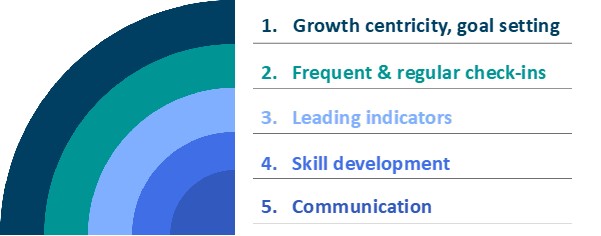
The principles underpinning growth-centric management and goal-setting form the bedrock of this approach. Setting clear and attainable goals, coupled with a relentless focus on growth, ensures that the leadership team is aligned in their efforts towards a shared vision. Frequent and regular check-ins serve as a vital mechanism for monitoring progress, providing opportunities for real-time adjustments to strategies, and maintaining a dynamic and responsive approach.
Incorporating leading indicators into the management approach enables proactive decision-making. By leveraging key metrics that precede broader trends, leaders can anticipate shifts in the business landscape and strategically position the organization to capitalize on emerging opportunities or mitigate potential risks. Furthermore, a commitment to skill development within the leadership team is paramount. Continuous learning and honing of skills ensure that leaders are equipped to navigate the complexities of a rapidly evolving business environment.
Communication emerges as a linchpin in the execution of focused management. Effective communication channels facilitate the dissemination of strategic objectives, foster transparency, and engender a shared understanding of the organization’s direction. Regular communication updates, inclusive of progress reports and adjustments to goals, create a cohesive and informed leadership team.
In the pharmaceutical sector, Novartis’ strategic focus on gene therapy and cell therapy units showcases the impact of targeted management. This emphasis has led to groundbreaking treatments such as Zolgensma for spinal muscular atrophy and Kymriah for certain types of cancer. Novartis’ management approach highlights the transformative potential of concentrating efforts on cutting-edge therapeutic areas. Biogen’s dedication to neurology serves as a compelling example of management focus in the biotech industry. The company’s emphasis has resulted in significant therapies such as Tecfidera for multiple sclerosis. Biogen’s leadership has consistently directed attention to neurological diseases, positioning the company as a leader in innovative solutions within this therapeutic domain. In the medtech sector, the persistence of Intuitive Surgical’s leadership in focusing on robotic-assisted surgery has been transformative. The da Vinci Surgical System, a product of this strategic management focus, not only revolutionized minimally invasive surgery but also solidified Intuitive Surgical’s position as a global leader in surgical robotics.
In summary, a management approach characterized by focus is not only about setting clear goals and objectives but is a holistic strategy that permeates throughout the organizational culture. It involves growth-centricity, continuous skill development, and a robust communication framework, all geared towards steering the company towards sustained success and innovation.
3. Deepen Market Insights
Market insights are a comprehensive understanding of market dynamics, trends, and opportunities gained through the analysis of data and information. This knowledge provides organizations with a strategic advantage by enabling informed decision-making and positioning them to proactively respond to shifts in the business landscape.

Market insights arise from a systematic process of collecting, analyzing, and interpreting data related to customer behavior, industry trends, and competitive landscapes. This involves extracting meaningful patterns and correlations from diverse data sources, such as consumer surveys, competitor analyses, and industry reports. Transforming raw data into meaningful and actionable intelligence is imperative for effective market insights. This involves employing advanced analytics, data visualization tools, and industry expertise to distill vast amounts of information into actionable strategies and informed business decisions.
The Importance of Market Insights: Market insights serve as a compass for organizations, guiding strategic initiatives and resource allocation. By staying attuned to market trends, companies can anticipate changes, identify opportunities, and proactively address challenges, fostering a competitive edge in dynamic industries. Business growth is intricately tied to market insights. In the pharmaceutical sector, companies like Pfizer leveraged market insights during the COVID-19 pandemic to swiftly redirect resources towards vaccine development, showcasing the pivotal role of market intelligence in addressing global health crises. In biotech, firms like Genentech strategically focused on breakthrough therapies like Rituxan and Avastin, driven by insights into evolving patient needs. In the medtech industry, companies such as Medtronic aligned their portfolio with diverse healthcare needs based on market insights, ensuring strategic versatility.
Efficient Process to Uncover Market Insights: The most efficient process to uncover market insights involves a continuous cycle of data collection, analysis, and feedback. Implementing robust data analytics tools, staying abreast of industry trends, and fostering a culture of innovation contribute to an effective market insights generation process. Challenges in generating market insights include data overload, ensuring data accuracy, and navigating through the noise of information. The rapidly evolving nature of industries in pharma, biotech, and medtech also poses challenges in keeping insights current and relevant.
In conclusion, market insights are a cornerstone in strategic decision-making, driving business success by providing a nuanced understanding of the ever-changing market landscape. Overcoming challenges in generating these insights is essential for organizations seeking to thrive in dynamic and competitive sectors.
4. Leverage Competitive Strengths
Leveraging competitive strengths involves a strategic commitment to bringing better overall value to customers compared to competitors. This requires a profound understanding of customer needs and market dynamics. By identifying and addressing unmet needs, companies can create offerings that not only meet but exceed customer expectations, establishing a competitive edge in the industry.
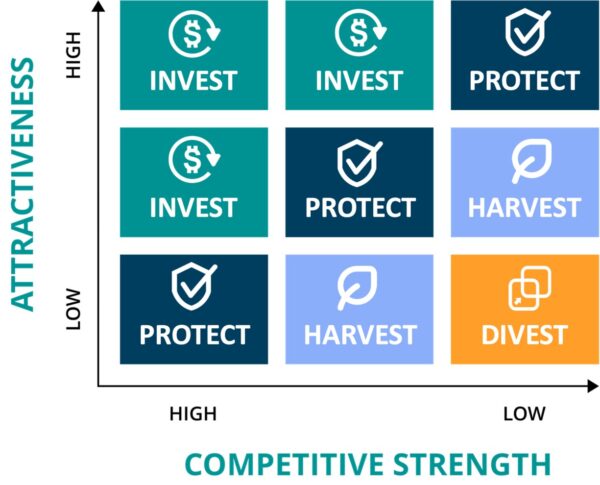
A critical aspect of leveraging competitive strengths is the deep understanding of customer needs. This involves actively listening to customer feedback, conducting market research, and staying attuned to evolving preferences. By comprehensively grasping customer requirements, companies can tailor their products and services to align seamlessly with these needs, fostering customer loyalty and satisfaction.
Successful companies align their product offerings and services with identified customer needs. This strategic alignment ensures that every aspect of the product or service resonates with the customer, creating a compelling value proposition. This alignment not only attracts new customers but also retains existing ones, contributing to long-term business success.
Building on Competitive Strengths: to effectively leverage competitive strengths, organizations must identify strengths that are both relevant in the market and enduring. Building on these strengths involves capitalizing on unique capabilities, resources, or expertise that set the company apart. By emphasizing and enhancing these differentiators, companies can create a sustainable competitive advantage. While building on strengths is crucial, addressing and mitigating weaknesses ensures that the company is not only leveraging strengths but also eliminating potential detractors from its value proposition.
In the pharmaceutical sector, companies like Johnson & Johnson leverage their diverse product portfolio, spanning pharmaceuticals, medical devices, and consumer healthcare, to bring comprehensive value to customers. Johnson & Johnson’s ability to understand customer needs across these domains allows them to offer integrated healthcare solutions. In biotech, Amgen strategically leverages its expertise in biopharmaceuticals to align with emerging needs in areas such as oncology and biologic therapies. Their focus on innovative solutions that address specific customer needs has propelled them as a leader in the biotech industry. In the medtech field, Siemens Healthineers exemplifies leveraging competitive strengths by aligning their diagnostic imaging and laboratory diagnostics with evolving healthcare requirements. Their emphasis on cutting-edge technology and precision medicine showcases a commitment to meeting customer needs in the rapidly advancing field of medical technology.

In summary, leveraging competitive strengths involves a holistic approach that encompasses understanding customer needs, aligning offerings, and building on distinctive capabilities. This strategy, exemplified by companies in pharma, biotech, and medtech, serves as a blueprint for sustainable success in dynamic and competitive markets.
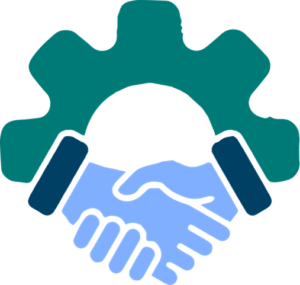
5. Identify Partnerships to Drive Growth
Effective partnerships entail strategically aligning with external entities to leverage shared strengths, resources, and expertise. The scope of such collaborations can be vast, encompassing various facets like research and development, distribution channels, market access, logistics, and engagement with patients, caregivers, or payer organizations. The essence lies in fostering synergy to create a collective impact greater than the sum of individual efforts. Effective partnerships hold the promise of accelerating innovation, expanding market reach, and navigating complex challenges. By tapping into the collective strengths of collaborators, companies can access a broader pool of resources and insights, enhancing their ability to bring transformative solutions to market and address the dynamic needs of the industry.
Successful partnerships are marked by a seamless integration of capabilities, where each partner brings unique value to the table. This collaboration often results in the development of innovative products or services, improved operational efficiency, and a strengthened market position for all involved parties. The ability to achieve shared goals and objectives becomes the hallmark of a successful partnership. Critical factors for effective partnerships hinge on the nuanced understanding of complementary capabilities and shared objectives. Identifying partners with strengths that complement rather than duplicate is essential. Additionally, aligning strategic goals and fostering open communication are crucial for maintaining synergy throughout the partnership lifecycle.
In the pharmaceutical sector, collaborations like the one between AstraZeneca and Oxford University for the development of the COVID-19 vaccine exemplify effective partnerships. This collaboration strategically combined AstraZeneca’s global reach and manufacturing capabilities with Oxford’s research expertise, resulting in the accelerated development and widespread distribution of the vaccine. Biotech companies, such as Biogen and Ionis Pharmaceuticals, formed a partnership for the development of innovative therapies, including Spinraza for spinal muscular atrophy. This collaboration leveraged Biogen’s commercialization capabilities with Ionis’s RNA-targeted drug discovery expertise, leading to groundbreaking treatments. In the medtech industry, partnerships like the one between Apple and Medtronic showcase the potential for collaborations in patient engagement. By integrating Apple’s technology with Medtronic’s medical devices, the partnership enhances patient monitoring and engagement, demonstrating the power of synergistic collaborations in advancing healthcare solutions. Effective partnerships in pharma, biotech, and medtech are transformative alliances that strategically or operationally leverage shared strengths, resources, and expertise. These collaborations not only accelerate innovation but also contribute to market expansion, offering a pathway for companies to accelerate growth.

6. Assign Talent to Growth Driver Products
Develop the Value Story: Strategic talent assignment begins with crafting a compelling value story for the organization. This narrative encapsulates the unique strengths, capabilities, and core values that define the organization. A robust value story not only communicates the mission and vision but also serves as a guiding light for aligning talent with strategic objectives. It forms the cornerstone for cultivating a cohesive organizational culture and steering collective efforts toward a common goal.
Define High-Value Positions: To drive growth effectively, organizations must meticulously identify the highest value-adding positions within their structure. This entails a comprehensive analysis of critical functions and roles that directly contribute to the organization’s success. The definition of high-value positions is intrinsic to strategic talent management, providing a roadmap to allocate talent where it can yield the greatest impact on the company’s growth trajectory.
Match Talent to Key Positions: Once high-value positions are identified, the next step is to strategically match the available talent pool with these roles. This process involves a nuanced alignment of individual skill sets, experiences, and strengths with the specific requirements of key functions. By strategically placing talent in roles where they can leverage their expertise to the fullest, organizations optimize human capital for sustained growth.
Define KPIs and Track Performance: Integral to strategic talent assignment is the establishment of Key Performance Indicators (KPIs) tied to organizational goals. Defining clear KPIs enables the measurement of individual and collective performance against strategic objectives. Continuous tracking of performance against these indicators not only ensures accountability but also provides insights into the effectiveness of talent placement, allowing for adjustments to enhance overall performance and match quality.
A McKinsey survey of 628 respondents found that 52% of companies that rapidly allocated and re-assigned talent did so on a quarterly basis. In the pharmaceutical sector, Roche strategically assigns talent to high-value positions, especially in research and development. Their value story centers around innovation and patient-centric solutions. By matching top scientific talent to critical roles, Roche has played a pivotal role in advancing groundbreaking therapies, including targeted cancer treatments. Biotech companies like Moderna exemplify precision in talent assignment. With a value story centered on cutting-edge mRNA technology, Moderna strategically places talent in research roles crucial for developing innovative vaccines, including the COVID-19 mRNA vaccine. This strategic alignment has propelled Moderna to the forefront of the biotech industry. Siemens Healthineers strategically assign talent to key positions in research and development of advanced medical imaging technologies. Their value story emphasizes precision medicine and diagnostic excellence. This talent strategy has enabled Siemens Healthineers to consistently deliver cutting-edge solutions in the medical technology landscape.
7. Conduct Targeted Experiments to Drive Growth and Learn
The first step in leveraging experiments to drive growth is to identify and select the targeted experiments. This involves a comprehensive analysis of potential areas for improvement, innovation, or expansion within the organization. Selecting the experiments strategically ensures a higher probability of adding value, aligned with the overall growth strategy.
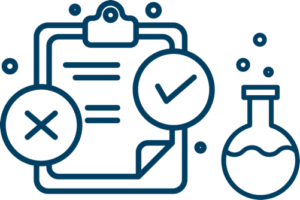
Define the Experiment, Assign Resources, and Establish KPIs: Once targeted experiments are identified, the next stage is to precisely define each experiment. This involves outlining the experiment’s scope, objectives, and expected outcomes. Simultaneously, resources and personnel are assigned to execute the experiment effectively. Establishing Key Performance Indicators (KPIs) is paramount, providing measurable metrics to track the experiment’s progress and impact on growth.
Run the Experiments: With a well-defined experiment, allocated resources, and established KPIs, the execution phase commences. Running the experiments involves implementing the planned strategies, initiatives, or changes within the organization. This hands-on phase allows the organization to test hypotheses, gather real-world data, and assess the practical implications of the chosen experiments.
Analyze Growth Experiments and Extract Insights: After completing the experiments, a meticulous analysis follows to evaluate their outcomes. This involves scrutinizing the collected data, measuring against predetermined KPIs, and identifying key insights. The analysis phase is crucial for understanding what worked, what didn’t, and extracting valuable lessons. These insights not only contribute to refining current processes but also inform the selection of the next set of experiments.
Select the Next Experiments: Building on the insights gained, the organization strategically selects the next set of experiments. This forward-thinking approach ensures a continuous cycle of improvement, innovation, and adaptation to dynamic market conditions. The selection process involves aligning the next set of experiments with overarching growth objectives, creating a seamless and iterative approach to organizational development.
In implementing this methodical approach to experimentation, organizations foster a culture of adaptability and innovation, continuously driving growth by learning from each experiment’s outcomes and refining their strategies accordingly. The culture of conducting targeted experiments is an essential driver of innovation and growth. Eli Lilly, CRISPR Therapeutics, and Boston Scientific demonstrate the value of learning from both successes and failures. While some experiments may not yield the expected results, the insights gained contribute to a wealth of knowledge, fostering adaptability and resilience.

Case Study organizational growth drivers: Pfizer’s COVID-19 vaccine development
In the concerted effort to develop the COVID-19 vaccine, Pfizer’s CEO Alberto Bourla reflects on the pragmatic lessons derived from the unprecedented journey. The pivotal acknowledgement is that success rested upon a focused and collaborative team effort involving individuals at all levels within Pfizer and BioNTech. Sacrifices were significant, with team members forgoing weekends and holidays, emphasizing the collective dedication to the common goal.
Strategically, the decision to prioritize purpose over profit was a fundamental driver. Financial gains were recognized as a byproduct rather than the primary goal, underscoring a mission-driven approach. This decision was deemed worthwhile, aligning with a broader acknowledgment of the private sector’s societal responsibility. A noteworthy challenge embraced during the vaccine development was the imposition of a six-month timeline. Initially met with skepticism from scientists, the goal became a rallying point. Similar challenges were presented to the supply group, tasked with logistical feats in extreme conditions, pushing the boundaries of what seemed feasible.
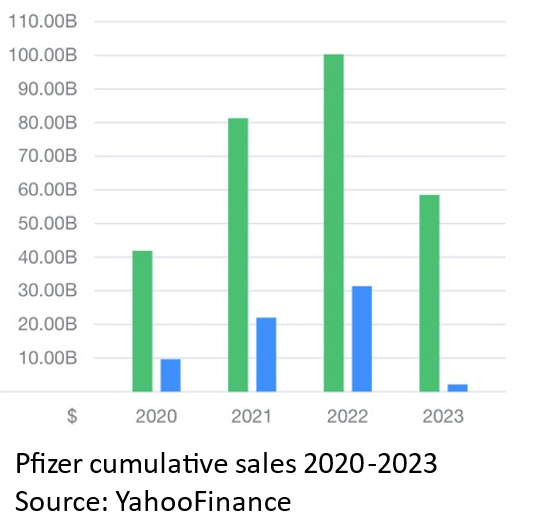
Challenging and fostering creative thinking within the organizational culture was important, as was management attention. Teams were encouraged to explore unconventional solutions beyond standard approaches. This emphasis on creativity became ingrained in the team’s problem-solving approach. A pragmatic lesson involved insulating scientists from financial constraints and excessive bureaucracy. The board’s acceptance of the high-risk nature of the endeavor allowed flexibility in spending without being tethered to pre-pandemic budget targets.
The narrative also highlights the importance of cooperation and partnerships, exemplified by the collaboration with BioNTech, which commenced before a finalized contract. Investments and information-sharing were grounded in prior collaborative experiences and shared ethical standards. As the pandemic unfolded, a trend of information- and expertise-sharing across companies and countries emerged. The interconnectedness of all efforts and in particular the scientific endeavors highlight the need for a collective approach within the broader scientific ecosystem and partnerships beyond the organization. Reaching out to other organizations and engaging them to find solutions was critical to overcome bottlenecks in clinical development and supply.
Pfizer’s journey in developing the COVID-19 vaccine serves as a compelling case that illuminates key principles across various strategic domains. The success of this venture resonates deeply with the essence of portfolio prioritization, where a patient-first mentality directed the allocation of resources and efforts toward a transformative goal. Management focus, a strategic imperative, emerges as the narrative unfolds, showcasing how aligning leadership attention with key growth drivers and fostering innovation underpins sustained growth. The case vividly illustrates the importance of deep market insights, as Pfizer’s ability to adapt swiftly to emerging global needs stems from a nuanced understanding of market trends. Leveraging competitive strengths becomes a linchpin in the narrative, where the company aligns its offerings with critical patient needs, showcasing how strategic balance can create enduring value. The narrative also sheds light on the significance of partnerships, revealing how collaborations with entities like BioNTech exemplify the strategic alignment of strengths to accelerate innovation. Finally, Pfizer’s success underscores the pivotal role of assigning key talent strategically, with a value-centric approach that defines roles based on their potential to contribute to the mission. In essence, this case serves as a beacon for companies seeking to navigate complex landscapes, emphasizing the synergy of these strategic elements in driving transformative growth.

Exercise 1.2
• the products and services offered,
• deep qualitative insights into customer and market needs,
• the outcomes of a data analysis
• the organization’s culture and reputation, as well as partnerships

Course Manual 3: Fundamental Strategic Choices
Fundamental Strategic Choices for Brand and Portfolio in Pharma, Biotech, and Medtech
In the dynamic landscape of pharmaceuticals, biotechnology, and medical technology, strategic decision-making is pivotal for sustained growth and market relevance. Companies in these industries face multifaceted challenges, ranging from fierce competition to rapid advancements in medical science and technology. Navigating this complex terrain necessitates a nuanced understanding of fundamental strategic choices that shape the brand and portfolio. One such critical aspect is the decision to pursue a market expansion strategy, a choice that requires careful consideration of market dynamics, competitive positioning, and the transformative potential of innovative therapies. In this exploration, we delve into three distinct scenarios that guide when companies in pharma, biotech, or medtech should strategically embark on a market expansion journey. These scenarios encompass achieving market leadership, building a market when the company is the sole player, and seizing opportunities presented by disruptive novel therapies that have the potential to reach diverse patient groups. Each scenario represents a strategic crossroads where informed decisions can chart a course for sustained growth and impactful contributions to the ever-evolving landscape of healthcare.
A. When to Pursue a Market Expansion Strategy?
1. Market Leadership (Directionally More Than 35% Market Share)

For well-established companies operating in the pharmaceutical, biotechnology, or medical technology industries, the pursuit of a market expansion plan becomes absolutely necessary once the company has achieved significant market leadership, which typically exceeds a market share of more than 35 percent. There is a strong desire to consolidate and extend the dominance in existing markets, which is the driving force for this strategy option. The introduction of new products, the expansion of product lines, or the entry into adjacent markets are all opportunities for businesses that have a considerable market share to capitalize on their brand awareness, distribution networks, and established relationships. By utilizing this strategy, they are able to take advantage of economies of scale, maintain pricing dynamics, and keep a competitive edge by strategically grabbing a greater portion of the market.
2. Only Player in the Market and Need to Build the Market
It is not only beneficial for a firm to pursue a market expansion plan in situations where it is the only participant in a specific market, but it is frequently required for the company to maintain its growth over time. The absence of direct competitors presents a one-of-a-kind opportunity to mold and construct the market. The advantage that comes with being in this position is that it allows the company to define industry standards, exert influence over the dynamics of the market, and establish themselves as the go-to source for particular products or services. Demand generation, stakeholder education, and the development of the market ecosystem are the primary focuses of this endeavor. As part of this strategic decision, a proactive strategy to market development is being taken, which includes focused marketing activities, collaborations, and innovation in order to fulfill the ever-changing requirements of customers.
3. Disruptive Novel Therapy Entering the Market, with the Potential to Reach Different Patient Groups
In the dynamic landscape of healthcare, the introduction of a disruptive novel therapy presents a strategic inflection point for pursuing a market expansion strategy. When a groundbreaking therapy with the potential to reach different patient groups emerges, companies in pharma, biotech, or medtech can strategically position themselves to capitalize on this innovation. This involves not only reaching existing patient populations but also identifying new segments that could benefit from the novel therapy. By understanding the broader applicability of the innovation, companies can proactively expand their market footprint, tapping into unmet medical needs and diversifying their portfolio to cater to a more extensive and varied patient base.
The decision to adopt a market growth plan is contingent upon a number of criteria, such as the current market share, the competitive landscape, and the possibility for breakthrough therapies to bring about transformation. Companies are required to conduct a thorough analysis of their current standing in the market and ensure that their expansion efforts are in line with their overall strategic goals. The objective is to make educated decisions that correspond with the company’s long-term vision and dedication to delivering significant solutions in the healthcare landscape. This is true regardless of whether the goal is to consolidate a dominant market presence, develop a market from scratch, or capitalize on disruptive breakthroughs.
B. When to Pursue a Differentiation Strategy?
In the intricate tapestry of pharmaceuticals, biotechnology, and medical technology, strategic choices play a pivotal role in shaping the trajectory of companies. One such fundamental decision revolves around the pursuit of a differentiation strategy. This strategic approach involves carving out a distinctive position in the market, setting a brand or portfolio apart from competitors. In the following exploration, we unravel key scenarios that signal the opportune moments for companies in pharma, biotech, or medtech to strategically adopt a differentiation strategy. From situations where a company is not a market leader to navigating entry after competition, preparing for the arrival of new competitors, introducing novel treatments, and addressing challenges in product positioning, each scenario presents a unique set of circumstances where differentiation becomes a strategic imperative.
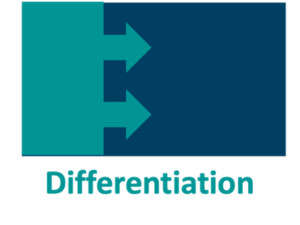
1. Not Market Leader
Consider Pfizer’s differentiation strategy in the pharmaceutical sector. Not always the market leader in every therapeutic area, Pfizer strategically differentiates itself through a commitment to research and development, consistently introducing innovative treatments. For instance, with the development of the COVID-19 vaccine, Pfizer showcased with a focus on cutting-edge solutions, a company can uniquely shape its position in the healthcare landscape. In this particular case, since a disruptive and novel technology was needed to rapidly deliver results, the established companies with large seasonal vaccine portfolios relied on the tried and proven approach to vaccine development. Because they were intimately familiar with this approach, their willingness to follow a different path was lower than Pfizer with a history of differentiated vaccines and a willingness to engage in a different technology.
2. Entry into Market After Competition
When it comes to joining a market following competition, the medical technology business Intuitive Surgical serves as an example of how to differentiate oneself from the competitors. When it comes to the realm of robotic-assisted surgery, Intuitive Surgical differentiates its da Vinci Surgical System in a strategic manner by continuously improving its technological capabilities. The use of this strategy enables Intuitive Surgical to establish itself as a pioneer in the surgical industry by providing cutting-edge solutions, even when entering a market that already has established competitors.
3. New Competitor Preparing to Enter the Market
In the biotech sector, Vertex Pharmaceuticals strategically differentiates itself when anticipating new competitors. Focused on innovative therapies for cystic fibrosis, Vertex invests heavily in research to maintain a leadership position. By consistently delivering groundbreaking treatments, Vertex strategically differentiates itself, creating a robust competitive advantage in the face of potential new entrants.
4. New Class of Treatments Entering the Market
Biopharmaceutical company Regeneron exemplifies differentiation in the context of a new class of treatments entering the market. Through a strategic focus on monoclonal antibodies, Regeneron positions itself at the forefront of transformative treatments. By aligning with the latest advancements, Regeneron not only differentiates its portfolio but also establishes a reputation for innovation and leadership.
5. Own Product is Not Clearly Positioned Among Target Audiences
For a medtech example, Siemens Healthineers strategically addresses challenges in product positioning. With its diagnostic imaging technologies, Siemens Healthineers continually innovates and differentiates its products by incorporating cutting-edge features. This strategic differentiation ensures that Siemens Healthineers’ products are clearly positioned as state-of-the-art solutions, meeting the diverse needs of healthcare providers.
Examining real-world examples from Pfizer, Intuitive Surgical, Vertex Pharmaceuticals, Regeneron, and Siemens Healthineers reinforces the significance of differentiation in diverse scenarios within the healthcare industry. Whether not being a market leader, entering after competition, preparing for new entrants, introducing novel treatments, or addressing challenges in product positioning, these companies exemplify how a well-executed differentiation strategy can reshape market perceptions and ensure sustained success in the competitive landscape of pharmaceuticals, biotechnology, and medical technology.
Effective pharmaceutical differentiation often revolves around innovative approaches, distinctive product attributes, and strategic positioning in the market. Here are some notable examples of pharmaceutical differentiation:
Monoclonal Antibodies in Oncology: Roche’s Herceptin (trastuzumab) and Rituxan (rituximab)
Differentiation: These monoclonal antibodies target specific proteins in cancer cells, offering a more targeted and personalized approach to cancer treatment. Their effectiveness in treating certain types of cancer, such as breast cancer and non-Hodgkin’s lymphoma, differentiates them by providing patients with more tailored and efficacious therapeutic options.
Gene Therapies for Rare Diseases: Novartis’ Zolgensma (onasemnogene abeparvovec)
Differentiation: Zolgensma is a gene therapy for spinal muscular atrophy (SMA), a rare and severe genetic disorder. The one-time treatment differentiates itself by addressing the root cause of the disease at the genetic level, offering a transformative approach compared to traditional symptom management.
Immune Checkpoint Inhibitors in Immunotherapy: Merck’s Keytruda (pembrolizumab) and Bristol Myers Squibb’s Opdivo (nivolumab)
Differentiation: These drugs are part of a new class of immunotherapies that target immune checkpoint proteins, allowing the immune system to better recognize and attack cancer cells. Their differentiation lies in their ability to harness the body’s own immune system to fight cancer, offering a novel and often more effective treatment option.
Personalized Medicine and Biomarker Testing: Pfizer’s Xalkori (crizotinib) for ALK-positive lung cancer
Differentiation: Xalkori is designed for patients with a specific genetic mutation (ALK-positive). The drug’s differentiation lies in its effectiveness for a subset of patients identified through biomarker testing, showcasing the shift towards personalized medicine and targeted therapies.
Novel Anticoagulants with Reversal Agents: Portola Pharmaceuticals’ Andexxa (andexanet alfa)
Differentiation: Andexxa is a reversal agent for novel oral anticoagulants, providing a solution for patients who experience uncontrolled bleeding. Its differentiation lies in being the first and only specific reversal agent for Factor Xa inhibitors, enhancing the safety profile of these anticoagulants.
RNA Interference (RNAi) Therapies: Alnylam Pharmaceuticals’ Onpattro (patisiran)
Differentiation: Onpattro is an RNAi therapeutic for hereditary transthyretin-mediated amyloidosis (hATTR), a rare genetic disease. Its differentiation lies in its mechanism of action, silencing the expression of the mutated gene responsible for the disease, representing a breakthrough in the treatment of rare genetic disorders.
C. When is a Mixed Differentiation/Market Expansion Strategy Most Appropriate?
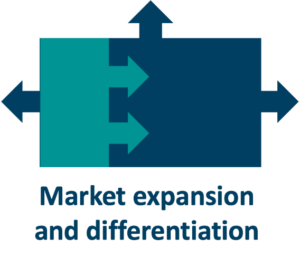
Companies often navigate a delicate balance between differentiation and market expansion strategies to secure sustained growth and market relevance. A nuanced understanding of when to seamlessly transition between these strategies is crucial for adapting to dynamic market conditions. This exploration delves into key scenarios where a mixed differentiation/market expansion strategy proves most appropriate. From situations where a brand is on a positive trajectory, gaining market share and clearly positioned, prompting a shift from differentiation to market expansion, to instances where new competitors entering the market necessitate a shift from market expansion to differentiation, each scenario reflects the strategic agility required in the ever-evolving healthcare industry.
1. When the Brand is on a Positive Trajectory, Gaining Market Share, and Clearly Positioned in the Minds of Customers – Shift from Differentiation to Market Expansion
An exemplary case in the pharmaceutical realm is Johnson & Johnson’s strategic trajectory with its pharmaceutical portfolio. Positioned as a leader in various therapeutic areas, Johnson & Johnson initially adopted a differentiation strategy by focusing on groundbreaking treatments and establishing a strong brand image. As the brand gains positive momentum, attains substantial market share, and achieves clear positioning in the minds of customers, a strategic shift towards market expansion becomes appropriate. Johnson & Johnson strategically expands its product lines, enters new therapeutic areas, and leverages its established brand reputation to capture additional market segments, illustrating the seamless transition from a differentiation-focused approach to a broader market expansion strategy.
2. When New Competitors are Entering the Market – Shift from Market Expansion to Differentiation
Take for example the introduction of a new competitor into the field of medical technology, which would pose a threat to an established firm such as Philips. Philips is facing the arrival of new competitors, which means that the strategic imperative moves from expanding the market to differentiating itself from its competitors. In order to further enhance its competitive positioning, Philips places an emphasis on technological supremacy, innovation, and solutions that are centered on the client. This strategic pivot enables Philips to not only defend its market share but also strategically differentiate itself in the face of increased competition. This demonstrates the adaptability that is required to traverse the changing dynamics of the market.

To successfully navigate a strategy that combines market expansion with distinction, one must possess both strategic acumen and a profound awareness of the dynamics of the market. Real-world examples from Johnson & Johnson and Philips demonstrate how beneficial it is to shift between these strategies in a seamless manner, taking into account the trajectory of the brand and the competitive landscape. This strategic agility is of the utmost importance for businesses that are looking to achieve sustained growth and market leadership in the pharmaceutical, biotechnology, and medical technology industries, which are characterized by a complex and ever-changing landscape. It is easier to successfully implement a mixed approach if one focuses on a small number of key performance indicators (KPIs) and implements their measurement in such a way that it influences the actions of all people of the business that interact with customers. As an illustration, if differentiation is the primary focus, the development of market share and the ability of target audiences to retain the message are essential. The number of new therapy starts and the growth in comparison to past time periods are both factors that support the priority of expanding the market when it is being considered.
Market expansion often involves reaching new patient populations, entering new therapeutic areas, or expanding globally. Here are some notable examples of pharmaceutical market expansion.
Expansion into Emerging Markets: Novartis in China
Market Expansion: Novartis has strategically expanded its presence in China, capitalizing on the growing healthcare market. By establishing collaborations, investing in research and development, and tailoring products to meet local needs, Novartis has successfully tapped into the large patient population in China, contributing to its overall market expansion strategy. In a similar approach, Astra Zeneca leveraged its portfolio of products with broad indications to expand in China, resulting in this market growing to be the second largest market for the company at a time when it was number 5-8 in other organizations. Astra was able to dramatically expand the number of patients it reached by tailoring its offering to the particular needs of the Chinese market at that time.
Broader Indications for Existing Drugs: Bristol Myers Squibb’s Opdivo (nivolumab)
Market Expansion: Opdivo, initially approved for melanoma, expanded its indications to include various cancers, such as lung cancer, renal cell carcinoma, and Hodgkin lymphoma. This strategic move broadens the patient population that can benefit from the drug, contributing to market expansion.
Over-the-Counter (OTC) Switch: Astra Zeneca’s Nexium (esomeprazole)
Market Expansion: Nexium, originally a prescription proton pump inhibitor, successfully transitioned to over-the-counter status. This switch allowed Astra Zeneca to expand its market reach by making the drug more accessible to consumers without requiring a prescription.

Case Study market driven growth: Merck’s Keytruda development approach
Merck’s Keytruda (pembrolizumab) has seen remarkable success, with over 40 indications covering more than 20 distinct tumor types. It was unintentionally found by biotech experts searching for medications that would boost PD1 rather than block it and lessen the immune response in autoimmune disease patients. Despite the discovery of a strong PD1 inhibitor and its recognition as a promising cancer treatment, the research program had to battle for financing through two mergers and acquisitions. The result was an astonishingly quick drug development program, started under Peter Kim and carried out in close collaboration with the FDA, finally falling under the new breakthrough designation procedure. In an attempt to bridge what it saw as a four- or five-year gap with BMS, Merck decided to pursue a companion diagnostic program for pembrolizumab use in lung cancer patients. This decision was highly contested by investors and the company’s newly appointed research leadership, which joined in 2013. Even though the Wall Street Journal only recently criticized the companion diagnostic program in March 2016, it ultimately proved to be crucial in propelling Merck ahead of BMS when the latter’s drug failed in first-line therapy for lung cancer among patients who were not as carefully chosen. Merck succeeded brilliantly by concentrating on the 30% of patients who were thought to respond. Due to its innovative approach to clinical development, it was possible to conduct the largest phase 1 clinical trial in oncology history, involving 655 patients with metastatic melanoma and a comparable number of patients with lung cancer.
Notably, the addition of pan-tumor indications that target tumor mutation burden-high and microsatellite instability has revolutionized patient management. Many of these indications are based on patient survival benefits that have been shown to improve.
In line with Keytruda’s mode of action, the journey started with a distinct focus on melanoma, kidney cancer, and non-small cell lung cancer. But a data-driven strategy prompted the investigation of alternative possibilities, revealing further indications where monotherapy could have significant advantages. The identification of individuals most likely to benefit was made easier by the biomarker’s discovery, which further improved patient selection. This investigation also challenged accepted standards by embracing the possibility of combination therapy in an agnostic manner.
One particularly interesting feature was the surprising way that Keytruda was used with chemotherapy in some individuals. Unexpectedly, the patients receiving treatment benefited overall from this non-traditional strategy, demonstrating Keytruda’s flexibility and dedication to optimizing therapeutic results.
Merck was open to working in combination with other businesses to accomplish combination projects using Keytruda, demonstrating their agnostic approach to partnerships. The development of these collaborations was spurred by the observation of increased activity in combination therapies compared to single drugs. Merck’s development program has benefited greatly from the collaborative element, which recognizes the importance of many viewpoints in addressing the intricate problems associated with developing cancer drugs and enhancing the quality of life for cancer patients. The graph illustrates the effect of Keytruda’s widespread combination use in relation to Opdivo, BMS’s closest rival.
IMAGE TOO BLURRED
With promising findings from early-stage cancer trials, Keytruda is making waves and has the potential to have a significant influence on patient lives in the future. The benefits of progression- or relapse-free survival seen in certain trials highlight the ongoing dedication to expanding the frontiers of cancer treatment. Furthermore, Keytruda’s success serves as a reminder of the advantages of differentiating a product first and then advancing quickly toward market expansion. In this instance, it led to a fundamental shift in the cancer business as well as many patients living far longer.

Exercise 1.3

Course Manual 4: Design Thinking Methodology
Design Thinking is a human-centered problem-solving methodology that places a strong emphasis on understanding and empathizing with the needs and perspectives of end-users. Contrary to traditional problem-solving approaches that often follow a linear and rigid structure, Design Thinking thrives on collaboration, iteration, and a deep appreciation for ambiguity. At its core, Design Thinking is not just a process; it is a mindset that encourages creativity, innovation, and a relentless focus on improving the user experience.
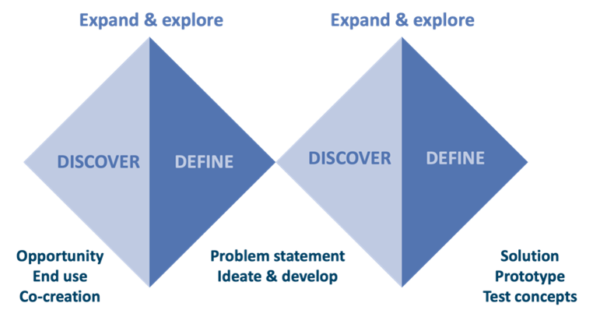
Design Thinking is not a one-size-fits-all solution; instead, it is a flexible framework that adapts to the unique challenges presented by each problem. It is not solely about aesthetics or creating visually pleasing products. While aesthetics play a role, the primary goal of Design Thinking is to address complex problems by uncovering insights, ideating solutions, and prototyping to test and refine those solutions. In essence, Design Thinking is not merely about the final product but the journey of discovery and refinement throughout the problem-solving process.
What Sets Design Thinking Apart
Empathy-Driven Approach:
Design Thinking stands out for its unwavering commitment to empathy. It begins by deeply understanding the needs, aspirations, and challenges of the end-users. This empathetic foundation ensures that solutions are not just technically feasible but are also aligned with the genuine needs and desires of the people they intend to serve.
Iterative and Collaborative Nature:
Unlike rigid methodologies that progress linearly, Design Thinking is iterative and thrives on collaboration. It encourages continuous feedback loops, allowing teams to refine and improve their ideas based on real-time insights. This iterative nature fosters an environment of continuous improvement and adaptation.
Human-Centered Problem Solving:
Design Thinking places humans at the center of the problem-solving process. It recognizes that solutions are most effective when they consider the human experience, leading to products and services that resonate with users on a profound level. This human-centered approach ensures relevance and usability in the real world.
Tolerance for Ambiguity:
Design Thinking embraces ambiguity and complexity. Rather than seeking quick and predefined answers, it acknowledges that the best solutions often emerge through exploration, experimentation, and an openness to unexpected discoveries. This tolerance for ambiguity encourages a mindset of curiosity and innovation.
Cross-Disciplinary Collaboration:
Design Thinking breaks down silos by promoting cross-disciplinary collaboration. It encourages diverse teams, including individuals with varied skills, backgrounds, and perspectives, to work together. This diversity fosters a rich exchange of ideas and brings a holistic range of insights to the problem-solving process.
Prototyping and Testing:
An integral part of Design Thinking is the emphasis on rapid prototyping and testing. This approach allows ideas to move from conceptualization to tangible form quickly. By testing prototypes with end-users, teams can gather valuable feedback and refine their solutions iteratively, ensuring that the final product meets user needs effectively.
In essence, what sets Design Thinking apart is its holistic and user-centric approach, its embrace of iteration and collaboration, and its ability to thrive in the face of uncertainty and complexity.
Design Thinking Mindset
Beyond the structured process, Design Thinking embodies a mindset that fosters innovation and creativity. This mindset is characterized by:
• Curiosity: A relentless curiosity to explore and understand the problem space, constantly asking “why” and seeking deeper insights.
• Openness to Ambiguity: Embracing uncertainty and being comfortable with navigating through complex and ambiguous problem spaces.
• Bias Toward Action: Encouraging a bias toward taking action and learning through experimentation rather than prolonged analysis.
• Collaboration: Promoting cross-disciplinary collaboration, recognizing that diverse perspectives enrich the creative process.
• User-Centric Focus: Keeping the end-users at the forefront of decision-making, ensuring solutions resonate with their needs, behaviors, and preferences.
History and Development of Design Thinking
Design Thinking has a rich history that evolved over the years, influenced by various fields and thinkers. While its roots can be traced back to early design processes, the term “Design Thinking” gained prominence in the 20th century. The concept was shaped by the belief that designers could contribute not only to the aesthetics but also to problem-solving in a broader sense. Pioneers like Herbert Simon and Robert McKim explored the idea of design as a methodology for solving complex problems.
The 1990s marked a significant period in the development of Design Thinking, with design consultancy firms like IDEO playing a pivotal role. IDEO, founded by David Kelley, became a global leader in innovation and design. IDEO’s approach emphasized a human-centered design process, putting empathy at the forefront of problem-solving. This approach laid the groundwork for what would later be recognized as Design Thinking, with a focus on understanding users, challenging assumptions, and iterative prototyping.
The Role that Stanford Design School Played
Stanford University’s d.school, officially known as the Hasso Plattner Institute of Design, has been instrumental in shaping and popularizing Design Thinking. Founded in 2005, the d.school emerged as a hub for interdisciplinary collaboration and innovation. Its founders, including David Kelley and Terry Winograd, envisioned a space that would foster creative problem-solving through a human-centered approach.
At the d.school, Design Thinking became more than just a methodology; it became a mindset and a culture. The school offered courses and workshops that brought together students and professionals from diverse backgrounds, encouraging them to tackle real-world challenges collaboratively. The d.school’s curriculum emphasized the importance of empathy, prototyping, and iteration in the design process.
One of the critical contributions of the d.school was the popularization of the Design Thinking process – empathize, define, ideate, prototype, and test – as a systematic approach to problem-solving. This framework provided a structured yet flexible guide for individuals and organizations seeking to adopt Design Thinking principles.
The d.school’s influence extended beyond its physical campus. The launch of the “Design Thinking Bootcamp” and the introduction of the “Stanford 2025” initiative further underscored the school’s commitment to spreading the principles of Design Thinking across various disciplines and industries. The success stories of projects emanating from the d.school, coupled with its reputation for fostering innovation, solidified Stanford’s role as a leading institution in the development and dissemination of Design Thinking.
Industries and Examples Benefiting from Design Thinking
Design Thinking has transcended traditional design domains and found application in diverse industries, transforming how problems are approached and solutions are developed. In the technology sector, companies like Apple have embraced Design Thinking to create user-friendly products with a seamless and aesthetically pleasing experience. In the automotive industry, companies such as Tesla have applied Design Thinking to reimagine electric vehicles and redefine the driving experience. Retail giants like Amazon have leveraged Design Thinking to enhance customer journeys, making online shopping intuitive and convenient.
Design Thinking at Amazon
Customer-Centric Innovation
Amazon’s success is grounded in its relentless focus on the customer. The company applies Design Thinking principles to deeply understand customer needs and pain points. Through extensive user research and data analytics, Amazon identifies opportunities for innovation, shaping its products, services, and user interfaces to align with customer preferences.

Iterative Prototyping
Amazon’s approach involves iterative prototyping and testing. Before launching a new feature or service, the company often releases prototypes or minimum viable products (MVPs) to a subset of users. This allows Amazon to gather real-world feedback, refine the offering based on user interactions, and ensure that the final product meets customer expectations.
Cross-Functional Collaboration
Amazon fosters cross-functional collaboration to drive innovation. Teams at Amazon, comprising designers, engineers, product managers, and customer service representatives, work collaboratively. This interdisciplinary approach ensures that diverse perspectives contribute to the design process, enhancing the overall user experience.
Design for Accessibility
Amazon places a strong emphasis on accessibility in its design processes. Whether it’s the website, mobile apps, or Kindle devices, Amazon ensures that its products are usable by a wide range of users, including those with disabilities. This commitment to inclusivity reflects Design Thinking’s principle of empathizing with diverse user needs.
Cultivating a Design Mindset
Amazon fosters a culture that encourages a design mindset throughout the organization. This involves promoting creativity, experimentation, and a willingness to learn from failures. By embedding a design-oriented approach into its organizational culture, Amazon continually strives to improve and innovate.
Design Thinking at Apple
User-Centered Product Design
Apple’s success is synonymous with its commitment to user-centered design. From the iPod to the iPhone and beyond, Apple products are known for their intuitive interfaces and sleek aesthetics. Apple’s design team, led by Jony Ive, employs Design Thinking principles to deeply understand user behaviors, preferences, and expectations.

Empathetic Understanding
Apple starts its design process with empathetic understanding. The team immerses itself in the user’s experience, aiming to grasp not only functional needs but also emotional and aspirational aspects. This understanding is crucial in creating products that seamlessly integrate into users’ lives.
Iterative Prototyping and Testing
Apple follows a rigorous process of iterative prototyping and testing. Multiple design iterations are created and tested internally before selecting the most promising concepts for further development. Prototypes are refined based on usability testing and user feedback, ensuring a user-friendly final product.
Cross-Disciplinary Collaboration
Collaboration is at the heart of Apple’s design process. Designers, engineers, and software developers work closely throughout the product development lifecycle. This cross-disciplinary collaboration ensures that hardware, software, and user interface design are seamlessly integrated, contributing to the overall user experience.
Focus on Aesthetics and Simplicity
Design Thinking at Apple emphasizes aesthetics and simplicity. The goal is not just functionality but elegance in design. Apple products are characterized by clean lines, minimalist interfaces, and an intuitive user experience, reflecting the Design Thinking principles of ideation and prototyping.
Innovation in Retail Design
Apple extends its Design Thinking approach to retail spaces. Apple Stores are designed to be inviting, immersive, and user-friendly environments. The layout encourages customers to explore and interact with products, creating a unique retail experience that aligns with Apple’s overall design philosophy.
The healthcare sector, including Pharma, Biotech, and Medtech, has witnessed the profound impact of Design Thinking. Organizations have shifted from a purely science-focused approach to a more patient-centric one, recognizing the importance of user experience and engagement in healthcare solutions. The following paragraphs delve into the specific application of Design Thinking in the life sciences sector.
Application of Design Thinking in Pharma, Biotech, and Medtech
In Pharma, the adoption of Design Thinking has led to a more empathetic understanding of patients’ needs and experiences. Companies have engaged in patient journey mapping, identifying pain points in treatment adherence, and developing solutions that prioritize the patient’s well-being. For example, Eli Lilly utilized Design Thinking to create a connected insulin pen, simplifying diabetes management for patients.
In Biotech, Design Thinking has played a crucial role in the development of patient-centric therapies. Understanding the emotional and practical aspects of living with a rare disease, biotech firms have applied Design Thinking principles to design clinical trial experiences that prioritize patient comfort and engagement. Genentech’s approach to personalized medicine and its commitment to understanding patient perspectives exemplify the impact of Design Thinking in the biotech industry.
In Medtech, the focus on user-centered design has led to innovations that prioritize the end-user – whether it be healthcare professionals or patients. Devices and technologies are developed with a deep understanding of the user’s workflow, ensuring seamless integration into medical practices. Medtronic’s design of minimally invasive surgical tools and user-friendly interfaces in medical devices exemplify the successful application of Design Thinking in Medtech.
Critical Success Factors for Design Thinking Projects
Empathy at the Core:
Successful Design Thinking projects begin with a genuine and deep understanding of the end-users’ needs, challenges, and aspirations. Empathy lays the foundation for meaningful solutions that resonate with the target audience.
Cross-Disciplinary Collaboration:
Design Thinking thrives on diverse perspectives. Collaborative teams that bring together individuals with varied skills – from designers and engineers to business strategists and end-users – foster a rich exchange of ideas, enhancing the creative problem-solving process.
Iterative Prototyping and Testing:
Design Thinking projects involve rapid prototyping and testing. Iterative cycles of creating prototypes, gathering feedback, and refining solutions ensure that the final product or service is aligned with user expectations and requirements.
Cultivation of a Design Mindset:
Beyond a specific process, cultivating a design mindset throughout an organization is crucial for sustained success in applying Design Thinking. This involves fostering a culture that values curiosity, experimentation, and learning from failures.
User-Centric Ideation:
Ideation in Design Thinking revolves around generating solutions that directly address the identified needs and preferences of the end-users. This user-centric approach ensures that the solutions resonate with the target audience.
Openness to Ambiguity:
Design Thinking projects often navigate through ambiguous and complex problem spaces. Success requires a team that is comfortable with uncertainty, embraces ambiguity, and sees challenges as opportunities for innovation.
Executive Support and Commitment:
Design Thinking projects are most effective when there is visible support and commitment from organizational leadership. Executives who champion the importance of user-centered design and provide necessary resources contribute to the success of Design Thinking initiatives.
Integration into Organizational Processes:
Design Thinking is most impactful when it is seamlessly integrated into the organizational processes and decision-making frameworks. This requires aligning Design Thinking practices with broader business strategies and objectives.
Use cases of applying Design Thinking in organizations
Does Design Thinking require a special organizational culture?
Design involves aesthetics and workmanship, thus designers are considered artistic savants. A design-centric culture teaches principles to those who help implement ideas, not just designers. Examine their principles.
Prioritize user emotions
To foster empathy, design-centric companies encourage workers to observe behavior and infer consumer needs. Quantifying their conclusions is tough. Instead, firms that “get” design describe things and people emotionally (desires, ambitions, engagement, and experience). Team members evaluate value proposition emotional resonance, functionality, and product needs.
Lexus offers secure, comfortable, well-designed high-performance mobility. Lexus promises to soothe, glamourize, and enrich you. Design firms don’t view emotive language as stupid, ignorant, or biased. Their strategic talks usually include how a business decision or market trajectory will improve consumers’ experiences and agree that well-designed services boost financial performance.
All customer-facing functions, including product designers, marketers, and strategists, prioritize excellent experiences. Just think about money. User contact is mainly limited to billing and payment systems for corporate betterment or “customer requirements.” However, those systems affect client perception of the company. Financial touch points prioritise client needs over operational efficiency in customer-focused cultures.
Create models for tough challenges
While it was first used to construct physical objects, design thinking is increasingly being used to complex, intangible problems like customer service. Designers investigate, define, and communicate using physical models, or design artifacts. Diagrams and sketches supplement or replace spreadsheets, specs, and other organizational documents. They fluidly explore complexity to aid nonlinear problem-solving.
The Veterans Affairs Center for Innovation used a customer journey map to identify veterans’ emotional highs and lows during VA interactions. This helped to better deliver a story to diverse stakeholders, according to Melissa Chapman, Center for Innovation designer. By developing a strategic way to think about changing the entire organization and to communicating that strategy, design models like the customer journey map help understand in a different way. They provide profound views that then allow the users to gain a different perspective.
Test solutions with prototypes
Design-centric organizations have office and conference room prototypes of new goods, services, and ideas. Prototypes explore solutions, whereas customer journey maps evaluate problems. Digital, tangible, or diagrammatic, they convey ideas. Publicly displaying early prototypes reflects an open-minded culture that emphasizes experimentation over rules. The MIT Media Lab’s slogan, “Demo or die,” recognizes that only prototyping can make an idea valuable—ideas are plenty. Innovation expert Michael Schrage called design firms’ public brainstorming and rapid prototyping “serious play.” His work calls invention “more social than personal.” He believes, “Prototyping is probably the single most pragmatic behavior the innovative firm can practice.”
Allow it to fail
A culture of design thinking supports and fosters. It doesn’t encourage failure, but iterative design recognizes first impressions are odd. Despite Apple’s success, the Newton tablet, Pippin gaming machine, and Copland OS sold poorly. Pippin and Copland split after two years. The company learns from failure as part of innovation. GE Software chief experience officer Greg Petroff described the iterative process: “GE is moving away from exhaustive product requirements. Teams learn by doing, iterating, and pivoting.” Every employee must know they may take social risks like proposing half-baked ideas without repercussions.
Mindfully limit
Products that evoke emotion are usually simpler than competitors’. Constraints come from deliberate product choices. A company simplifies customer experience by removing features. The complex Nest thermostat has fewer outward-facing functions than other thermostats, producing an emotive experience that reflects the company’s design thinking. CEO Tony Fadell told Inc., “At the end of the day you have to espouse a feeling—in your ads, in your products. Stomach gives such feeling.”
Further reading:
• design thinking
• design thinking resources

Case Study design thinking: The Transformative Impact of Design Thinking at GE Healthcare
In the annals of organizational metamorphosis, GE Healthcare’s embrace of design thinking stands out as a testament to the profound impact that a shift in mindset can have on innovation, user experience, and overall company culture. Traditionally entrenched in a technology-centric paradigm, where the development of advanced medical machines took precedence, GE Healthcare underwent a paradigm shift towards design thinking, upending conventional norms that relegated design considerations to the periphery of product development.

This transformative journey began to coalesce around 2008 when Doug Dietz, a venerable figure in GE Healthcare’s design team, confronted a pivotal moment during a routine visit to a children’s hospital. Witnessing a terrified child facing a massive magnetic resonance machine sparked a profound realization for Dietz. This encounter served as the catalyst for reimagining the healthcare experience, leading to the initiation of a design thinking workshop that focused on the “human side of the equation.” The fruit of this endeavor was the groundbreaking “Adventure Series,” a radical redesign of pediatric radiology imaging that sought to transform a daunting medical procedure into a whimsical, Disney-like adventure.
The impact of the Adventure Series rippled through the healthcare landscape, transcending mere financial success. It reshaped the procurement dynamics, fostering loyalty among pediatric hospitals and seamlessly integrating into the broader service delivery concept. Patient comfort and compliance soared, resulting in a cascade of positive outcomes—reduced sedation rates, lower treatment costs, and heightened satisfaction for the families intricately involved in the treatment process.
Beyond its immediate success, the Adventure Series became emblematic of a broader paradigm shift within GE Healthcare. It challenged the prevailing perception of design as a superficial or tangential facet of product development. This transformative ethos found institutional expression through the Menlo Innovation program—a strategic initiative designed to institutionalize design thinking principles across the organization.
A linchpin to Menlo’s success lay in the establishment of a dedicated physical space that served as a crucible for creativity. This space, in stark contrast to traditional corporate environments, signified the end of “work as usual” and provided a safe haven for vulnerability, experimentation, and ideation. This physical manifestation of the program’s commitment to divergent thinking and creativity proved instrumental in fostering an environment where design thinking principles could take root and flourish.
Yet, the transformative journey was not without its challenges. Resource allocation presented a perennial hurdle for programs like Menlo, operating without predetermined outcomes and relying heavily on leadership support. In response, Menlo innovatively generated funds by operating as an internal consultancy, demonstrating an adaptable and self-sustaining model. The program’s success, however, also spawned challenges related to growth, with pressure on maintaining quality and consistency. To address this, Menlo introduced a “train the trainer” model, enabling enthusiastic participants to apprentice as coaches and extend the program’s reach.
Resistance, a common theme when introducing new work modes, was acknowledged and addressed deliberately by Menlo leaders. By embedding periods during workshops where customers and executives participated and validated the team’s work, Menlo strategically illustrated the tangible benefits of the design thinking process, countering resistors and building momentum within teams.
The lessons learned from GE Healthcare’s design thinking journey are invaluable for organizations contemplating a similar transformation. Seeking information and inspiration from diverse sources, nurturing a culture of patience and continuous improvement, and recognizing the strategic value of small wins are all pivotal in successfully implementing design thinking principles. Moreover, Menlo’s commitment to making the alchemy of design—blending science with empathy—accessible to all represents a lasting legacy that extends beyond financial gains, leaving an indelible mark on the organization’s ethos and approach to innovation.

Exercise 1.4

Course Manual 5: Empathy With Customers
This is the first step in the design thinking process: empathizing.

When it comes to the Design Thinking approach, the step that serves as the fundamental step is empathy. This phase ensures that the entire process is anchored in a profound grasp of the requirements, viewpoints, and experiences of the end-users. The most important step in this process is to completely submerge oneself in the world of the users in order to acquire insights that go beyond simple functionality and to tap into the emotional and human factors that are responsible for behavior.
When it comes to empathizing, the first stage is observation, which requires designers to pay close attention to and comprehend the environment, activities, and interactions of the users. In many cases, this entails carrying out field research, observing users in their natural environments, and observing their activities without interfering with them. In the process of thorough observation, designers have the ability to discover unarticulated demands, pain areas, and characteristics that users may not express vocally.
User engagement is a dynamic activity that goes beyond passive observation. It is a process that involves interaction with users. It allows for direct interaction, interviews, and conversations to be conducted in order to collect qualitative data regarding the experiences and difficulties faced by users. Because of this interaction, a personal relationship is fostered, and designers are given the opportunity to delve into the thought processes, motivations, and objectives of the stakeholders. Users are encouraged to offer their viewpoints in a genuine manner through the use of open-ended questions and active listening, which are crucial components utilized throughout this phase.
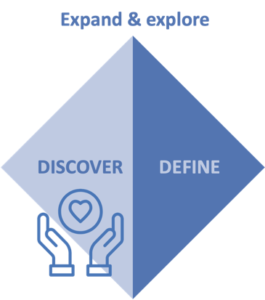
The concept of immersion refers to the act of completely submerging oneself in the setting of the users in order to gain an understanding of their environment from their point of view. Spending time living or working with users, experiencing their daily routines, and obtaining a personal respect for the issues they confront are all examples of what this may entail. Users’ life and the context in which they interact with a product or service can be better understood through the use of immersion, which helps designers go beyond surface-level insights and fosters a more holistic understanding of users.
Identifying the Emotions That Drive Behavior The process of empathizing involves identifying the feelings that are the driving force behind the actions and choices of users. Emotions, in addition to the requirements of functionality, play a key part in the formation of user experiences. In the process of researching the emotional journey that is linked with interactions, designers aim to understand not just what users do but also why they conduct those actions. Through this empathic investigation, it is possible to identify areas of discomfort, instances of joy, and chances to develop solutions that are emotionally resonant.
Developing a Human-Centered Approach The empathizing phase is an essential part of developing a human-centered approach. This phase emphasizes the significance of designing for actual people who have real requirements. Designers are able to move beyond assumptions and prejudices when they embrace the viewpoints and experiences of users. This gives them the ability to ensure that solutions are in line with the complicated realities of users’ lives. As a result of this change toward human-centered design, the groundwork has been laid for later stages of the Design Thinking process.
The iterative nature of empathy is a process that continues throughout the entirety of the Design Thinking journey. Empathy is not a one-time activity but rather an ongoing process that occurs throughout the trip. While designers are coming up with ideas, prototyping, and testing solutions, constant empathic involvement guarantees that the evolving design continues to be rooted in the ever-growing requirements and experiences of the users. The dynamic and responsive aspect of Design Thinking is reflected in this iterative nature, which enables continual modification based on user feedback and growing insights while also allowing for continuous improvement. The core of empathizing is that it is the bridge that connects designers with the human side of design difficulties, thereby paving the way for solutions that are inventive and user-centric.
Consider the Perspective of a Novice

Within the framework of the Design Thinking process, empathizing is a vital component that involves assuming the perspective of a beginning. With this technique, designers are encouraged to approach an issue with a clean slate, free of any preconceived beliefs or biases that may be present. By adopting the attitude of a beginner, designers are able to open themselves up to new options and avoid making assumptions about the requirements or habits of users. A number of guiding principles are responsible for this component:
In order to have a beginner’s mindset, it is important to refrain from passing judgment. Designers refrain from prematurely judging or classifying observations, which enables them to gain a more open and objective view of the user experience. This attitude of non-judgment helps to cultivate an environment that encourages exploration and discovery.
Everything Should Be Questioned: When you question everything, you are questioning assumptions and looking for deeper insights. In order to discover the underlying motives, preferences, and issues that users encounter, designers ask questions that penetrate deeply into the subject matter. The user experience often contains multiple layers of complexity and depth, and this continual questioning helps to uncover those layers.
Genuine curiosity is the engine that propels empathy, so make sure you make an effort to cultivate it. The designers foster a genuine interest in comprehending the users, the circumstances in which they operate, and the narratives they tell. Designers are motivated to delve deeper, explore unexplored territory, and find parts of users’ life that may not be immediately evident when they are motivated by curiosity.
Identify Patterns: The process of identifying patterns entails identifying recurrent themes or behaviors that occur throughout a variety of user encounters. The process of recognizing patterns enables designers to extract important insights and gain a better understanding of the larger context in which users function. When it comes to the development of user-centric solutions, patterns offer vital insights that contribute to the process.
Having the ability to empathize requires a number of skills, one of which is effective listening. The designers pay attention to what the users have to say without interrupting them, which enables the users to fully express themselves. In addition to paying attention to the words that are spoken, deep listening also requires paying attention to the tone of voice, body language, and the feelings that are being communicated. A deeper knowledge of the views of users is gained by designers through the practice of empathic listening.
Utilize the What, How, and Why
During the phase of empathizing, the “What, How, Why” framework helps to provide a structured approach to the process of obtaining insights. The following are some of the ways in which it pushes designers to investigate the concrete and intangible aspects of user experiences.

What is it
Observable Behaviors: This aspect of the study focuses on the actions that users take and the behaviors that are seen throughout their interactions with the system. This includes behavior that can be immediately witnessed, such as gestures, actions, and reactions that are physical in nature.
The way
This section delves into the process of user interactions and provides an overview of the process. How does a user interact with a product or service of some kind? What are the procedures that they carry out? It is possible to gain insights into the user journey by gaining an understanding of the mechanics of interactions.
As to why:
Discovering the underlying motivations, beliefs, and feelings that are responsible for user behaviors is the goal of this research process. What compels people to select particular options? What factors, such as their values or their goals, influence their choices? Deeper insights can be gained by gaining an understanding of the “why” behind acts.
The Justification Behind These Components:
In order to cultivate new perspectives, it is beneficial to adopt a beginner’s attitude because it encourages creativity and invention. Designers are able to approach difficulties with a fresh perspective when they let go of their preconceived assumptions. This might result in the development of novel solutions that could otherwise be overlooked if they had a more biased outlook.
Keeping from forming Assumptions Designers can avoid forming assumptions about users by refraining from passing judgment on everything and by questioning everything. It is essential to address this issue in order to prevent cognitive biases from having an impact on the design process and to guarantee that solutions actually connect with the requirements of the users.
A holistic grasp: The “What, How, Why” paradigm ensures that a comprehensive grasp of the user experience is achieved. The designers are prompted to investigate the depth of the activities, interactions, and motives of users, which goes beyond the surface-level observations that often occur. Having an all-encompassing perspective is necessary in order to make well-informed decisions.
Enhancing Communication: Communication between designers and users can be improved by the usage of the “What, How, Why” framework and through the practice of deep listening. The organized framework gives a shared vocabulary for articulating and comprehending user experiences, while active listening allows designers to create rapport and trust with their clients.
Interview to Determine Empathy
Ask the question “Why”
Specifically, designers will ask open-ended “why” questions during interviews in order to delve deeper into the inner motives and cognitive processes of people.
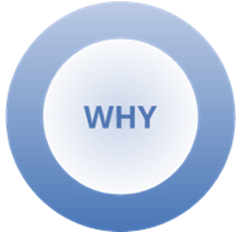
The reasoning for this technique is that it reveals the underlying reasons that users have for their activities, preferences, and judgments, which in turn provides greater insights into the requirements of the users.
Questions should not contain the word “usually”:
Specific Information: In order to avoid leading or biased inquiries, designers attempt to avoid using phrases such as “usually” in their questions.
The rationale behind this is that it assists in obtaining replies from users that are more truthful and honest, thereby preventing them from complying to any expectations they perceive.
Inquire About Stories:
With regard to the specifics, designers urge users to offer tales or stories that are connected to their experiences rather than delivering simple comments.
Reasoning: Stories make it possible to gain a more in-depth comprehension of the circumstances, feelings, and nuances that are associated with the interactions that people have with products or services.
Be on the lookout for inconsistencies
Specific Information: When conducting interviews with users, designers are constantly on the lookout for discrepancies or contradictions in their comments.
The identification of discrepancies is beneficial because it enables the discovery of characteristics that might not be in accordance with the initial assumptions or expectations, which ultimately results in a more nuanced knowledge.
Pay Attention to Cues That Are Not Verbalizing
Specific Information: During interviews, designers pay attention to and make sense of non-verbal indications such as body language, facial expressions, and gestures.
The reasoning for this is that non-verbal cues offer additional layers of information, which can provide insights into the feelings and reactions that users are not verbalizing.
Recognize that this is a necessary part of the process
Specific Information: Designers recognize and permit users to have moments of silence during interviews, which allows users to ponder on the questions that have been asked.
The rationale behind this is that silence can be interpreted as a sign of contemplation, and considering it to be a natural part of the process encourages users to provide comments that are more deliberate.
In order to avoid suggesting answers, it is important to ask questions that are neutral.
Designers structure queries in a neutral manner, avoiding suggestions or leading statements.
Specific Details: Designers focus on the design process.
In order to avoid users from being swayed and to encourage them to share their actual opinions and feelings, neutral questions are considered to be the best option.
Search for Extreme Users and Make an Effort to Understand Them:
Recognize Users Who Are Extreme
Users who fall on the extreme ends of the user spectrum, such as those who are particularly satisfied or unsatisfied, are specifically sought for by designers. This is a characteristic that designers purposefully seek out.
Reasoning: Extreme users frequently disclose extraordinary insights and points of view that can be used to guide the design process, either revealing demands that have not been satisfied or emphasizing experiences that are exceptional.
Learn to Recognize Extreme Users:
In-depth interviews and observations are conducted by designers in order to gain a better understanding of the experiences, motivations, and issues faced by extreme users.
Reasoning: When designers develop a knowledge of extreme users, they are able to gain insights that can be used to inform the design of solutions that cater to a wider spectrum of users, including those that have unique wants or preferences.
Create a condensed version of your observations, share them, and record them
During the empathizing phase, designers take the raw observations they have obtained and transform them into cohesive narratives. These narratives encapsulate the user experience in forms of stories. This storytelling technique accomplishes two goals: first, it simplifies difficult ideas into a format that is more approachable, and second, it encourages empathy among the members of the design team. The designers not only develop a representation of user experiences that is easily communicative and memorable by summarizing observations in the form of tales, but they also cultivate a shared understanding among the members of the team.

The process of empathic exploration includes crucial components such as the sharing and recording of these stories. These narratives are actively disseminated by designers to members of the team as well as stakeholders through a variety of channels, including textual documentation, graphic representations, and multimedia presentations. By ensuring that empathic ideas received from users are properly conveyed and preserved within the team, this system for sharing and capturing guarantees that a communal and empathetic approach is promoted throughout the design process.
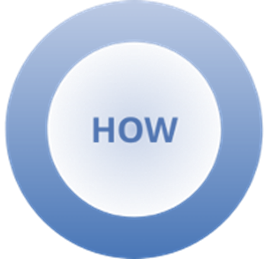
Enhance the End User Journey Map by Adding in
The designers go beyond a surface-level exploration of interactions in order to develop a more in-depth approach to the end user journey map. Instead, they are working toward the creation of a comprehensive map that chronicles the full user experience, beginning with the first point of contact and ending with further observations on the interaction. The designers are able to spot touchpoints, pain points, and chances for improvement along the user journey thanks to this comprehensive view, which results in a more nuanced understanding of the overall user experience.
Designers are constantly on the lookout for trends and anomalies within the full end user journey map structure. Performing an analysis of the map enables the detection of recurrent patterns in user behavior, emotions, or pain points, which in turn provides useful insights into the experiences that are commonly encountered by users. During the same time, anomalies bring attention to situations that are unusual or unexpected, providing designers with the opportunity to cater to a wide range of user requirements. The design process is guided with precision and relevance thanks to this dual focus on patterns and anomalies, which adds to a deeper understanding of the user journey.
The investigation with empathy in design thinking entails transforming observations into captivating tales and deepening the end user journey map. In conclusion, this is what the exploration with empathy refers to. The goal of designers is to foster empathy among their team members and guarantee that insights are effectively communicated. This is accomplished by summarizing findings in narratives. Simultaneously, the development of a thorough end user journey map that places an emphasis on patterns and anomalies offers a holistic understanding of user experiences, which in turn shapes the succeeding stages of the design process.

Case Study Empathy to develop customer solutions: Netflix
Netflix in a competitive environment
Netflix is the best example of a company that has successfully adapted its business model to match the preferences and requirements of its customers. As an illustration of what happens to a company that fails to pivot, adapt, and satisfy the ever-changing demands of the market, Blockbuster is the company that was its primary original opponent.
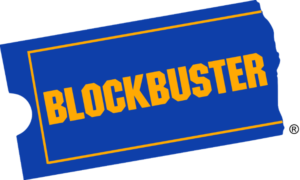
Customers were required to travel to Blockbuster in order to obtain the most recent brand-new releases on video or DVD because the company was a traditional DVD rental store. Netflix began sending movies to customers’ doorsteps through the mail in the early years of the company’s existence, which was in the aughts. That was an interesting strategy at first, but it wasn’t until cable companies started delivering movies on demand that it became obsolete. Netflix was faced with a conundrum as a result of this situation: why would customers order from Netflix and wait a few days when they could view any movie whenever they wanted?

The manner in which both businesses adapted to the transition toward on-demand and online content exemplifies the distinction between traditional and agile business models. It also demonstrates why company executives need to maintain continual engagement with customers in order to generate innovation and remain relevant.
The revolution in music streaming
The executives at Netflix saw the significance of design thinking for what it is: a strategy for continuously improving the products and services they provide to customers. In order to please customers, drive engagement, and generate new revenue, teams were pushed to explore for new opportunities to do so. What is the route? A consumer should be able to empathize with them, identify their pain points, and identify their unmet wants.
Starting in 2011, Netflix started developing its very own original movies and episodes that are available to stream online. They did not merely stop at providing new series; rather, they released each and every episode of each season on the very first day that it was made available to the public. Netflix was able to capitalize on the phenomenon of binge-watching by producing original and provocative programs such as Orange Is the New Black, House of Cards, and Bojack Horseman. This helped the company even come up with the term “Netflix and chill,” which is now becoming widely used. As a result of the popularity of the possibility to view multiple episodes in a single sitting, audiences absolutely gorged themselves on the shows. Eventually, even more significant streaming phenomena, such as Stranger Things and Black Mirror, came to dominate the cultural narrative whenever a new season was released, leaving everyone talking about one thing: Netflix.
Continuing to innovate
Over the course of 2016, Netflix once again responded to the market by redesigning their primary landing page in order to attract the attention of users as soon as they logged in. They added auto-play trailers that launched when the mouse hovered over them, rather than providing still images or series post-ers.
By utilizing artificial intelligence and predictive analytics, Netflix was able to build a one-of-a-kind experience for each viewer based on their individual viewing habits. This was done since the company saw additional potential to provide consumers with something they did not know they wanted. Not only did the “Because you watched” feature revolutionize the way customers interact with Netflix, but it also revolutionized the expectations of every other entertainment firm that was vying for a spot in the streaming game.
All of these improvements were discovered by Netflix through the application of design thinking, which allowed the company to repeatedly empathize with their customers. Blockbuster, on the other hand, continued to operate according to the conventional brick-and-mortar model, which made it more difficult for customers to obtain what they desired at the time they desired it. Netflix was aware that their continued existence was contingent upon not only being aware of the specific experiences that each and every consumer desired to have while using their service, but also making a concerted effort to meet customers where they were at. Netflix evolved because it recognized the demands of its customers and adapted to meet those needs. Blockbuster, and DVD rental businesses in general, were unable to compete and eventually went out of business.
A shifted industry
Despite the fact that the last Blockbuster store closed its doors in 2019, Netflix eventually purchased the intellectual property rights for the brand and produced a streaming comedy around the failed business. As the year 2020 approaches, an increasing number of individuals in the United States and throughout the world are opting to forego cable television in favor of Netflix and the several other services that were inspired by the streaming wars.

Exercise
1. Review the customer journey maps that your organization is currently using.
2. Putting yourself into the situation of
a. an end user,
b. a caregiver,
c. a nurse, and
d. a healthcare professional,
and identify the 2-3 priority moments that you want to explore in more detail to deeply understand. Describe the specific moments and what you seek to gain insights on.

Course Manual 6: Define The Challenge
During the Define mode of Design Thinking, which is a crucial stage in the design process, the insights that were obtained through empathic exploration are consolidated and polished in order to crystallize a clear problem statement. As part of this phase, the design team works together to condense the numerous user stories, empathetic observations, and ideation outcomes into a more concentrated understanding of the fundamental dilemma. In order to build the groundwork for the succeeding stages of ideation and prototyping, the objective is to create a problem statement that is not only specific but also actionable.

Contents of the Define Mode
Within the Define mode, designers engage in various activities to structure and articulate the problem. Techniques such as affinity mapping, clustering, and prioritization are commonly employed to organize insights and identify patterns. The team collaboratively explores the root causes of the problem, gaining a deeper understanding of its nuances. Industry-specific examples include healthcare design teams reframing a challenge from “improving patient satisfaction” to “enhancing the communication flow between patients and healthcare providers.” Similarly, in product design, a challenge may shift from “creating a better mobile app” to “streamlining user onboarding for increased engagement.”
Desired Outputs
The primary output of the Define mode is the reframing of the challenge based on new insights, resulting in a well-crafted and human-centered problem statement. This reframed Point of View (POV) acts as a compass for the subsequent stages of the design process. It is clear, actionable, and devoid of assumptions, ensuring that the design team remains focused on solving the real issues faced by users. For instance, a technology design team working on educational products might reframe a challenge from “developing a more interactive learning app” to “addressing the accessibility barriers for visually impaired students in digital education.”
Industry-Specific Examples
Automotive Design
Initial Challenge: Enhance the in-car entertainment system.
Reframed POV: Improve the driver and passenger experience by developing an entertainment system that minimizes distractions, prioritizes voice commands, and ensures seamless integration with navigation.
Retail Experience Design
Initial Challenge: Increase online sales conversion rates.
Reframed POV: Optimize the online shopping experience by addressing customer pain points during checkout, providing personalized product recommendations, and simplifying the return process.
Financial Services Innovation
Initial Challenge: Develop a new mobile banking app.
Reframed POV: Empower users to make informed financial decisions by creating a mobile app that provides personalized budgeting insights, educates users on financial literacy, and simplifies investment options.
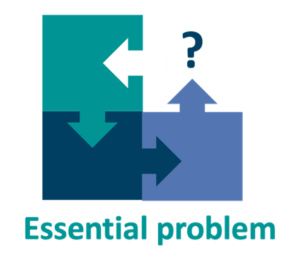
Powers of Ten Approach
The Powers of Ten approach in the Define mode of Design Thinking is a method used to explore and understand the problem space at different scales, magnifying or narrowing the focus to gain deeper insights. This approach draws inspiration from the concept of scale, where the examination of a problem can vary from the broadest perspective down to the minutest details. By systematically zooming in and out, designers can uncover hidden nuances, identify patterns, and develop a comprehensive understanding of the challenges they aim to address.
How the Powers of Ten Approach Works
1. Magnifying the Problem Space: Designers begin by taking a macroscopic view, examining the problem at a broad scale. This involves looking at the overarching system, ecosystem, or environment related to the design challenge. For example, in healthcare design, this might involve considering the entire patient care journey from admission to post-treatment care.
2. Narrowing the Focus: The approach then involves zooming in to a more specific and focused level. Designers explore the immediate context and interactions within a subsystem, seeking to understand the intricacies and details that might be overlooked at a broader scale. In the healthcare example, this could involve examining the specific interactions within the hospital ward.
3. Applying Constraints: To further refine the exploration, constraints are introduced. Constraints act as filters or parameters that guide the investigation and shape the potential solutions. These constraints could be related to budget, time, technology, or specific user needs. For instance, in product design, constraints might include a limited manufacturing budget or a requirement for eco-friendly materials.
4. Iterative Exploration: The Powers of Ten approach is iterative, allowing designers to move back and forth between scales. This iterative process enables a holistic understanding of the problem space while encouraging the discovery of novel insights at different magnitudes. It helps in identifying both macro-level systemic issues and micro-level pain points that contribute to the overall challenge.
Benefits of Using the Powers of Ten Approach
Comprehensive Understanding: By exploring the problem space at multiple scales, designers develop a comprehensive understanding of the complexities involved. This broad view ensures that no critical aspects are overlooked.
Identification of Patterns: Patterns and connections that might not be apparent at a singular scale become evident through the Powers of Ten approach. These patterns contribute to a richer understanding of the problem and potential avenues for solution development.
Informed Decision-Making: The approach aids in informed decision-making by allowing designers to prioritize areas of focus based on the magnitude of impact. It helps in identifying where interventions can be most effective.
Creativity and Constraint Integration: Introducing constraints within specific scales stimulates creative problem-solving. Designers are challenged to find innovative solutions within the given constraints, fostering resourcefulness and creativity.
2×2 Matrix
Through the application of the Define mode of Design Thinking, the utilization of a 2×2 matrix serves as a strategic instrument for the purpose of organizing and displaying observable data, products, services, requirements, interventions, and competitors. In order to provide a structured framework for analysis and decision-making, the matrix gives designers the ability to map items along two dimensions of their choosing. Through the process of charting pieces on this matrix, designers are able to obtain insights into linkages, recognize trends, and prioritize activities.

Steps for Using a 2×2 Matrix
Selecting Dimensions: Designers begin by choosing two relevant dimensions that are essential to understanding the problem space. These dimensions could represent contrasting characteristics or factors critical to the design challenge. For instance, in healthcare design, dimensions might be “Patient Engagement” and “Ease of Access.”
Mapping Items: The observed items, such as user needs, interventions, products, services, and competitors, are then mapped onto the matrix based on the chosen dimensions. Each item is placed in a quadrant that corresponds to its position along the selected dimensions. For example, a user need for streamlined communication might be plotted in the “High Patient Engagement, High Ease of Access” quadrant.
Gaining Insights: The matrix facilitates a visual representation of the relationships between items. Designers can identify clusters, outliers, and trends by observing the distribution of elements across the matrix. Insights gained from the matrix aid in understanding where opportunities, gaps, or areas of improvement exist.
Prioritization and Decision-Making: Once items are plotted, designers can prioritize actions based on their positions in the matrix. Elements in certain quadrants may be deemed high-priority for further exploration or intervention, while others may indicate areas of strength or saturation. This prioritization guides decision-making in subsequent stages of the design process.
Example in Healthcare Design
Consider a healthcare design challenge focused on improving the patient experience. The dimensions chosen are “Digital Interaction Sophistication” and “Personalized Care.” The matrix may include items like mobile health apps, patient feedback systems, nurse-patient communication tools, and competitor offerings. Plotting these elements on the matrix reveals insights into the landscape of digital healthcare solutions, helping designers identify gaps or areas where personalized care can be enhanced.
Quadrant 1 (High Digital Interaction Sophistication, High Personalized Care): Innovative mobile health apps offering personalized treatment plans.
Quadrant 2 (Low Digital Interaction Sophistication, High Personalized Care): Traditional nurse-patient communication tools with room for digital enhancement.
Quadrant 3 (High Digital Interaction Sophistication, Low Personalized Care): Mobile health apps lacking a strong focus on personalized patient experiences.
Quadrant 4 (Low Digital Interaction Sophistication, Low Personalized Care): Basic feedback systems without advanced digital features.
Benefits of Using a 2×2 Matrix:
• Visual Clarity: The matrix provides a visual and structured representation of complex data, making it easier for designers to comprehend and communicate insights.
• Pattern Recognition: Patterns and trends become apparent as items are plotted on the matrix, aiding in the identification of opportunities and challenges.
• Informed Decision-Making: The matrix guides informed decision-making by highlighting areas of focus and prioritizing actions based on the chosen dimensions.
• Collaborative Analysis: The matrix serves as a collaborative tool, allowing design teams to collectively analyze and discuss observations, needs, and interventions in a systematic manner.
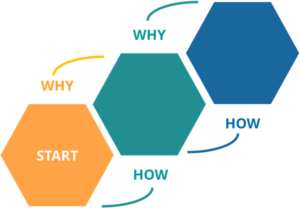
Why-How Ladder
The Why-How Ladder in the Define mode of Design Thinking is a structured approach to exploring the underlying motivations and needs associated with a particular product or service offering. It involves a sequential questioning process, starting with understanding meaningful user needs and progressively drilling down to fundamental or common needs. Subsequently, the process is reversed, climbing back up the ladder by asking how to generate solutions that directly address those identified needs.
Steps in the Why-How Ladder
1. Start with Meaningful User Needs: Begin by identifying and understanding the meaningful needs of the users. These needs are typically associated with their experiences, challenges, and aspirations in relation to a specific product or service.
2. Ask Why: Pose the question “Why is this product or service offering needed?” This initiates a series of inquiries into the underlying reasons and motivations behind the perceived need.
3. Repeat the Why Question: Continue asking “Why?” for each response obtained. This process is iterative and aims to peel away layers of assumptions, uncovering deeper insights into the user’s motivations.
4. Reach Basic or Common Needs: The iterative questioning continues until you reach a level where the identified need becomes fundamental or common. This could be a universal human need that transcends specific contexts or industries.
5. Reverse the Process – Ask How: Once you’ve reached the fundamental need, reverse the process by asking “How can we address this need?” for each layer. This guides the generation of solutions that directly align with the identified user needs.
Example in Healthcare Design
Meaningful User Need: Enhanced Patient Engagement
1. Why is Patient Engagement Needed?
Response: To improve health outcomes and treatment adherence.
2. Why is Improving Health Outcomes Important?
Response: To enhance overall well-being and quality of life for patients.
3. Why is Well-Being Important?
Response: Because it contributes to a sense of fulfillment and happiness.
4. Why is Fulfillment and Happiness Important?
Response: These are fundamental human needs that contribute to a meaningful life.
Reverse Process – Ask How
1. How Can We Enhance Patient Engagement for Well-Being?
Solution: Develop a mobile health app that provides personalized health tips, medication reminders, and a community for shared experiences.
2. How Can the App Improve Overall Well-Being?
Solution: Incorporate features that focus on mental health, stress management, and holistic well-being.
3. How Can Holistic Well-Being Contribute to Fulfillment and Happiness?
Solution: Integrate features that promote mindfulness, goal setting, and connections with support networks.
Benefits of Using the Why-How Ladder
• Deeper Understanding: The iterative process allows designers to delve into the deeper motivations behind user needs, leading to a richer understanding.
• Identification of Fundamental Needs: Reaching fundamental or common needs helps in uncovering universal aspects that can guide solution development.
• Systematic Solution Generation: The reverse process of asking “How” systematically generates solutions that directly address the identified needs.
• User-Centric Solutions: Solutions generated through this process are inherently aligned with the genuine needs and motivations of users, ensuring a user-centric design approach.
In summary, the Why-How Ladder in the Define mode provides a systematic framework for uncovering and understanding user needs and motivations, leading to the generation of solutions that authentically address those needs.
Creating a Point of View Statement
The creation of a Point of View (POV) statement is an essential step in the Define mode of Design Thinking. This statement integrates the empathic understanding that was acquired in the preceding stages of the design process. A vivid and human-centered perspective on the design challenge is provided by the point of view statement, which acts as a guiding beacon for the creation of ideas and solutions.
Steps in Crafting a POV Statement:
1. Use Colorful Language: Infuse the statement with vivid and evocative language that paints a clear picture of the user’s experience. Colorful language helps convey the emotions, challenges, and aspirations associated with the identified problem.
2. Add Details: Provide specific details that flesh out the user’s context, environment, and interactions. The goal is to create a narrative that resonates with the intricacies of the user’s life, making the design challenge more tangible and relatable.
3. Favorite Surprise Moments: Incorporate unexpected or surprising elements that emerged during the empathetic exploration. Highlighting these surprise moments adds an element of discovery and curiosity, contributing to a more engaging and dynamic POV statement.
4. Shifts in Your Own Perspective: Share insights into how your perspective evolved or shifted during the empathetic exploration. Acknowledge moments of personal growth or transformation, emphasizing the dynamic nature of the design process.
5. Major Cause for Change for the End User: Clearly identify a major cause for change that, if addressed, would significantly impact the end user’s experience. This serves as the focal point for solution development and sets the direction for the subsequent stages of the design process.
Example POV Statement in Healthcare Design:
Generic Statement: “Improving Patient Experience in Hospital Settings”
Enhanced POV Statement:
“In the bustling corridors of hospitals, where the rhythm of footsteps echoes the anxiety and hope of countless individuals, we find Maria, a resilient cancer patient navigating a maze of appointments, treatments, and uncertainties. In the quiet moments of waiting rooms, we discovered the profound impact of surprise acts of kindness—nurses who became allies, fellow patients who shared stories of triumph, and unexpected moments of joy that momentarily eclipsed the heaviness of illness.
Our own perspective shifted as we witnessed the resilience of Maria and her peers, realizing that the hospital experience extends beyond medical treatments to the emotional terrain where empathy becomes the most potent medicine. The major cause for change lies in transforming the sterile hospital environment into a haven of warmth and connection, where every interaction is a source of support and every surprise moment a beacon of hope. Addressing this cause will not only redefine the patient experience but also contribute to the holistic healing journey that extends far beyond the clinical walls.”
Benefits of a Compelling POV Statement
• Inspiration for Ideation: A vivid POV statement inspires the ideation process by providing a clear and emotionally resonant perspective on the design challenge.
• User-Centric Focus: The statement keeps the design team grounded in the user’s experience, ensuring that solutions are directly aligned with the identified needs and aspirations.
• Engagement and Empathy: Colorful language and unexpected details create an engaging narrative that fosters empathy among the design team, enhancing their understanding of the user’s world.
• Guidance for Solution Development: The POV statement serves as a guidepost for developing solutions that go beyond functional requirements, addressing the emotional and human aspects of the design challenge.
In essence, crafting a POV statement is an artful process that transforms a generic problem statement into a compelling and human-centered narrative.

Case Study Defining the Challenge: Airbnb
Airbnb was a startup that was having trouble generating sustainable revenue in 2009. At that time, the company went through a paradigm change that drove its change to a global powerhouse organization. Joe Gebbia, one of the company’s co-founders, observed a significant problem: low-quality photographs that impeded the decision-making process of customers. In order to remedy this issue, co-founder Paul Graham embarked on a life-changing journey to New York City, bringing along a professional camera with him there. Airbnb’s weekly revenue increased to $400 as a result of this seemingly basic intervention, which consisted of replacing low-quality images with high-resolution photographs for the purpose of increasing revenue.
image too blurred
Airbnb’s success story is strongly intertwined with design thinking ideas, which can be traced back to Gebbia’s history as a graduate of the Rhode Island School of Design. The company was ultimately able to achieve a revenue of $8.399 billion and operate in approximately 192 countries as a result of this unusual and customer-centric strategy, which promoted a culture of holistic thinking throughout the organization.
One of the reasons that Airbnb has been so successful is because the company has never wavered in its dedication to user-centric design and innovation. Through the process of dissecting the sharing economy into its fundamental components and developing the platform in such a way as to overcome inherent prejudices against strangers, the company took a strategic approach to addressing the difficulty of establishing trust in the sharing economy. In addition to being a co-founder, Brian Chesky is a supporter of a holistic experience strategy, which places an emphasis on one-of-a-kind and unforgettable experiences rather than trans-actional interactions.
The concept of designing to foster trust became an essential approach for Airbnb, which allowed the company to overcome the perceived dangers associated with sharing personal spaces with strangers. It was possible to create ties between hosts and guests through the utilization of reputation systems and the appropriate level of disclosure that the platform provided. The usual five-star rating paradigm is challenged by Chesky’s eleven-star framework, which aims to exceed the expectations of customers and create experiences that have a significant impact.
Airbnb is a great example of the reciprocal relationship that exists between culture and design because of the way that they combine the two. The recruitment process and overall performance are both impacted by a robust culture that is developed through the cultivation of shared values and a collective passion for the mission of the firm. It is clear that the co-founders of Airbnb pay close attention to detail because of their hands-on engagement with hosts. This highlights the fact that not all consumer issues can be resolved just through the use of technology.
The commitment of the company to the user experience is multidimensional, including the incorporation of personalized recommendations, a search interface that is user-friendly, a “Experiences” feature that promotes community interaction, and a pricing mechanism that is clear. The implementation of a user verification system, which helps to contribute to a secure environment, places an emphasis on safety. Airbnb’s incredible growth and success are a testament to the company’s user-centric design philosophy, constant improvement, and commitment to producing experiences that are both functional and emotionally engaging. These factors distinguish Airbnb from its competitors in the dynamic sharing economy. With regards to defining the challenge in the design thinking process, the pivotal moment of Airbnb, understanding what is most relevant to customers and framing a solution around this, stands out as an example of defining the relevant challenge to ultimately unlock value for the company and its customers.

Exercise 1.6
An example is the need for high quality sleep.
An example could be to understand how a device is made and what materials go into it so that the users can be confident that their health will be protected.

Course Manual 7: Ideation
Within the framework of Design Thinking, the Ideate mode places an emphasis on the generation of a plethora of innovative ideas to address the problem that has been recognized. During this phase, it is essential to make use of the collective viewpoints and strengths of your team. This phase requires going beyond solutions that are evident and fostering creativity in order to discover areas of exploration that were not anticipated.

Key Strategies for Ideation
• Drive Innovation: Encourage the team to think outside the box and challenge conventional approaches. Drive innovation by exploring novel concepts and solutions that may not be immediately apparent.
• Uncover Unexpected Areas: Push the team to explore unexpected areas of exploration. This involves venturing into territories that might not align with the initial assumptions, fostering creativity and uncovering unconventional solutions.
• Create Fluency and Flexibility: Generate a high volume of ideas (fluency) and ensure a diverse range of concepts (flexibility). This broad exploration provides a rich pool of options, increasing the likelihood of discovering unique and effective solutions.
• Fluctuate Between Focus and Flare: Recognize the need for both focused idea generation and moments of creative flare. While focused brainstorming sessions can delve into specific aspects of the problem, moments of flare involve allowing the team to let their creativity run wild, generating unexpected and innovative ideas.
• Go Wide During Idea Generation: Idea generation is a moment to “go wide.” Encourage the team to explore a broad spectrum of possibilities without prematurely narrowing down options. This expansive approach allows for the discovery of unconventional and breakthrough ideas.
• Evaluate and Select Later: Emphasize that evaluation and selection of ideas should come later in the process. During the ideation phase, the focus is on quantity and diversity, postponing judgment until a comprehensive set of ideas is generated.
Curtail “Bad” Behaviors: Discourage behaviors that hinder creativity, such as premature evaluation during idea generation. The most outlandish ideas can sometimes serve as catalysts for innovative concepts, so it’s essential to allow for the exploration of unconventional thinking without immediate judgment.
Example Scenario
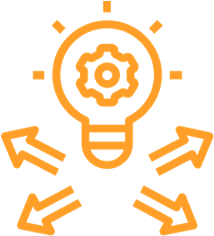
In a design team tasked with improving the waiting experience in a healthcare setting, members might initially generate expected ideas such as comfortable seating or digital entertainment options. To harness collective perspectives, the team can then venture into unexpected areas, exploring concepts like a personalized patient engagement app, a communal art project in waiting areas, or a pop-up wellness station offering mindfulness activities.
Benefits of Collective Ideation
• Diverse Perspectives
Drawing on the strengths of a diverse team brings different perspectives and skill sets to the ideation process, enriching the pool of ideas.
• Innovation and Creativity
Encouraging the team to think innovatively and creatively can lead to groundbreaking solutions that may not have been considered in a more constrained approach.
• Exploration of Outlandish Ideas
Allowing for the exploration of seemingly outlandish ideas can be a catalyst for discovering unconventional and effective solutions.
• Comprehensive Idea Pool
Generating a high volume and variety of ideas provides a comprehensive pool of options to choose from during the later stages of the design process.
• Fostering a Positive Team Dynamic
Collective ideation fosters a positive team dynamic where members feel valued for their contributions, leading to a more collaborative and innovative environment.
In summary, harnessing the collective perspectives and strengths of a team during the Ideate mode involves creating an environment that encourages innovation, explores unexpected areas, and generates a diverse set of ideas. The fluidity between moments of focus and creative flare allows for a holistic exploration of the design challenge, laying the foundation for impactful solutions.
Stoke Activities to Loosen Up and Focus
In the Ideate mode of Design Thinking, stoking activities are employed to foster a creative and open-minded mindset within the team. These activities serve the dual purpose of loosening up team members, removing mental blocks, and enhancing focus on generating innovative ideas. Effective Stoke activities include
• Loosening up: Stoke activities are intended to tear down mental barriers and foster a more relaxed and open attitude. Loosening Up: Stoke activities are designed to achieve just that. The members of the team are able to relax and become more open to thoughts that are more fluid and creative when they participate in activities that are unrelated to the specific problem that is now being addressed.
• Focusing energy: The initial goal of the stoke activities is to create an atmosphere that is light and lively; nevertheless, the activities also serve to direct energy and focus towards the impending brainstorming session. Through participation in these activities, the team is able to shift its attention from routine or inflexible thinking to a condition that is more dynamic and innovative.
• Enhancing creativity: In order to foster creativity, Stoke exercises frequently include elements of play, spontaneity, or surprise. Because of this, individuals of the team may see an increase in their creative output when they participate in activities that stimulate various sections of the brain, which in turn encourages the development of new ideas and views.
• Building Team Cohesion: Participating in such activities as a group can help members of a team develop a sense of camaraderie with one another (also known as “team cohesion”). The presence of this sense of oneness helps to cultivate a constructive dynamic within the team, so producing an environment that is conducive to productive ideation and collaboration.
Stoke activities are intended to tear down mental barriers and foster a more relaxed and open attitude. Loosening Up: Stoke activities are designed to achieve just that. The members of the team are able to relax and become more open to thoughts that are more fluid and creative when they participate in activities that are unrelated to the specific problem that is now being addressed. The initial goal of the stoke activities is to create an atmosphere that is light and lively; nevertheless, the activities also serve to direct energy and focus towards the impending brainstorming session. Through participation in these activities, the team is able to shift its attention from routine or inflexible thinking to a condition that is more dynamic and innovative. In order to foster creativity, Stoke exercises frequently include elements of play, spontaneity, or surprise. Because of this, individuals of the team may see an increase in their creative output when they participate in activities that stimulate various sections of the brain, which in turn encourages the development of new ideas and views. Participating in such activities as a group can help members of a team develop a sense of camaraderie with one another (also known as “team cohesion”). The presence of this sense of oneness helps to cultivate a constructive dynamic within the team, so producing an environment that is conducive to productive ideation and collaboration.
Example Activities:
• Improv Games, Engage the team in improvisational games that encourage quick thinking, spontaneity, and creativity. Improv activities can help team members become more comfortable with expressing ideas without fear of judgment.
• Mindfulness Exercises, incorporate short mindfulness exercises or guided meditation to promote relaxation and mental clarity. This can help team members let go of stress or preconceived notions, creating space for fresh and uninhibited thinking.
• Creative Icebreakers, begin the ideation session with light-hearted icebreakers that involve creativity, such as collaborative drawing exercises, word association games, or storytelling challenges. These activities set a positive tone for the ideation process.
• Change of Environment, conduct stoke activities in a different physical setting, such as moving to an outdoor space or rearranging the workspace. A change of environment can stimulate creativity and provide a break from routine thinking.
Benefits of Stoke Activities
A more open-minded and free-flowing cognitive process can be encouraged through the use of stoke activities, which can lead to increased creativity. Stoke activities can also help people relax and loosen up. Stoke activities serve as a transition phase, assisting members of the team in shifting their focus from normal chores to the impending ideation session. This helps improve focus and spark better ideas. This guarantees that the creative process receives the energy that it needs to function properly. Stoke activities that are light and entertaining lead to a positive team morale, which in turn contributes to an elevated team spirit. Employees on the team report feeling more calm, connected, and driven, which contributes to an environment that is more conducive to collaboration. Reduction in inhibitions, activities that encourage playfulness and spontaneity can help lower inhibitions, which in turn makes members of the team feel more at ease when it comes to expressing ideas that are unconventional or outside the box during the brainstorming process. Enhanced team dynamics, the participation in such activities collectively develops a sense of camaraderie and solidarity among members of the team, hence producing a positive team dynamic that encourages effective collaboration.
Facilitating Brainstorming
One of the most important aspects of the Ideate mode of Design Thinking is the organization of brainstorming sessions. These sessions are designed to encourage cooperation, stimulate creativity, and create an environment that is open-minded that is conducive to the development of ideas. A strategy known as “No Yes, But” is implemented by the facilitator in order to foster an environment that is both positive and welcoming to all. By taking this approach, members of the team are encouraged to resist from quickly discarding ideas with a “but” and instead expand on each concept by making positive contributions. The objective is to establish a culture that is open to a variety of points of view and encourages the development of ideas through collaborative efforts.

During the course of the brainstorming session, the facilitator will set clear goals and objectives in order to maintain the process’s concentration and ensure that it is productive. Assuring that the contributions made by team members are in line with the overall design challenge can be accomplished by providing context for the ideation process. This helps team members comprehend the problem at hand. This direction is necessary in order to establish a setting in which members of the team have the sense that they are encouraged to openly express their opinions. One of the dynamic aspects of facilitation is the management of energy within the group group. The facilitator maintains a heightened awareness of the energy levels of the team, cultivating an atmosphere that fosters passion, positive engagement, and active participation. In the event that the participant’s energy begins to decrease, strategic interventions such as energizing exercises or a change in the format of the session are implemented in order to keep the momentum going.
An additional aspect of good facilitation is the technique of strategically introducing limits into the process of brainstorming. It is possible for constraints to act as a catalyst for innovation by posing a challenge to the team to create solutions that are within the parameters of certain limitations. Nevertheless, it is essential to find a middle ground in order to shield the creative process from being stifled by constraints. When participating in the brainstorming session, it is essential to provide both physical and mental space. An environment that is both well-designed and comfortable provides the type of physical space that is essential for the development of ideas. Concurrently, mental space is provided by reducing interruptions as much as possible, enabling thoughts to flow freely, and cultivating an environment that is conducive to creative thinking. The efficiency of the session can be drastically improved by utilizing a variety of different brainstorming strategies. Methods such as mind mapping allow for the visual exploration of links between ideas, and round-robin brainstorming guarantees that everyone has an equal opportunity to participate. Through the process of role reversal, individuals are prompted to explore the issue from alternative points of view, which increases the likelihood of diverse thinking. The use of silent brainstorming enables for the production of ideas alone before they are shared with the group. This helps to reduce the influence of prejudices and encourages a diverse range of contributions.
It is possible that a facilitator could employ mind mapping in a practical setting, such as the improvement of urban transportation, in order to investigate the interconnected components of their transportation system. Constraints could be implemented, such as the requirement to develop a solution that is compatible with the infrastructure that is already in place. Through the use of the “No Yes, But” strategy, the facilitator makes certain that members of the team collaboratively build upon each other’s ideas. There are a multitude of advantages that the facilitation of brainstorming sessions produces. In order to ensure that the process of ideation investigates a variety of perspectives and possibilities, diverse ideas are taken into consideration and developed. Facilitation that is effective creates an environment that is conducive to collaboration, which in turn encourages members of the team to feel at ease contributing to the collaboration and building on each other’s ideas. There is a continuous motion that is maintained, which helps to prevent stagnation and ensures that ideas flow in a dynamic manner. The whole experience of ideation is improved as a result of the cultivation of positive team dynamics, which results in the establishment of a culture of mutual respect and encouragement. Facilitation, in the end, helps to an environment that is suitable to innovative and creative thinking by controlling energy, introducing limitations in a strategic manner, and offering space.
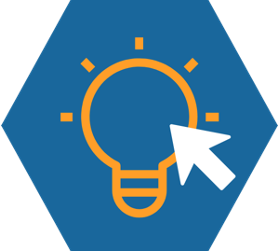
Selecting Brainstorm Ideas
The selection of ideas that were generated through brainstorming is an essential phase in the Ideate mode of Design Thinking. This step requires the utilization of a variety of approaches in order to find concepts that have the potential to be further developed. When it comes to narrowing down the pool of ideas, the employment of various selection methods, such as post-it voting, categorization into four groups, or the application of technologies like Bingo, all play an important part.
Methodologies for Selecting Brainstorm Ideas:
1. Post-it voting is a straightforward yet effective method where team members use sticky notes to vote on their preferred ideas. Each participant has a certain number of votes, and they place their votes on the ideas they find most promising. This democratic process helps prioritize ideas based on the collective preferences of the team.
2. Categorizing brainstormed ideas into four distinct categories is another method. These categories often include “Keep,” “Combine,” “Improve,” and “Discard.” Ideas deemed valuable are kept, potential combinations are explored, improvements are suggested, and less promising ideas are set aside. This systematic approach streamlines the selection process.
3. Bingo is a creative and engaging way to select ideas. A grid is created with different criteria relevant to the project, such as “Digital,” “Physical,” or “Experience Prototype.” Team members select ideas that align with the criteria on their Bingo cards. This method encourages diverse thinking and ensures that ideas cover various dimensions.
4. Digital, Physical, or Experience Prototype: in this approach, ideas are evaluated based on whether they lend themselves to a digital, physical, or experiential prototype. This categorization helps align the selected ideas with the eventual prototyping method, allowing for a more targeted and efficient development process.
Key Considerations in Idea Selection
• Evaluate the feasibility of implementing each idea. Consider factors such as technical feasibility, resource requirements, and alignment with project constraints. This ensures that selected ideas are practical and achievable.
• Align the selected ideas with the overall objectives of the project. Ensure that the chosen concepts contribute to solving the identified problem or addressing the design challenge effectively.
• Assess the innovation potential of each idea. Look for ideas that bring novel and creative solutions to the forefront. Innovation is a key driver of successful design outcomes.
• Prioritize ideas that are user-centric and address the needs and preferences of the target audience. User satisfaction and engagement are crucial for the success of any design solution.
Benefits of Diverse Methodologies:
• Inclusive Decision-Making: diverse methodologies allow for inclusive decision-making, considering different perspectives and criteria for idea selection.
• Engagement and Creativity: Methods like Bingo add an element of engagement and creativity to the selection process, making it more enjoyable for team members.
• Systematic Evaluation: Categorization methods, such as four categories, provide a systematic framework for evaluating ideas based on specific criteria, streamlining the selection process.
• Targeted Prototyping: Categorizing ideas based on their suitability for digital, physical, or experiential prototypes ensures that the subsequent prototyping phase is targeted and aligned with the nature of each idea.
One of the most important steps in the design thinking process is the selection of concepts that were generated through brainstorming. Incorporating a variety of approaches into the selection process, such as post-it voting, categorization, Bingo, or prototype alignment, provides the process with more depth and structure. Design teams are able to identify and prioritize ideas that have the highest potential for developing effective solutions by taking into consideration factors such as feasibility, alignment with objectives, innovation potential, and user-centricity.

Case Study Ideation: Apple’s approach to developing creative ideas
Many people believe that Apple’s success with the iPod and iPhone can be attributed to the company’s skillful application of design thinking. Apple has been catapulted to the forefront of corporate innovation as a result of this approach, which places a priority on the user experience and produces products that combine aesthetic appeal and usefulness through a seamless integration. The business does not simply produce items at will; rather, it engages in a complex ideation process that strictly adheres to three essential criteria: the desirability of the product to the user, the viability of the market, and the capabilities of the technology.
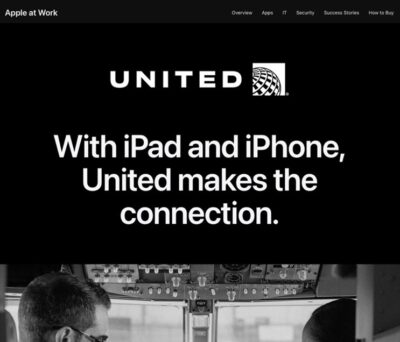
In Apple’s design philosophy, one of the most important tenets is to make sure that the company’s products successfully meet the requirements of its customers. Apple will not continue to develop a product if it is unable to provide users with a solution to an issue that they are experiencing. Concurrently, they do a thorough analysis of the market viability of their ideas, while simultaneously ensuring that there is a discernible need for them. After establishing that the solution does, in fact, solve the problems that the customers are experiencing, this is the next logical step. Apple uses a variety of business models, such as competitive analysis, SWOT analysis, and business model canvases, in order to accomplish this goal. Apple’s final step is to determine whether or not their proposed solutions are technically feasible. This involves ensuring that they have the necessary capabilities to bring the product that they have envisioned into existence.
Apple’s original ideas develop over time through an iterative process, which is contrary to the common belief that breakthrough ideas appear in the form of “eureka!” moments. This is a reiteration of the belief that many of the most brilliant ideas in history have been conceived through the process of brainstorming, experimenting, and ongoing innovation. One of the most important things that can be learned from Apple’s process is the realization that creativity thrives on linking already established patterns and concepts. Steve Jobs expressed it plainly when he said, “Creativity is just connecting things,” highlighting the fact that the power to establish novel connections is within the reach of every single person.
A method known as “Random Entry” was an approach that was frequently utilized by a group at Apple in order to come up with innovative product features. Beginning with a problem statement that is well stated is the first step in this systematic procedure. After then, the group uses strategies called lateral thinking, which were espoused by Edward de Bono, to choose a word at random. The next three minutes are devoted to the process of coming up with thoughts that are associated with the problem statement together with that particular term. The subsequent conversations that took place inside the group assisted in refining and expanding upon these concepts. This repeated activity proved to be extremely helpful in producing a number of ideas that could otherwise go uncovered if more conventional methods were utilized.
In spite of the fact that Apple has established itself as a dominant force in the field of technology, the firm continues to be dedicated to design thinking and ideation. The implementation of these approaches remains an essential component of their innovation process, which guarantees the development of ground-breaking innovations that are adapted for usage in both commercial and personal settings. It is a monument to the persistent strength of design thought in defining the future of technology that Apple has been so successful over the courses of its history.

Exercise 1.7
Team B prioritizes the brainstormed ideas using four categories: pick 1-2 ideas for the following categories: 1. Rational choice, 2. Most likely to delight, 3. Darling, 4. Long shot
• How did the activity to loosen up work for them?
• How did they feel during the brainstorming? What would have helped them during the brainstorming?
• How do they feel after the prioritized ideas?

Course Manual 8: Prototype
Prototyping is a crucial step in the design thinking process, allowing designers to bring their ideas to life in a tangible form. Key components of the prototyping step in design thinking include:

1. Ideation Output Analysis
Rigorous scrutiny of ideation outputs involves categorizing ideas based on feasibility, desirability, and viability. A matrix, such as the Impact-Feasibility Matrix, can be employed to prioritize ideas for prototyping. This phase also involves seeking additional input from diverse stakeholders to ensure comprehensive idea evaluation. In the ideation output analysis phase, the healthcare design team employs decision matrices and impact-effort matrices to evaluate proposed ideas, ensuring alignment with healthcare regulations and optimizing patient experience. For example, when brainstorming ideas to improve patient engagement, the team uses a Decision Matrix to assess the feasibility, impact, and regulatory compliance of introducing a patient-centric mobile app for appointment scheduling and telemedicine consultations. Simultaneously, the Impact-Effort Matrix aids in analyzing the potential of implementing a personalized health dashboard accessible through the patient portal.

2. Low-Fidelity Prototypes
Low-fidelity prototypes take various forms, including hand-drawn sketches, storyboard sequences, and basic paper models. These prototypes focus on core functionalities and layouts. Digital tools such as Balsamiq or Sketch are commonly used for creating quick digital wireframes. The aim is to quickly visualize concepts without investing excessive time or resources. The design team utilizes prototyping tools like Balsamiq to create initial wireframes for the patient portal. These wireframes emphasize the layout, navigation, and key features such as secure messaging and real-time health updates. Similarly, for the mobile app, low-fidelity prototypes are crafted to showcase main screens, with a focus on simplicity, user-friendly navigation, and seamless integration with electronic health records.
3. Iterative Nature
Iteration involves a systematic refinement process. User feedback is gathered through methods like usability testing and interviews. The iterative loop continues as designers refine the prototype based on user insights, addressing pain points and enhancing features in subsequent iterations. The iterative nature of the design thinking process becomes evident during user testing feedback. For the patient portal, iterations involve enhancing appointment scheduling features based on user confusion feedback and ensuring accessibility for users with diverse health literacy levels. In the case of the mobile app, adjustments are made to challenges and educational content based on user engagement data, striking a balance between entertainment and effective health education.

4. User-Centered Design Focus
Prototypes are crafted with the end-users in mind. Techniques like user personas and empathy maps aid designers in understanding user needs. User testing sessions involve real users interacting with the prototype, providing valuable insights into usability, preferences, and potential improvements. Maintaining a user-centered design focus, the team develops personas for diverse user groups. For the patient portal, adaptations include incorporating voice-activated commands and simplified interfaces for elderly patients managing chronic conditions. In the mobile app, demographic-specific features are introduced, such as adjusted interfaces for older users with different needs and personalized health challenges for younger users.
5. Multiplicity of Prototypes
Multiple prototypes cater to diverse aspects of the design challenge. For instance, in digital product design, designers might create prototypes for different user flows or interface variations. This multiplicity allows for A/B testing and the exploration of alternative design solutions. Recognizing the need for a multiplicity of prototypes, the team tailors versions of the patient portal for varying tech-literacy levels. Some versions include comprehensive tutorials for first-time users, while others prioritize intuitive guidance for those familiar with digital healthcare tools. Similarly, different prototypes of the mobile app cater to diverse learning styles, with variations in interactive challenges, health quizzes, and educational content tailored to specific user preferences.

6. Visualization Techniques
Visualization extends beyond simple representation. Storyboards depict user scenarios, while user flows illustrate navigation paths. Physical models may include 3D-printed representations of product concepts. These visualization techniques aid in conveying not just the visual aspects but also the overall user experience. Visualization techniques, particularly storyboarding, are employed to effectively communicate the impact of the prototypes. In the patient portal example, storyboards depict a patient seamlessly navigating through personalized health plans, viewing lab results, and securely communicating with healthcare providers. For the mobile app, a visual narrative showcases a user setting health goals, participating in challenges, and receiving real-time feedback, effectively communicating the intended impact on healthier lifestyles and improved patient engagement.
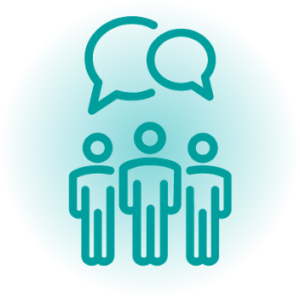
7. Collaboration Hub
Prototyping sessions become collaborative workshops where team members contribute to refining the design. Tools like Miro or MURAL facilitate virtual collaboration. This collaborative approach ensures that diverse perspectives are considered, enhancing the robustness of the prototype. In the ideation output analysis phase specific to healthcare, decision matrices and impact-effort matrices play a crucial role in assessing proposed ideas within the context of healthcare regulations, ethical considerations, and the potential impact on patient outcomes. For instance, when brainstorming ideas for streamlining the medication reconciliation process, the design team uses a Decision Matrix to evaluate different solutions, considering factors such as patient safety, regulatory compliance, and integration with electronic health records. Simultaneously, an Impact-Effort Matrix aids in analyzing the potential impact of implementing a barcode scanning system for medication verification, weighing the benefits against the efforts required for staff training and system integration.
8. Scale of Fidelity
The choice of fidelity level is strategic. Low-fidelity prototypes are suitable for early-stage exploration, emphasizing functionality. As the design matures, higher fidelity is introduced to simulate realistic user interactions. Tools like Figma or Adobe XD allow designers to create high-fidelity, interactive prototypes. Low-fidelity prototypes in healthcare design involves leveraging specialized tools such as Axure RP or Sketch to create wireframes that focus on the specific needs of healthcare professionals and patients. For example, when designing a clinical dashboard for healthcare providers, low-fidelity prototypes emphasize intuitive navigation, real-time data visualization, and integration with decision support systems. In another scenario, for a patient-centered mobile app, the low-fidelity prototypes prioritize simplicity, accessibility features, and seamless connectivity with wearables for tracking vital signs.

9. Testing Hypotheses
Prototyping serves as a hypothesis-testing mechanism. Metrics, such as task success rates and time-on-task measurements, are employed to quantify the user experience. Qualitative feedback, gathered through open-ended questions during usability testing, provides nuanced insights into user perceptions. User testing feedback in healthcare design iterations is critical for refining prototypes. In the case of the clinical dashboard, iterative changes may involve optimizing the presentation of critical patient data based on healthcare provider preferences and clinical workflow. For the patient-centered mobile app, adjustments are made to medication adherence features based on user feedback, ensuring that patients with varying health literacy levels can easily understand and follow prescribed regimens.

10. Embracing Failure as Learning
Failure in prototyping is reframed as an opportunity to learn. Post-iteration retrospectives allow the team to analyze what worked and what didn’t. Failures lead to refinements, ensuring that subsequent iterations benefit from the lessons learned during earlier stages. Maintaining a user-centered design focus in healthcare involves developing detailed personas representing diverse patient populations and healthcare professionals. For the clinical dashboard, personas may include profiles of physicians, nurses, and administrative staff, each with specific needs addressed in the design, such as quick access to patient histories or efficient appointment scheduling. In the case of the patient-centered mobile app, personas reflect different health conditions, ages, and technological literacy levels, influencing features like medication reminders and educational content tailored to individual needs.
11. Materials and Tools
Materials range from physical components for tangible prototypes to digital tools for virtual representations. Depending on the nature of the product, designers might use 3D printing for physical prototypes or tools like InVision for creating interactive digital prototypes. Recognizing the multiplicity of prototypes needed in healthcare design, versions of the clinical dashboard may vary to accommodate different medical specialties. For instance, the dashboard for a cardiology department may emphasize cardiovascular metrics and diagnostics, while a general practice dashboard focuses on overall health indicators and preventive care. Similarly, diverse prototypes of the patient-centered mobile app cater to conditions such as diabetes, with specialized features like glucose tracking and personalized dietary guidance.
12. Feedback Mechanism
Establishing a robust feedback mechanism involves planning and conducting user testing sessions. Protocols for feedback collection, such as usability questionnaires or post-interaction interviews, ensure a structured approach to gathering user insights. This feedback loop is integral to refining the prototype effectively. Visualization techniques, particularly storyboarding, are employed to communicate the impact of prototypes in healthcare settings. Storyboards for the clinical dashboard showcase scenarios where healthcare providers efficiently access patient information, make informed decisions, and collaborate seamlessly. On the patient side, mobile app storyboards illustrate individuals managing chronic conditions, engaging with telehealth services, and experiencing improved health outcomes through personalized interventions. These visual narratives effectively convey the transformative potential of the prototypes within the healthcare landscape.
In summary, the prototyping step is a meticulously planned and executed phase where design teams leverage a variety of techniques, tools, and collaborative approaches to refine their ideas systematically. The emphasis on user-centered design ensures that the resulting solutions resonate with the intended audience.
Key Learnings from Successful Prototyping in Design Thinking
• Early and Iterative Testing: Successful prototyping emphasizes early and iterative testing with end-users. Iterative testing helps identify flaws and areas for improvement at an early stage, preventing major setbacks in later phases. For example, companies like Apple regularly engage in extensive user testing during the prototyping phase to refine their products based on user feedback.
• Cross-disciplinary Collaboration: Collaboration across different disciplines is crucial for successful prototyping. Bringing together individuals with diverse expertise ensures a holistic approach to problem-solving. IDEO, renowned for its design thinking methodologies, often forms interdisciplinary teams that include designers, engineers, and business strategists to foster comprehensive solutions.
• User-Centered Design: The most successful prototypes are rooted in user-centered design principles. Understanding user needs, preferences, and pain points is fundamental. Airbnb’s success, for instance, is attributed to its focus on user experience, which is meticulously considered in the prototyping process.
• Balance Between Fidelity Levels: Striking the right balance between low-fidelity and high-fidelity prototypes is crucial. Low-fidelity prototypes are cost-effective for early testing and ideation, while high-fidelity prototypes provide a more realistic experience for advanced testing. Google follows this approach, starting with low-fidelity wireframes and gradually progressing to high-fidelity prototypes.
• Clear Communication of Ideas: Successful prototypes effectively communicate ideas to stakeholders and end-users. Microsoft, in the development of its products like Windows, ensures that prototypes serve as tangible representations of ideas, facilitating clear communication and feedback loops.
Things to Watch Out for in the Prototyping Step
• Overlooking Diverse Perspectives: One common pitfall is overlooking diverse perspectives during the prototyping process. It’s essential to consider the viewpoints of different user segments, ensuring that the prototype caters to a broad audience. This oversight can lead to products that are not inclusive or user-friendly for all.

• Overemphasis on Perfection: Striving for perfection in the initial stages of prototyping can hinder progress. Perfectionism may lead to delays and missed opportunities for valuable feedback. The philosophy of “fail fast, fail cheap” encourages a mindset that values learning from early mistakes rather than aiming for flawless prototypes.
• Ignoring Technical Feasibility: Prototyping should align with technical feasibility. Overambitious features that are challenging to implement can derail the development process. Companies like Tesla ensure that their prototypes align with both user expectations and the technical capabilities of the available technology.

• Neglecting Scalability: Prototypes should consider scalability for widespread adoption. Neglecting scalability can result in solutions that are impractical for large-scale implementation. For instance, in the healthcare sector, a prototype for a telemedicine platform should consider scalability to accommodate a growing user base.
• Limited User Involvement: Lack of user involvement throughout the prototyping phase is a significant concern. Companies like IBM prioritize user engagement, involving them in various stages of prototyping to align the final product with actual user needs and preferences.
In the dynamic landscape of medtech innovation, the prototyping phase plays a pivotal role in shaping the success of medical devices and solutions. This critical step involves creating tangible models of healthcare technologies, allowing for iterative testing, refinement, and alignment with user needs. Examining three exemplary cases from industry leaders—Medtronic, GE Healthcare, and Philips—illuminates the transformative impact of prototyping in the development of cutting-edge medical solutions. Each case highlights the iterative nature of the prototyping process, emphasizing the iterative feedback loop with end-users, the integration of real-world testing scenarios, and the ultimate optimization of medical technologies for improved patient outcomes. These examples showcase the power of prototyping as a catalyst for innovation in the medtech sector, driving the evolution of user-centered, context-specific healthcare solutions.
1. Medtronic’s Wireless Glucose Monitoring System
Medtronic, a leader in medical technology, developed a wireless glucose monitoring system for diabetes management. The prototyping phase involved creating a user-friendly device that seamlessly integrated with smartphones to provide real-time glucose data. Through iterative testing with diabetic patients, the prototype underwent improvements, focusing on enhancing usability and minimizing discomfort. The final product resulted in a compact, discreet device that significantly improved patient adherence to glucose monitoring. The success highlighted the importance of continuous user feedback in refining medical device prototypes for optimal usability and patient engagement.
2. GE Healthcare’s Portable Ultrasound Prototype
GE Healthcare undertook the development of a prtable ultrasound machine to address challenges in remote and resource-limited healthcare settings. The prototyping phase involved creating a lightweight, durable device that could deliver high-quality imaging. Through extensive testing in various environments, including rural clinics and emergency response situations, the prototype underwent refinements to ensure reliability and ease of use. The final product positively impacted healthcare delivery in underserved areas, emphasizing the role of contextual testing in refining prototypes for specific medical contexts.
3. Philips’ Telehealth Monitoring System
Philips developed a telehealth monitoring system aimed at improving patient care and reducing hospital readmissions. The prototyping process involved creating a user interface for both patients and healthcare providers, emphasizing simplicity and accessibility. The prototype underwent usability testing with elderly patients and healthcare professionals, leading to adjustments in the design to accommodate diverse user needs. The telehealth system’s final version demonstrated significant success, contributing to better patient outcomes and cost savings for healthcare providers. This case underscores the importance of user-centered design in creating effective telehealth solutions through iterative prototyping.
Specific considerations for prototyping in the Pharma and Medtech Sector
Prototyping in the medtech and pharma sectors stands out with distinctive characteristics, shaped by a stringent regulatory environment, unwavering focus on patient safety, and the inherent complexity of healthcare solutions. Adherence to regulatory standards, particularly set by agencies such as the FDA or EMA, is non-negotiable in these industries. Prototyping processes must align with these guidelines to ensure the final product meets rigorous safety and efficacy requirements.
Clinical validation is a pivotal phase unique to medtech prototyping. Unlike many other sectors, medtech prototypes undergo exhaustive testing in simulated or real clinical environments. This rigorous testing involves collaboration with healthcare professionals and patients to gather invaluable insights that contribute to the refinement of the prototype.
Interdisciplinary collaboration is a hallmark of medtech prototyping. The convergence of diverse disciplines, including engineering, healthcare, and regulatory affairs, is essential. Clinicians, bioengineers, and other experts must collaborate closely to address complex challenges and ensure that the prototype aligns with medical standards.
Medtech and pharma industries are characterized by lengthy development cycles. Prototyping is just one phase within an extended process that includes regulatory submissions, extensive clinical trials, and scaling up for manufacturing. Each iterative step must align seamlessly with the comprehensive development plan.
Risk mitigation takes center stage in medtech prototyping due to the critical nature of healthcare solutions. Identifying and resolving potential risks is integral to the iterative process, ensuring not only the efficacy of the prototype but, more crucially, patient safety and regulatory compliance.
Ethical considerations form a significant dimension of medtech prototyping. As prototypes are tested in real healthcare settings, issues related to patient privacy, data security, and consent become paramount. Navigating these ethical considerations is an intrinsic part of the development process in healthcare.
Customization for patient variability is a distinctive aspect of medtech prototyping. Healthcare solutions must be adaptable to diverse patient populations, considering factors such as age, gender, and specific medical conditions. Integrating this adaptability is a crucial consideration in the prototyping process.
In the medtech and pharma sectors, prototyping often involves the integration of new technologies with existing healthcare systems. Compatibility, interoperability, and seamless integration become critical aspects of prototyping to ensure a smooth healthcare workflow. Additionally, the prototyping process extends beyond the pre-market phase, with continuous refinement based on post-market feedback and real-world usage. This approach ensures that devices evolve to meet evolving clinical needs and challenges, reflecting a dynamic and patient-centric approach in the development of healthcare solutions.

Case Study Prototyping: Medtronic’s Wireless Glucose Monitoring System
Medtronic’s Wireless Glucose Monitoring System represents a groundbreaking advancement in diabetes management, offering patients a more streamlined and effective approach to glucose monitoring. This system is particularly noteworthy for its integration of cutting-edge technology to enhance patient convenience and provide healthcare professionals with valuable insights for personalized diabetes care.
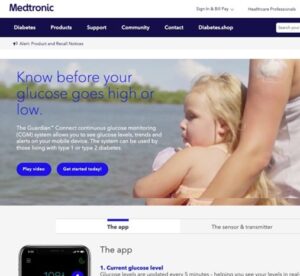
The core of Medtronic’s Wireless Glucose Monitoring System lies in its sensor technology. The system utilizes a small, discreet sensor that is inserted under the patient’s skin, typically in the abdominal area. This sensor continuously measures glucose levels in the interstitial fluid, providing real-time data on the patient’s blood sugar levels. The wireless connectivity of the system allows this information to be seamlessly transmitted to a dedicated device, such as a smartphone or insulin pump, providing users and healthcare providers with instant access to critical data.
One of the key features of this monitoring system is its user-friendly interface. Patients can easily access their glucose data through a smartphone app or a specialized device, fostering a more proactive approach to diabetes management. The real-time data empowers individuals to make informed decisions about insulin dosages, dietary choices, and lifestyle adjustments, leading to better glycemic control.
The wireless connectivity also extends to healthcare providers, enabling remote monitoring and personalized care. With patient consent, healthcare professionals can access the glucose data, allowing for timely interventions and adjustments to treatment plans. This connectivity is especially beneficial in the era of telehealth, facilitating virtual consultations and reducing the need for frequent in-person visits.
Medtronic’s Wireless Glucose Monitoring System excels in promoting patient adherence to monitoring routines. The discreet sensor eliminates the need for frequent fingerstick testing, reducing the discomfort associated with traditional glucose monitoring methods. The continuous nature of the monitoring ensures a comprehensive view of glucose trends, contributing to more nuanced and tailored treatment plans.
Beyond the immediate benefits to patients, the system contributes to long-term health outcomes. The real-time data generated by the sensor allows for the identification of patterns and trends in glucose levels. This information is invaluable for healthcare providers in optimizing insulin therapy, refining dietary recommendations, and addressing lifestyle factors that impact glucose control.
In terms of innovation, Medtronic’s system reflects a commitment to pushing the boundaries of diabetes care. The integration of wireless technology not only enhances the user experience but also positions the healthcare industry to leverage data-driven insights for continuous improvement. The company’s investment in research and development underscores a dedication to advancing the standard of care for individuals living with diabetes.
While the Wireless Glucose Monitoring System represents a significant leap forward, it is essential to consider potential challenges and areas for improvement. Factors such as sensor accuracy, device affordability, and interoperability with other healthcare systems may warrant ongoing attention to ensure the system’s widespread accessibility and effectiveness.
In conclusion, Medtronic’s Wireless Glucose Monitoring System stands as a testament to the transformative potential of technology in diabetes management. By seamlessly integrating wireless connectivity, real-time data, and user-friendly interfaces, the system not only empowers individuals to take control of their health but also establishes new possibilities for remote and personalized healthcare delivery.
Medtronic’s Wireless Glucose Monitoring System stands out as an exemplary illustration of design thinking in action, particularly in the crucial prototyping phase. The development process of this innovative system placed a strong emphasis on user-centric iteration. Multiple versions of the prototype were created and refined based on user feedback, ensuring that the final product resonated with the preferences and needs of individuals managing diabetes. This iterative approach aligns closely with design thinking principles, emphasizing empathy and continuous refinement based on real user experiences.
A key focus during the prototyping stage was the integration of real-time data. The team meticulously tested and refined the wireless connectivity to ensure accurate and reliable transmission of glucose data to user devices and healthcare professionals. The iterative testing of sensor technology was equally vital, addressing challenges related to insertion, longevity, and user comfort. This hands-on, iterative approach allowed the team to enhance wearability and reduce invasiveness, key considerations for a product meant for continuous use in a healthcare context.
The user interface underwent thorough prototyping to optimize the overall user experience. Valuable insights from user feedback on visualizations, alerts, and accessibility features were incorporated into successive prototypes. Additionally, the prototyping process played a critical role in testing and refining remote monitoring capabilities, aligning the system with the evolving landscape of telehealth. Overall, the prototyping phase in the development of Medtronic’s Wireless Glucose Monitoring System not only showcases design thinking principles but also underscores the importance of continuous improvement, technological innovation, and a deep commitment to addressing user needs in the healthcare sector.

Exercise 1.8
– Describe the hypothesis that you want to test.
– Sketch the prototype, the materials and the testing setting.
– List the resources that you need.
– gain empathy
– explore multiple concepts
– test and refine a solution
– gain inspiration

Course Manual 9: Test
The testing step within design thinking plays a pivotal role in the innovation process, extending far beyond a mere evaluation of prototypes. At its core, testing is a user-centric validation mechanism, providing a direct avenue for engaging with end-users to understand their behaviors, preferences, and challenges. Through this interactive process, users become integral co-creators, ensuring that the final solution is not a product of assumptions but a directly validated response to their needs. This user-centric approach is paramount for the success of any innovation, fostering a deep understanding of the target audience and mitigating the risks associated with subjective assumptions.

In addition to user validation, testing serves as a catalyst for refinement and iteration. Unlike a one-time evaluation, testing is an iterative process that involves continuous refinement based on user feedback. Each testing cycle informs the subsequent iteration, leading to a gradual enhancement of the solution. This iterative nature is crucial to prevent design stagnation and ensures that the innovation process remains dynamic, responsive, and adaptable to emerging insights. Through ongoing refinement, the solution evolves towards a state of optimal usability and effectiveness.
Testing is also a proactive strategy for risk mitigation within the design thinking framework. Beyond evaluating positive aspects of a solution, testing delves into potential pitfalls, usability challenges, and unforeseen consequences. By identifying risks early in the process, testing allows for strategic planning to address and mitigate these challenges. This approach fosters resilience in the face of uncertainties, enhancing the overall robustness of the solution. In essence, testing becomes a structured methodology for risk assessment, ensuring that the final product is well-prepared to navigate potential challenges.
Another critical dimension of testing is its role in fostering cross-functional collaboration. Testing is not a siloed activity; it thrives on the convergence of stakeholders from diverse backgrounds, including designers, engineers, end-users, and subject matter experts. This collaborative approach ensures a comprehensive evaluation by incorporating varied perspectives. Engineers provide technical insights, healthcare professionals contribute domain-specific knowledge, and end-users offer invaluable experiential feedback. The synergy of diverse inputs strengthens the overall quality of the solution and promotes a holistic understanding of its potential impact.
Furthermore, testing contributes to data-driven decision-making throughout the design thinking process. The insights generated during testing, ranging from user interactions to performance metrics, provide a robust foundation for informed decision-making. This data-driven approach ensures that decisions are grounded in empirical evidence, enhancing the likelihood of success at every stage of the design thinking journey. Ultimately, the testing phase is not just an evaluation checkpoint; it is a strategic, user-focused, and data-driven endeavor that propels the innovation process towards creating solutions that truly resonate with user needs and expectations.
The key components of the testing step include:
1. User Feedback and Evaluation
User feedback and evaluation are integral components of the testing phase within the design thinking process, especially in the development of healthcare solutions. This method involves collecting direct insights from end-users to gain a profound understanding of their experiences, preferences, and emotional responses. In the context of healthcare, this often entails observing how patients, clinicians, or other stakeholders interact with prototypes or early-stage solutions. The goal is to unearth valuable qualitative and quantitative data that informs the refinement and optimization of the healthcare product.
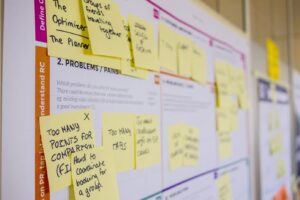
Despite its significance, user feedback has inherent limitations. One challenge is the potential for biased responses, where users might alter their behavior due to the awareness of being observed. Additionally, the articulation of user experiences can be subjective, influenced by personal preferences and expectations. The sample size and diversity of the user pool also pose challenges, as a limited group may not fully represent the broader spectrum of end-users.
Consider the development of a patient monitoring app designed to enhance healthcare outcomes. In this scenario, designers would facilitate interactions with patients, healthcare providers, and possibly caregivers. Users would engage with the app interface, providing feedback on elements such as usability, clarity of medical information, and the overall user experience. For instance, a patient might comment on the intuitiveness of navigating health data, while a nurse could provide insights into the app’s compatibility with existing healthcare workflows. This feedback loop becomes instrumental in refining the app’s features, ensuring it aligns with the diverse needs of both patients and healthcare professionals.
2. Prototyping Refinement
Prototyping refinement stands as a pivotal aspect of the testing step in design thinking, particularly in the realm of medical devices within the healthcare industry. After collecting feedback from users, designers embark on a process of iteratively refining prototypes. This entails making essential adjustments, enhancing functionalities, and addressing any identified issues to elevate the overall design. The goal is to transform initial prototypes into solutions that not only meet regulatory standards but also excel in usability and effectiveness in real-world scenarios.
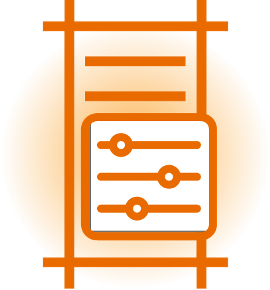
While prototyping refinement is instrumental, there are limitations to consider. Time constraints may pose challenges, especially in industries where regulatory approval processes are stringent. Additionally, overemphasis on refinement based solely on user feedback might inadvertently stifle innovative breakthroughs. Striking the right balance between user-driven improvements and visionary design enhancements is a nuanced challenge.
Designers need to be cautious about overemphasizing individual user preferences at the expense of broader usability and safety considerations. In the context of medical devices, adherence to regulatory requirements and standards is non-negotiable. Balancing the need for rapid prototyping cycles with thorough testing and validation is crucial to avoid compromising the quality and safety of the final medical device.
Consider the development of a surgical robot designed to assist in minimally invasive procedures. After an initial round of testing involving surgeons and operating room staff, feedback is gathered regarding the robot’s ease of use, precision, and integration into existing surgical workflows. Designers, in collaboration with healthcare professionals, refine the robot’s prototype. This refinement process may involve adjustments to the robot’s ergonomics, improvements in the user interface for seamless control, and enhancements to ensure sterile compatibility in a clinical environment. Through multiple iterations driven by feedback, the final prototype evolves into a sophisticated surgical tool that not only addresses the specific needs identified by users but also aligns with regulatory standards for medical devices.
Innovation in Action – Cardiovascular Stent Refinement
In the field of interventional cardiology, the development of a novel cardiovascular stent involves continuous refinement through prototyping. Initially, prototypes undergo testing to assess their deployment accuracy and biocompatibility. Based on feedback from cardiologists and interventionists, refinements are made to the stent design, ensuring optimal navigation through coronary arteries and minimizing the risk of complications. The iterative refinement process plays a crucial role in transforming a basic stent prototype into an advanced medical device that meets both clinical and patient-specific requirements.
3. Iterative Testing
The iterative process is a cornerstone of the testing phase in design thinking, particularly evident in the dynamic landscape of telemedicine platforms within the healthcare industry. Iterative testing involves a cyclical approach, where multiple rounds of prototyping, user testing, and refinement take place. Each iteration builds upon the insights gained from the previous cycle, fostering continuous improvement and alignment with evolving user expectations. This iterative nature is crucial in the fast-paced and ever-evolving field of digital health solutions.
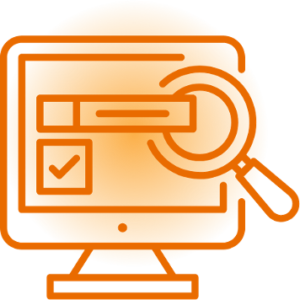
Designers need to be cautious not to fall into the trap of endless iteration without clear goals. Each cycle should have specific objectives, and feedback should be analyzed strategically to drive meaningful refinements. Additionally, the iterative process should not compromise the overall coherence and integration of the telemedicine platform. Striking the right balance between addressing immediate user needs and planning for long-term scalability is essential.
Consider the development of a telemedicine platform aimed at providing remote healthcare consultations. In the initial iteration, the platform’s user interface, security protocols, and features are tested with a select group of healthcare providers and patients. Feedback is gathered regarding the clarity of communication, ease of navigating medical records, and the overall user experience. The iterative cycle begins with the integration of this feedback, leading to refined prototypes for subsequent testing cycles. In each iteration, new features are introduced based on evolving healthcare trends and user requirements, such as enhanced virtual visit features, improved diagnostic tools, and stringent security measures. The iterative testing process ensures that the telemedicine platform aligns not only with immediate user needs but also anticipates future demands in the rapidly evolving landscape of digital healthcare.
Innovation in Action – Enhancing Medication Adherence App
In the context of medication adherence apps, an iterative testing approach is employed to refine a mobile application designed to support patients in adhering to prescribed medication regimens. The initial prototype undergoes testing with a diverse group of patients to assess usability, reminder effectiveness, and overall engagement. Through iterative cycles, feedback is incorporated to enhance features like personalized medication schedules, intuitive reminders, and seamless integration with healthcare providers for real-time monitoring. The iterative process ensures that the app evolves to become a valuable tool in promoting medication adherence, with each cycle addressing specific user needs and technological advancements.
4. Validation Against Objectives
The validation against objectives is a critical step in the testing phase of design thinking, ensuring that the proposed solution aligns seamlessly with the initial goals set during the earlier stages of the design process. In the pharmaceutical industry, this involves rigorous testing, not only to meet regulatory requirements but also to ascertain that the developed solution addresses the predefined objectives effectively. It encompasses a holistic evaluation, incorporating user feedback, clinical data, and alignment with the intended therapeutic outcomes.
One of the primary challenges in the pharmaceutical sector is the complex and stringent regulatory landscape. Validation processes must adhere to regulatory standards, adding layers of complexity and time constraints. Additionally, the nature of drug development involves inherent uncertainties, making it challenging to predict all possible outcomes during the initial stages. This unpredictability can sometimes lead to the need for reassessment and further refinement.
Consider the development of a novel drug delivery system aimed at improving patient adherence and minimizing side effects. During the testing phase, the system undergoes extensive validation against the initial objectives set by the pharmaceutical company. This involves conducting user testing to gather feedback on the ease of use, patient experience, and adherence-enhancing features. Simultaneously, clinical trials are conducted to assess the system’s efficacy in delivering the medication with reduced side effects. The validation process ensures that the developed drug delivery system not only meets regulatory standards but also aligns with the overarching goal of improving patient outcomes. If any discrepancies are identified, the iterative nature of design thinking allows for refinements to address these issues, ensuring that the final solution aligns seamlessly with the initially defined objectives.
5. Cross-Functional Collaboration
Cross-functional collaboration is a cornerstone of the testing phase in design thinking, emphasizing the importance of involving diverse stakeholders such as designers, engineers, end-users, and other relevant parties. In the medtech industry, this collaboration is instrumental in conducting a comprehensive evaluation that incorporates insights from various perspectives. The involvement of professionals from different domains ensures that the developed solution not only meets technical requirements but also aligns with the medical needs and user expectations.

One of the challenges in cross-functional collaboration within the medtech sector is the potential for communication gaps between professionals from different backgrounds. Misinterpretation of technical specifications or clinical requirements can occur, leading to discrepancies in the evaluation process. Additionally, coordinating the schedules of professionals with diverse expertise for collaborative testing sessions can be logistically challenging.
Consider a project focused on developing a state-of-the-art medical imaging device. During the testing phase, cross-functional collaboration becomes paramount. Engineers work closely with healthcare professionals, including radiologists and technicians, to ensure that the technical specifications align with the diagnostic needs of medical practitioners. Simultaneously, end-users, such as patients or healthcare staff, actively participate in testing sessions to provide feedback on the device’s usability and overall user experience. This collaborative approach facilitates a well-rounded evaluation, where the medical equipment is assessed not only for its technical precision but also for its practicality and effectiveness in real-world healthcare settings. The iterative nature of design thinking allows for refinements based on the collaborative feedback, ensuring that the final product achieves a harmonious balance between technical excellence and clinical utility.
6. Risk Identification and Mitigation
One of the crucial aspects of the testing phase in design thinking within the medtech industry is the identification and mitigation of potential risks associated with the proposed solution. Testing serves as a proactive mechanism to assess the reliability, safety, and effectiveness of medical technologies. This involves scrutinizing the solution for possible pitfalls, errors, or challenges that could impact its performance in real-world healthcare scenarios. Strategies are then developed to mitigate these risks, ensuring that the final product meets stringent safety standards and regulatory requirements.
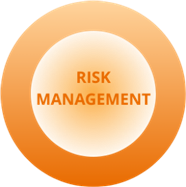
A notable limitation in risk identification and mitigation during testing in the medtech sector is the complexity of anticipating all potential risks. The dynamic nature of healthcare environments and the intricate interplay of variables pose challenges in foreseeing every scenario. Additionally, the stringent regulatory landscape in the medtech industry demands meticulous risk management, adding a layer of complexity to the testing process.
Example – Diagnostic Tool Development
Consider the development of a novel diagnostic tool designed to analyze specific biomarkers for disease detection. During the testing phase, the focus is on identifying risks associated with the tool’s accuracy and reliability. Testing involves exposing the diagnostic tool to a range of conditions that mimic real-world scenarios. Potential errors, such as false positives or negatives, are systematically identified. Mitigation strategies may include the incorporation of fail-safes, error-correction algorithms, or enhanced calibration processes. The iterative testing and refinement process ensures that the diagnostic tool not only meets accuracy standards but also addresses potential risks that could impact its diagnostic precision in clinical settings. This proactive approach to risk identification and mitigation is critical in ensuring the safety and effectiveness of the diagnostic tool when deployed in healthcare practices.
7. Data Collection and Analysis
The testing phase incorporates a meticulous process of data collection and analysis. This involves the systematic gathering of data during the evaluation of medical devices, such as wearable health monitoring devices. The collected data encompasses user behaviors, preferences, and performance metrics of the technology under scrutiny. Subsequently, a comprehensive analysis of this data is conducted to extract meaningful insights. This iterative process plays a pivotal role in refining the functionality, usability, and overall efficacy of the medical technology.

One limitation in data collection and analysis within the medtech sector is the need for stringent privacy and security measures, particularly when dealing with patient-related data. Compliance with healthcare data protection regulations, such as HIPAA in the US, adds complexity to the testing process. Additionally, ensuring the accuracy and reliability of the collected data is crucial for drawing valid conclusions, and any shortcomings in the data collection methods can impact the quality of the analysis. Companies must prioritize the ethical and secure handling of patient data during testing. Implementing robust encryption, anonymization, and de-identification processes are imperative to safeguard patient privacy. Furthermore, validating the accuracy of data collection mechanisms is crucial for drawing reliable insights. Collaboration with data scientists and privacy experts is essential to navigate the intricate landscape of healthcare data governance.
Imagine testing a new generation wearable health monitoring device designed to track vital signs and provide real-time health insights. During the testing phase, the device collects data on various parameters such as heart rate, activity levels, and sleep patterns from a group of users. The analysis of this data involves assessing the accuracy of vital sign measurements and identifying patterns that may indicate potential health conditions. For instance, irregularities in heart rate or deviations from normal sleep patterns could be indicative of health issues. The iterative nature of data collection and analysis allows for refinements in the device’s algorithms, ensuring that it provides accurate and actionable health information to users. This process not only enhances the device’s reliability but also contributes to the development of personalized and effective healthcare solutions.
8. Scalability Considerations
In the dynamic landscape of the biotech industry, the testing phase places a significant emphasis on scalability considerations. This involves a thorough evaluation of how well a biotech solution, particularly digital health platforms, can be scaled up for broader implementation. Scalability testing goes beyond assessing usability; it involves examining the adaptability of the solution to different contexts, user loads, and diverse healthcare settings. The objective is to ensure that the biotech solution maintains its performance and effectiveness as it expands to accommodate a larger user base or additional features.
Companies need to carefully consider the interoperability of their solutions with diverse healthcare ecosystems during scalability testing. Ensuring that the technology seamlessly integrates with electronic health records, diagnostic tools, and other healthcare IT systems is essential. Regulatory compliance must be a central focus, and collaboration with regulatory experts is crucial to navigate the complex landscape of healthcare regulations. Furthermore, anticipating potential bottlenecks and challenges in scaling up is vital to proactively address issues that may arise during broader implementation.
The testing step in design thinking is an ongoing and dynamic process, ensuring that solutions are thoroughly examined, refined, and validated before implementation.

Case Study Testing in Design Thinking: Novo Nordisk Diabetes Pens
Novo Nordisk’s commitment to user-centric design is evident in its extensive usability testing process for diabetes pen development. Recognizing the diverse needs of individuals with varying levels of dexterity and visual acuity, the company went beyond standard assessments. They meticulously observed users during pen interaction, assessing not only the ease of injection but also delving into nuanced aspects like grip comfort, button responsiveness, and auditory feedback. This thorough usability testing aimed not just at functionality but at crafting a holistic, positive user experience.

Novo Nordisk’s dedication to a patient-centric approach extended beyond conventional involvement. Actively engaging individuals with diabetes in the testing process became a co-creative endeavor. These users became collaborators, providing invaluable insights into their daily challenges, preferences, and aspirations regarding insulin administration. This level of engagement ensured that the design and functionality of the diabetes pens resonated with the practical requirements and lifestyle nuances of the target user group.
Specifics of Co-Creation
During usability sessions, Novo Nordisk implemented a co-creation model by conducting collaborative workshops and focus group discussions with individuals from diverse demographic backgrounds. These sessions not only sought feedback on existing prototypes but also involved users in ideation processes, allowing them to contribute ideas for improvements. Novo Nordisk also organized patient advisory boards where users shared their experiences and expectations, directly influencing the refinement of the diabetes pen design.
Addressing Lifestyle Nuances
In addition to standard usability metrics, such as task success rates and error rates, Novo Nordisk’s engagement sessions delved into lifestyle considerations. Users were encouraged to simulate real-life scenarios, such as injecting insulin in crowded environments or during specific daily activities. This approach allowed Novo Nordisk to capture nuanced insights, ensuring that the diabetes pens aligned with users’ practical needs and seamlessly integrated into their daily routines.
Preference Elicitation Techniques
To uncover user preferences, Novo Nordisk employed various elicitation techniques. This included preference ranking exercises, where users prioritized features based on personal importance, and concept testing that involved presenting alternative design options. By actively involving users in decision-making processes, Novo Nordisk ensured that the final product reflected not only functional requirements but also the preferences and priorities of its diverse user base.
Iterative Prototyping with End-User Feedback
Beyond traditional usability testing cycles, Novo Nordisk implemented an iterative prototyping approach with continuous end-user feedback loops. Prototypes were refined based on real-time insights from users, allowing for rapid adjustments to design elements that did not align with user expectations. This collaborative iteration process created a dynamic feedback loop, ensuring that the diabetes pens evolved in direct response to the expressed needs and preferences of the individuals who relied on them.
Understanding the critical role of diabetes pens in healthcare, Novo Nordisk implemented rigorous safety and reliability testing. Beyond meeting standard protocols, the company conducted simulations and real-world scenarios that replicated the complexities of diabetes management. These scenarios assessed the pen’s durability, the accuracy of dose delivery under varying conditions, and preventive measures against potential issues like needle clogging. The paramount focus on safety not only adhered to industry standards but also fostered trust among users.
Acknowledging the diverse real-world scenarios in which the diabetes pens would be used, Novo Nordisk conducted meticulous simulations. These simulations went beyond basic functionality assessments and included testing in low-light conditions, varying temperature ranges, and other environmental variables. This forward-thinking approach ensured the reliability of the pens across diverse settings, reflecting Novo Nordisk’s commitment to addressing the practical challenges of users.
Novo Nordisk adopted an iterative development model, driven by continuous feedback integration from both healthcare professionals and end-users. Regular feedback collection sessions went beyond identifying glitches; they aimed to understand the evolving needs and experiences of users. This iterative process, rooted in active collaboration, addressed challenges faced by users in real-world scenarios and contributed to an ongoing enhancement of the overall user experience with the diabetes pens.
Recognizing the limitations of even comprehensive user testing, Novo Nordisk continued to monitor real-world usage post-launch. This proactive approach allowed the identification of unforeseen issues and the implementation of further improvements. Real-world data, coupled with ongoing user feedback, facilitated continuous refinement and optimization, showcasing Novo Nordisk’s commitment to delivering sustainable solutions.
Novo Nordisk’s enhanced user testing approach for its diabetes pens transcends industry standards. The focus on holistic user experience, patient engagement, safety, and real-world adaptability reflects a commitment to addressing the nuanced needs of individuals managing diabetes daily. This meticulous, user-centric approach contributes significantly to the success and widespread acceptance of Novo Nordisk’s diabetes care solutions in the market.

Exercise 1.9
– the user audience
– the specific testing setting
– what levels of feedback are needed (i.e. actual use experience, look and feel, color and shape preferences, associations, feelings, attitudes)

Course Manual 10: Develop A Portfolio Of Growth Projects
Building on the insights into market-driven and organizational sources of growth, the foundation of the Design Thinking methodology, consolidate a comprehensive list of potential growth ideas. This strategic ideation process involves synthesizing market trends, organizational strengths, and user needs to identify promising avenues for growth. The process builds on what is known based on primary and secondary market research, quantitative and qualitative information about the Needs, Wants and Fears of market participants. The data is consolidated into key insights and supports formulating the main challenge. Portfolio building is a strategic process that involves identifying, prioritizing, and consolidating a set of initiatives or opportunities to achieve specific business objectives. In the context of industries such as pharma, biotech, and medtech, where innovation is paramount, effective portfolio building is critical for sustained growth, competitive advantage, and addressing evolving market needs.

At its core, portfolio building entails systematically evaluating and selecting initiatives or projects that align with the organization’s goals. This involves considering various factors, including market trends, user needs, organizational strengths, and potential risks. The goal is to create a well-balanced portfolio that addresses both short-term objectives and long-term strategic priorities.
Several methodologies play a crucial role in the process of portfolio building, each with its unique strengths and considerations. Decision matrices, scoring systems, and collaborative workshops are common tools employed by organizations seeking to create a strategic and well-balanced portfolio.
1. Decision matrices provide a structured and systematic approach to evaluating and ranking opportunities. In this methodology, predefined criteria such as market potential, feasibility, and alignment with organizational goals are established. Each opportunity is then evaluated against these criteria, often using a numerical scale. The decision matrix offers objectivity and clarity, making it particularly suitable for data-driven decision-making. However, one limitation is the potential oversimplification of complex factors, and it may lack the depth of qualitative insights required for certain nuanced decisions.
2. Scoring systems involve assigning numerical values to different aspects of each opportunity, facilitating quantitative comparison. This methodology allows for a more detailed and granular assessment of the potential benefits and risks associated with each option. Scoring systems offer objectivity and clarity, making them suitable for quantitative comparison. Yet, similar to decision matrices, they may fall short in capturing the full spectrum of qualitative insights, potentially oversimplifying the decision-making process.
3. Collaborative workshops involve group discussions and collective decision-making, ensuring diverse perspectives are considered. This methodology recognizes the value of qualitative insights and promotes a holistic approach to decision-making. It is particularly effective in capturing nuanced considerations and addressing complex, multifaceted opportunities. However, collaborative workshops can be time-consuming, and outcomes may be influenced by group dynamics, requiring skilled facilitation to maintain focus and objectivity.
The choice of methodology depends on various factors, including the organization’s culture, the nature of the opportunities under consideration, and the desired level of detail in the decision-making process. For organizations where a quantitative, data-driven approach is essential, decision matrices and scoring systems may be favored. In contrast, those valuing qualitative insights and seeking a more holistic view may lean towards collaborative workshops. Some organizations may even opt for a combination of these methodologies to leverage the strengths of each and mitigate their respective limitations.
Portfolio management is a dynamic approach that facilitates decision-making, aligns the organization, and unifies decision-makers around a shared set of criteria. By systematically organizing and evaluating projects or opportunities, portfolio management ensures that resources are allocated efficiently, risks are managed effectively, and strategic objectives are met. Here are key aspects and examples of best practices in using portfolio management for decision-making and organizational alignment:
Resource Optimization: Portfolio management serves as a crucial tool in aiding organizations to optimize the allocation of resources, ensuring that investments align strategically with business goals. For instance, a pharmaceutical company might leverage portfolio management to strike a balance between investments in research and development. This approach ensures a mix of short-term product enhancements to address immediate market needs and long-term innovative projects that contribute to the company’s future growth and competitiveness.
Risk Management: In the complex landscape of the biotech industry, portfolio management plays a pivotal role in the systematic assessment and mitigation of risks associated with various projects or initiatives. Consider a company managing a portfolio of drug development projects; here, diversifying investments becomes a strategic approach. By spreading investments across different projects, the company can effectively mitigate the inherent risks tied to clinical trials, regulatory approvals, and uncertainties in the highly dynamic biotech sector.
Strategic Alignment: One of the fundamental benefits of portfolio management lies in aligning projects with the overall strategic direction of the organization. This ensures that each initiative contributes meaningfully to the achievement of broader objectives. For instance, a medtech company specializing in digital health solutions might employ portfolio management to align its projects with the strategic goal of becoming a leader in remote patient monitoring technologies. This strategic alignment enhances the company’s competitiveness and market positioning.
Decision-Making Criteria: Establishing clear criteria for decision-making is a hallmark of effective portfolio management, ensuring that all stakeholders share a common understanding when evaluating and prioritizing opportunities. A healthcare organization, for example, could implement portfolio management by defining criteria such as market potential, technological feasibility, and alignment with patient needs. These predefined criteria become guiding principles that facilitate informed decision-making across the organization.
Organizational Alignment: Portfolio management is a unifying force that fosters alignment by providing a unified view of the organization’s initiatives and their impact on overall performance. Take the example of a biopharmaceutical company aligning its portfolio with sustainability goals. In this scenario, the company might prioritize projects that not only contribute to business growth but also adhere to environmentally friendly practices. This holistic approach ensures that the organization’s initiatives are in harmony with its broader mission and values.
Performance Monitoring: Regularly monitoring and assessing portfolio performance is a key practice facilitated by portfolio management. This ongoing evaluation ensures that adjustments can be made to align with evolving organizational strategies. For instance, a medtech firm utilizing portfolio management may conduct periodic reviews to assess the success of product launches. This enables the company to make quick adjustments in resource allocation based on market feedback, enhancing its responsiveness and adaptability in a dynamic industry landscape.
1. List the Growth Opportunities
The fundamental idea behind listing growth opportunities is to cast a wide net that encompasses potential avenues for organizational advancement. This step aligns with the foundational principle of Design Thinking, encouraging a holistic exploration of possibilities. By synthesizing insights from market trends, organizational strengths, and user needs, the rationale is to create a comprehensive pool of growth prospects. This process facilitates a nuanced understanding of the landscape, identifying areas where the organization can thrive and innovate.

The preferred methodology involves a multi-faceted approach to information gathering. Market research, encompassing both primary and secondary data, is crucial to understanding external dynamics. Analyzing industry trends provides insights into the broader landscape. Additionally, engaging with internal stakeholders, including employees, leadership, and subject matter experts, offers a nuanced perspective on organizational capabilities. This collaborative methodology ensures a well-rounded compilation of growth opportunities.
Diversity in identified opportunities is a key focal point. Striking a balance between incremental improvements and transformative innovations is vital for a holistic approach. This attention to diversity ensures that the organization considers both short-term optimizations and long-term strategic shifts. Moreover, attention should be given to potential biases in the data and perspectives collected during this stage. Seeking a broad range of inputs contributes to a more inclusive and accurate list of growth opportunities.
2. List the Prioritization Criteria
The idea behind prioritizing growth opportunities is rooted in strategic focus and resource optimization. Rather than pursuing all identified avenues simultaneously, prioritization ensures a targeted approach, directing efforts toward the most promising initiatives. The rationale is to align prioritization criteria with the specific context, emphasizing factors such as user needs, market trends, and organizational strengths. This strategic alignment aims to enhance the likelihood of success by concentrating resources where they can have the most significant impact.
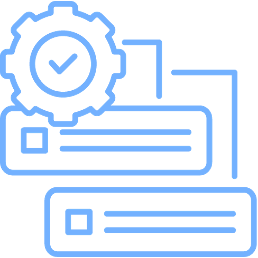
Conducting workshops or collaborative sessions is the preferred methodology for defining and selecting prioritization criteria. These sessions facilitate cross-functional input, ensuring a diverse range of perspectives. Tools like SWOT analysis (Strengths, Weaknesses, Opportunities, Threats) can be instrumental in this process, providing a structured framework for evaluating internal and external factors. The collaborative nature of this approach enhances collective ownership of the prioritization criteria.
Balancing quantitative and qualitative criteria is crucial during prioritization. While quantitative data provides measurable insights, qualitative considerations capture nuanced aspects that may not be quantifiable. Striking a balance ensures a comprehensive evaluation. Additionally, the consideration of both short-term gains and long-term strategic alignment is essential. This dual perspective guards against overly focusing on immediate returns at the expense of sustained organizational growth. Finally, attention should be given to potential biases in the prioritization process, and mechanisms should be in place to mitigate them.
3. Verify Information Availability
Verifying information availability is grounded in the necessity for well-informed decision-making. In the complex landscape of growth opportunities, incomplete or unreliable information can significantly impact the quality of decisions. The rationale is to ensure that decision-makers have access to a robust and comprehensive dataset. This step acts as a safeguard against the risks associated with inadequate information, promoting accuracy and reliability in the decision-making process.
Conducting a thorough audit of available data from both internal and external sources constitutes the preferred methodology. This involves evaluating the reliability and relevance of existing data and identifying potential data gaps. Additionally, it may necessitate additional research efforts to fill these gaps. A systematic approach to data verification enhances the credibility of the information used for decision-making.
Special attention should be given to potential biases in the available data. Biases can stem from various sources, including the method of data collection or the inherent perspectives of those involved in generating the data. Diverse perspectives should be sought to validate information and mitigate biases. Additionally, the timeliness of the data is crucial; outdated information may not accurately reflect the current landscape. Therefore, a balance between comprehensiveness and timeliness is essential in the verification process.
4. Develop Compelling Point of View Statements
Crafting compelling Point of View (POV) statements is essential to articulate the essence of each growth opportunity. The rationale lies in the need for clear and impactful communication, as well as facilitating effective decision-making. A well-crafted POV statement serves as a concise narrative that encapsulates the unique value proposition of a growth idea, setting the stage for alignment, understanding, and engagement.

Utilizing ideation sessions and collaborative workshops is the preferred methodology for developing POV statements. These sessions provide a platform for diverse perspectives, encouraging creativity and clarity in expressing the distinctive qualities of each growth opportunity. The interactive nature of workshops allows for the refinement of language and messaging to ensure that the POV resonates effectively with stakeholders.
Special attention should be given to ensuring that POV statements are not only clear but also resonate with the intended audience. The language used should be accessible to diverse stakeholders, avoiding jargon that might hinder understanding. Additionally, the human-centered focus of the growth idea should be evident in the POV statements. It is crucial to strike a balance between conciseness and inclusivity, making sure that the essence of the opportunity is captured without overwhelming the audience with unnecessary details.
5. List Key Stakeholders and Prioritize
The idea is to identify and prioritize key stakeholders who will play a crucial role in influencing or being influenced by the growth opportunities. The rationale is grounded in the importance of taking a targeted approach to understanding diverse perspectives. Recognizing the significance of stakeholders in the decision-making process ensures that efforts are focused on those who can contribute meaningfully to the success of growth initiatives.

Creating stakeholder maps and engaging in stakeholder analysis constitutes the preferred methodology for identifying and prioritizing key stakeholders. Stakeholder maps provide a visual representation of the relationships and influences, aiding in the identification of individuals or groups with the most significant impact. Prioritization can be achieved by assessing both the influence and interest of stakeholders in the growth opportunities.
Special attention should be paid to considering both internal and external stakeholders. Internal stakeholders may include employees, managers, and executives, while external stakeholders may involve customers, partners, and regulators. Additionally, being mindful of power dynamics within the organization is crucial. Understanding the influence and interest of each stakeholder helps in tailoring communication strategies and engagement approaches to ensure effective collaboration and alignment.
6. Locate Opportunities on the Customer Journey
Placing growth opportunities on the customer journey yield clarity and insights into their impact at different touchpoints. This approach is grounded in the rationale that understanding the customer journey is essential for identifying potential synergies and interdependencies between growth opportunities. By mapping opportunities to specific stages of the customer experience, businesses can align strategies with the needs and expectations of their target audience.
The preferred methodology for this step is customer journey mapping. This visual representation allows organizations to see how each growth opportunity aligns with the customer’s end-to-end experience. It provides a comprehensive view of the customer’s interactions with the brand, enabling businesses to identify areas of overlap and integration possibilities.

Special attention should be paid to ensuring a holistic view of the customer journey. This includes considering the entire customer lifecycle, from the initial awareness and consideration phases through the purchase decision and post-purchase stages. A comprehensive understanding of the customer journey ensures that growth opportunities are strategically placed to enhance the overall customer experience.
7. Evaluate Opportunities for Key Stakeholders
Assessing how each growth opportunity aligns with the needs and expectations of key stakeholder groups involves adopting their perspective and looking at an opportunity through their lense. This evaluation is grounded in the rationale that understanding stakeholder perspectives is crucial for ensuring that selected initiatives resonate with diverse views and priorities. By considering the interests of various stakeholders, businesses can enhance the strategic alignment of growth opportunities.
The preferred methodology for this step includes conducting surveys, interviews, or focus groups with key stakeholders to gather insights. Using predefined criteria, businesses can systematically evaluate the suitability of each growth opportunity for different stakeholder groups.
Special attention should be paid to acknowledging and addressing potential conflicts or trade-offs between stakeholder interests. Not all stakeholders may have identical priorities, and identifying areas of alignment or potential tensions is essential for making informed decisions. Balancing diverse stakeholder perspectives ensures that the chosen growth opportunities contribute positively to the overall organizational strategy.
8. Consolidate into a Portfolio
The idea involves consolidating the list of growth opportunities and stakeholder perspectives to create a well-balanced portfolio. This step is driven by the rationale that a comprehensive portfolio should reflect strategic alignment, feasibility, and a holistic view of potential impact. By consolidating, businesses can streamline decision-making and create a roadmap that considers various dimensions crucial for success.
The preferred methodology for this step includes facilitating a decision-making workshop or strategy session. Decision matrices or scoring systems can be employed to objectively rank and prioritize growth opportunities, ensuring a systematic and data-driven approach.

Special attention should be paid to ensuring that the final portfolio reflects a mix of short-term wins and long-term strategic initiatives. Balancing the portfolio in this way ensures that the organization can derive immediate benefits while also working towards its overarching goals. Additionally, it’s essential to regularly revisit and update the portfolio based on evolving priorities and market dynamics, maintaining its relevance and effectiveness over time.
Stakeholder Validation for Informed Decision-Making: the stakeholder perspective is a crucial checkpoint in identifying and confirming growth projects. Participants view the list of growth ideas from the perspective of key stakeholders, including patients, caregivers, and healthcare professionals. Specifically, they seed solutions that reduce the negative experience, increase the focus on the positive, question assumptions, explore opposites and identify unexpected resources. This validation process ensures that the proposed growth projects resonate with the diverse needs and expectations of stakeholders, hence contributing to informed decision-making and strategic alignment. The output is a first list of growth opportunities, arranged along the customer journey to keep the user experience at the center.
Best Practices that have resulted in sustained implementation of portfolio management:
• Clearly Defined Objectives: Clearly articulate the strategic objectives that the portfolio aims to achieve.
• Cross-Functional Collaboration: Encourage collaboration among different departments and teams to ensure a comprehensive understanding of the organization’s goals.
• Regular Reviews: Conduct regular reviews and updates to adapt the portfolio to changing market dynamics and organizational priorities.
• Data-Driven Decision-Making: Utilize data and analytics to inform decision-making and objectively evaluate project performance.
• Stakeholder Involvement: Involve key stakeholders in the portfolio management process to ensure diverse perspectives and alignment with organizational goals.

Case Study portfolio of growth ideas: Johnson & Johnson
Johnson & Johnson (J&J), a renowned global healthcare conglomerate with a rich history spanning pharmaceuticals, medical devices, and consumer health products, has been lauded for its robust portfolio management strategies. J&J’s holistic approach to portfolio management is characterized by diversification, strategic acquisitions, and collaborative partnerships, contributing to its resilience in a dynamic and challenging healthcare landscape.
Image too blurred
Diversification Across Healthcare Segments
J&J’s portfolio strength lies in its diversified presence across multiple healthcare segments. By operating in pharmaceuticals, medical devices, and consumer health, the company strategically distributes its risk exposure. This diversified portfolio allows J&J to weather challenges specific to one segment while capitalizing on growth opportunities in others. The synergy between these segments creates a balanced and comprehensive portfolio that caters to a wide spectrum of healthcare needs.
Strategic Acquisitions for Portfolio Enhancement
A standout feature of J&J’s portfolio management is its proactive approach to strategic acquisitions. In 2017, J&J completed the acquisition of Actelion, a Swiss biopharmaceutical company specializing in pulmonary hypertension treatments. This move was aligned with J&J’s broader strategy to expand its pharmaceutical offerings and solidify its position in therapeutic areas with unmet medical needs. The Actelion acquisition not only added valuable products to J&J’s portfolio but also brought in expertise and capabilities crucial for addressing specific healthcare challenges. In the long run the return on investment of this particular decision was not supported. However, it added crucial rare disease capabilities to J&J early in the cross-industry trend to move into more focused indications, following the science.
Mitigating Risks Through Collaborative Ventures
Beyond acquisitions, J&J places a strong emphasis on collaboration to enhance its portfolio. Partnerships with other industry leaders or emerging companies provide access to external innovations, novel technologies, and specialized expertise. Collaborative ventures allow J&J to stay at the forefront of advancements without solely relying on internal research and development efforts. This approach not only mitigates risks associated with in-house innovation but also fosters a culture of continuous learning and adaptation.
Impact on the Pulmonary Hypertension Franchise
The Actelion acquisition significantly influenced J&J’s pulmonary hypertension franchise. This therapeutic area, while niche, presented an opportunity for J&J to address critical medical needs. By integrating Actelion’s product portfolio and expertise, J&J strengthened its position in the pulmonary hypertension market. The strategic move exemplifies how a targeted acquisition can complement existing capabilities, broaden the portfolio, and enhance the company’s ability to meet diverse healthcare challenges.
Long-Term Success and Adaptability
J&J’s commitment to robust portfolio management has been a key driver of its long-term success and adaptability. The company’s ability to navigate industry complexities, seize opportunities in diverse markets, and strategically enhance its portfolio positions it as a resilient force in the healthcare sector. J&J’s portfolio management approach serves as a testament to the importance of strategic foresight and dynamic adaptation in the ever-evolving healthcare industry.
Conclusion
In conclusion, Johnson & Johnson’s case is a compelling example of effective portfolio management in the healthcare industry. By fostering diversification, engaging in strategic acquisitions, and embracing collaborative partnerships, J&J has established a resilient and adaptive portfolio that aligns with its overarching mission of advancing health and well-being worldwide. This strategic approach continues to be instrumental in J&J’s enduring success and its ability to contribute meaningfully to global healthcare.

Exercise 1.10
• Incremental
• Substantial
• Disruptive

Course Manual 11: Create A Growth Opportunity Map
Opportunity mapping, a strategic process crucial for identifying growth prospects, employs various methodologies that collectively provide a comprehensive understanding of an organization’s position within its market. An essential aspect is the identification and articulation of the business challenge, paving the way for a comprehensive understanding of the problem space. Conducting a SWOT analysis, which assesses internal strengths and weaknesses alongside external opportunities and threats, allows organizations to align growth opportunities with their inherent capabilities. PESTLE analysis broadens the scope by evaluating political, economic, social, technological, legal, and environmental factors, offering insights into the external environment that might influence opportunities. Extensive market research and trend analysis contribute by uncovering evolving consumer behaviors and industry patterns, ensuring that organizations are well-informed about potential areas for development. Actively engaging with customers through feedback mechanisms and surveys ensures that growth opportunities align closely with the preferences and needs of the target audience, fostering customer-centric innovation.

Competitor analysis is crucial for identifying gaps in the market, allowing organizations to differentiate themselves or target underserved segments effectively. Technology scanning and innovation assessments aid in recognizing opportunities associated with technological advancements, a vital consideration in industries characterized by rapid technological evolution. Scenario planning assists organizations in preparing for various future possibilities, helping them develop strategies resilient across different scenarios. Collaborative workshops and ideation sessions are instrumental in fostering creativity and leveraging diverse perspectives within cross-functional teams. Additionally, data analytics and machine learning play a pivotal role in the modern landscape, allowing organizations to derive actionable insights from vast datasets. Finally, risk assessment and mitigation strategies are integral to the opportunity mapping process, enabling organizations to proactively address challenges associated with potential opportunities.
By utilizing a combination of these methodologies, organizations can conduct a thorough and tailored opportunity mapping process. This approach ensures that they are well-positioned to capitalize on emerging trends, align with consumer preferences, and navigate the complexities of their external environment effectively.
The concept of a growth opportunity map has evolved significantly over time, adapting to the changing dynamics of business environments and advancements in strategic thinking. Initially, growth opportunity maps were often simplistic and primarily focused on identifying market gaps or areas where a company could expand. However, as businesses faced increasing complexity and globalization, the need for a more comprehensive and nuanced approach became apparent.
Integration of Technology and Data Analytics: With the rise of technology and the digital age, growth opportunity maps now heavily incorporate data analytics, allowing organizations to leverage big data for more informed decision-making. Advanced analytics enable companies to identify patterns, trends, and potential growth areas with greater precision. This evolution has made growth opportunity mapping more data-driven, enabling organizations to move beyond intuition and gut feeling. It facilitates a more thorough understanding of customer behaviors, market trends, and competitive landscapes.
Customer-Centric Focus: Traditionally, growth opportunity maps were centered around market expansion. Over time, there has been a shift towards a more customer-centric approach. Understanding and meeting customer needs have become central to identifying growth opportunities. This shift has led to more sustainable and resonant growth strategies. Companies now prioritize creating products and services that genuinely add value to customers’ lives, fostering long-term relationships and loyalty.
Incorporation of Sustainability and Corporate Social Responsibility (CSR): In recent years, there has been a growing emphasis on sustainability and CSR. Modern growth opportunity maps consider the environmental and social impact of business activities. Companies are increasingly aligning growth opportunities with sustainable practices, recognizing that environmentally and socially responsible strategies can enhance brand reputation and appeal to a broader consumer base.
Agile and Iterative Approach: Traditional growth opportunity mapping often followed a linear and rigid process. Today, there is a shift towards a more agile and iterative approach. Companies recognize the need to adapt quickly to changing market conditions. This agile approach allows organizations to test and refine growth strategies continuously. It facilitates a more dynamic response to market feedback and emerging trends, ensuring relevance and competitiveness.
Globalization and Geopolitical Considerations: With increased globalization, growth opportunity maps now consider geopolitical factors that can impact business operations. Companies need to navigate complexities related to international markets, trade policies, and geopolitical tensions. A more globalized perspective enables organizations to identify growth opportunities not only in domestic markets but also on a broader international scale. It requires a nuanced understanding of diverse cultural, political, and economic contexts.
Developing a Growth Opportunity is characterized by a number of approaches and capabilities required in an organization.
1. A Comprehensive Analysis of the Market
An in-depth analysis of the current market environment is the first step in the process of opportunity mapping. Performing this requires analyzing the trends in the industry, the activity of competitors, and the dynamics of emerging markets. Organizations are able to not only recognize opportunities that are currently available but also forecast trends that may emerge in the future if they undertake a comprehensive market analysis. The adoption of this forward-thinking approach enables firms to strategically position themselves in the market and capitalize on the ever-changing requirements of their customers.
2. An approach that is customer-centric
At the core of opportunity mapping is a profound comprehension of the requirements of the target audience. This involves applying a variety of approaches, such as surveys, interviews, and data analytics, in order to gather insights into the preferences, pain points, and behavior of customers. An approach that is centered on the client guarantees that the opportunities that have been found are in line with the requirements of the audience that is being targeted. This helps to cultivate better connections and increases the possibility that the product or service will be successfully adopted.
3. Leveraging the Capabilities of the Organization
Opportunity mapping necessitates conducting an accurate evaluation of the capabilities that are already present inside an organization. Assessing one’s strengths, limitations, and distinguishing competencies is a necessary step in this process. Businesses have the ability to achieve a competitive advantage by capitalizing on their core strengths by aligning growth possibilities with their existing competencies or capabilities. It is also possible that this approach will involve strategic investments in infrastructure, talent, or technology in order to improve capabilities in areas where they are required.
4. Innovating in Response to Emerging Trends
Not only does successful opportunity mapping take into account the current state of the industry, but it also takes into account and prepares for future trends. Organizations have to make investments in research and development, keep up with the latest technology breakthroughs, and cultivate a culture of innovation in order to stay ahead of the curve. With this forward-looking view, businesses are able to take the lead in their respective industries by proactively tackling new issues and making the most of fresh opportunities.
5. Methods for Reducing the Impact of Risk
In the process of exploring new prospects, companies need to be aware of the inherent risks that are there. The creation of effective risk mitigation techniques is a component of opportunity mapping. In order to accomplish this, it is necessary to carry out exhaustive risk assessments, plan for various scenarios, and build contingency plans. It is possible for enterprises to handle uncertainty more successfully and protect their assets if they identify and address risks immediately after they are identified.
6. Strategic Alignment
There is a strong connection between the strategic goals and vision of the organization and the process of opportunity mapping. One must have a comprehensive comprehension of the organization’s mission, vision, and long-term objectives in order to do this. In order to guarantee that the pursuit of possibilities adds to the overall success of the business, it is imperative that each and every growth opportunity that has been discovered aligns flawlessly with these different strategic elements.
7. Capacity for Adaptation and Flexibility
Opportunity mapping requires flexibility and adaptability in order to be successful in a corporate environment that is constantly shifting. Organizations have a responsibility to acknowledge that variations in market conditions may need the modification of plans. This adaptability guarantees that the selected chances for growth will continue to be relevant and robust in the face of changing obstacles.
8. Iterative and Continuous Evaluation of Performance
The process of opportunity mapping is not a one-time event; rather, it is a process that is continual and iterative. The performance of selected opportunities must be regularly evaluated by organizations, feedback must be gathered, and improvements must be made to the techniques that they employ. This iterative technique makes it possible to make adjustments in real time, which guarantees that the organization will continue to be adaptable and responsive to the ever-changing dynamics of the market.
In conclusion, opportunity mapping serves as a strategic compass for organizations navigating the complexities of the business landscape. By conducting a holistic market assessment, adopting a customer-centric approach, leveraging internal capabilities, anticipating future trends, implementing risk mitigation strategies, aligning with strategic goals, embracing flexibility, and engaging in continuous evaluation, opportunity mapping empowers organizations to make informed decisions, capitalize on growth potentials, and stay ahead in a competitive marketplace.
Opportunity prioritization
This is a critical step in the growth opportunity mapping process, aiming to focus resources on initiatives with the greatest strategic significance and potential impact. The first step involves developing clear and well-defined criteria for prioritization. These criteria may encompass a range of factors, including market potential, organizational capabilities, alignment with strategic goals, and feasibility within the current business context. Once the criteria are established, each growth opportunity is systematically scored against them, often using a numerical scale. This scoring process allows for a quantitative assessment of each opportunity’s merits.
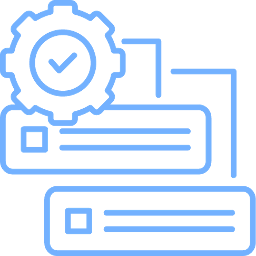
Subsequently, the opportunities are ranked based on their cumulative scores. This ranking provides a structured hierarchy that helps decision-makers identify the most promising initiatives that align closely with the organization’s objectives. The objective scoring and ranking approach enhance objectivity in the decision-making process, ensuring that subjective biases are minimized. By employing this method, organizations can strategically allocate resources, both human and financial, to initiatives that offer the highest potential for success. This systematic and data-driven approach to opportunity prioritization contributes to more informed decision-making and helps organizations pursue growth avenues that align with their overarching business strategy.
SWOT Analysis of Prioritized Opportunities
The SWOT analysis of prioritized opportunities constitutes a pivotal phase in the growth opportunity mapping process, aiming to comprehensively comprehend the internal and external dynamics of each identified initiative. The primary objective is to conduct a detailed analysis, encompassing the strengths, weaknesses, opportunities, and threats associated with each growth opportunity. This step involves a thorough evaluation of internal organizational capabilities and limitations, considering factors such as existing resources, expertise, and potential challenges.
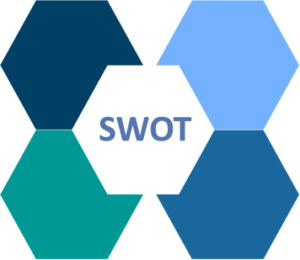
During this analysis, potential risks and challenges are identified to provide a comprehensive understanding of the external threats that might impact the success of the growth initiative. The examination delves into how internal strengths can be strategically leveraged to capitalize on external opportunities. Strengths and weaknesses are assessed in relation to the identified opportunities, allowing organizations to strategize on how to best position themselves to take advantage of favorable conditions while addressing potential pitfalls.
By undertaking a SWOT analysis at this juncture, organizations gain nuanced insights into the strategic alignment of each opportunity within their operational landscape. The process facilitates the development of tailored strategies and action plans that harness internal strengths, mitigate weaknesses, exploit external opportunities, and counteract potential threats. Ultimately, the SWOT analysis of prioritized opportunities serves as a robust framework for decision-makers, enabling them to craft a well-informed roadmap that maximizes the likelihood of success for the selected growth initiatives.
Scenario Planning
Scenario planning represents a strategic step in the growth opportunity mapping process, aiming to proactively anticipate and plan for various scenarios that might impact the implementation of identified growth opportunities. The primary objective is to navigate uncertainties and external factors effectively, ensuring a robust strategy that is adaptable to different circumstances. The process begins by identifying potential uncertainties and external factors that could influence the outcomes of growth initiatives, taking into account variables such as market dynamics, regulatory changes, or technological advancements.
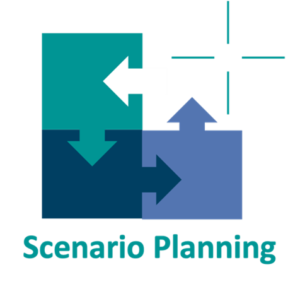
Once potential uncertainties are identified, the next step involves developing alternative scenarios and assessing their implications on each growth opportunity. This forward-looking approach enables organizations to consider a range of potential futures, providing a holistic perspective on the various ways external factors may evolve. By evaluating the implications of each scenario, decision-makers can better understand the potential risks and rewards associated with each growth opportunity under different circumstances.
In parallel, scenario planning involves planning mitigation strategies for potential risks identified during the scenario development phase. This step ensures that organizations are well-prepared to address challenges that may arise in different scenarios, enhancing their resilience and adaptability. Overall, scenario planning equips organizations with a strategic foresight that goes beyond a singular projection, enabling them to make informed decisions and tailor their approach based on the evolving landscape.
Roadmap development
Roadmap development is a pivotal phase in the growth opportunity mapping process, aiming to translate prioritized opportunities into actionable plans for implementation. The primary objective is to create a comprehensive roadmap that outlines the specific steps, milestones, and timelines for bringing prioritized growth opportunities to fruition. The process begins by defining clear and achievable milestones for each opportunity, providing a structured framework for tracking progress.
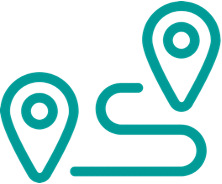
In conjunction with milestone definition, the allocation of resources and responsibilities for execution is a crucial step in roadmap development. This involves identifying the necessary human, financial, and technological resources required to undertake each growth initiative successfully. Assigning responsibilities ensures accountability and clarity in the execution process, helping teams align their efforts with the overall strategic objectives.
Simultaneously, the development of key performance indicators (KPIs) is an integral aspect of roadmap creation. KPIs serve as measurable metrics that gauge the success and impact of each growth opportunity. These indicators provide organizations with a means to objectively assess the effectiveness of their strategies, allowing for continuous monitoring and adjustment based on performance data.
Overall, roadmap development acts as a guiding document, offering a structured plan for the implementation of growth opportunities. By incorporating clear milestones, resource allocation, and KPIs, organizations enhance their ability to execute strategies systematically and measure the success of their growth initiatives.
Concluding thoughts about the implementation of an opportunity map
Opportunity mapping offers a multifaceted approach to strategic planning with several advantages. It serves as a powerful tool for uncovering hidden growth opportunities, enabling organizations to unearth potential avenues for development that may not be immediately evident. Moreover, the process facilitates the prioritization of growth initiatives, ensuring that efforts are strategically aligned and resources are efficiently utilized. The practice also nurtures a culture of innovation within the organization, encouraging teams to think creatively and explore novel solutions. By aligning teams with strategic goals, opportunity mapping ensures that projects are cohesive and contribute meaningfully to overarching objectives. Additionally, it enhances organizational adaptability and agility, fostering a dynamic environment that can respond effectively to evolving market conditions. However, challenges such as data overload, stakeholder alignment, continuous adaptation, resource allocation, and ensuring objectivity must be navigated to maximize the benefits of this strategic approach.

Case Study opportunity mapping Intuitive Surgical’s Development of the da Vinci Surgical System
Intuitive Surgical identified a significant opportunity in the field of minimally invasive surgery. Traditional surgical methods often posed challenges such as limited precision, extensive recovery times, and large incisions. The opportunity lay in developing a robotic-assisted surgical system that could overcome these challenges, providing surgeons with enhanced capabilities and patients with improved outcomes.
Opportunity Prioritization: To prioritize this opportunity, Intuitive Surgical established key criteria. They considered the technological feasibility of developing a robotic system, the clinical need for improved surgical methods, and the potential market size for such an innovation. Thorough market research and analysis allowed them to ascertain the feasibility and potential impact of investing in this opportunity.

Conducting a detailed SWOT analysis was crucial for understanding the internal and external dynamics of the opportunity. They identified strengths in the potential of robotic technology to enable precise and minimally invasive procedures. Weaknesses included initial implementation costs and the learning curve for surgeons. Opportunities lay in expanding the application of robotic assistance in various surgical domains, while threats encompassed potential competition and regulatory challenges. High Initial Costs: One of the significant obstacles was the high initial costs associated with acquiring and implementing the da Vinci system. Hospitals and surgical centers had to invest substantially in purchasing the robotic system, which posed financial challenges for many healthcare institutions. In fact, a number of obstacles had to be considered and overcome:
1. Learning Curve for Surgeons: The da Vinci system introduced a new paradigm in surgery, requiring surgeons to undergo training to master robotic-assisted techniques. The learning curve for surgeons was a hurdle, and some hesitated to adopt the technology due to concerns about the time required for proficiency.
2. Limited Intuitive Feedback: While the system provided enhanced visualization and precision, it initially lacked the tactile feedback that surgeons are accustomed to in traditional surgery. The absence of direct physical touch posed challenges in terms of surgeons feeling disconnected from the surgical field.
3. Regulatory Approval and Standardization: Obtaining regulatory approval for a novel surgical system is a complex process. Intuitive Surgical had to navigate regulatory pathways to ensure compliance with healthcare standards. Additionally, standardizing procedures and establishing guidelines for the use of robotic surgery required collaborative efforts with regulatory bodies.
4. Acceptance in the Medical Community: Acceptance of robotic-assisted surgery within the broader medical community was a gradual process. Convincing healthcare professionals and institutions of the benefits and safety of the da Vinci system required extensive clinical evidence, which took time to accumulate.
5. Market Competition: The success of the da Vinci system attracted competition from other companies developing robotic surgical platforms. Intuitive Surgical had to continuously innovate to stay ahead in the market and address emerging challenges from competitors.
6. Maintenance and Upkeep: The da Vinci Surgical System is a complex piece of machinery, and maintenance requirements were a consideration. Hospitals needed to invest in training staff for system maintenance and ensure ongoing support to prevent downtime during surgical procedures.
Recognizing the uncertainties in the healthcare landscape, Intuitive Surgical engaged in scenario planning. They anticipated different factors that could influence the adoption of robotic-assisted surgery. This included changes in healthcare regulations, evolving surgical practices, and the acceptance of robotic technologies by healthcare professionals. Scenario planning allowed them to proactively address potential challenges and adjust their strategy accordingly.
The development of the da Vinci Surgical System required a well-defined roadmap. Intuitive Surgical outlined specific milestones, allocated resources for research and development, and planned for regulatory approvals. This roadmap also included strategies for market entry, such as collaboration with medical institutions for clinical trials. Key performance indicators (KPIs) were established to measure the success of the system in terms of clinical outcomes and market penetration.
Results: The da Vinci Surgical System was successfully developed and launched, marking a transformative moment in the field of minimally invasive surgery. Surgeons embraced the technology for its precision and improved visualization, leading to widespread adoption across various surgical specialties. The success of the da Vinci Surgical System positioned Intuitive Surgical as a leader in the medtech industry, with subsequent iterations and advancements maintaining their innovative edge.

Exercise 1.11
• Topline contribution next year
• Cumulative topline contribution next five/ten years
• Cost this year/over the next three years
• One time/running costs
• Bottom line contribution within the next one/three/five/ten years
• FTE (full time equivalent) requirements over the next one/three/five/ten years
• Complexity to implement (high/medium/low)
• Uncertainty and risks (high/medium/low)
• Fit with company strategic priorities (high/medium/low)

Course Manual 12: Prioritize Short Term And Low Resource Requirements
Effective portfolio prioritization is a cornerstone of strategic decision-making, guiding organizations to allocate resources judiciously and focus efforts on initiatives with the greatest potential impact. In this context, the methodology used for prioritizing opportunities plays a pivotal role in shaping the trajectory of growth. Organizations often seek to identify short-term, low-investment opportunities that can deliver quick wins and contribute to overall portfolio success. The goal is to strike a balance between immediate gains and long-term strategic objectives. In this dynamic landscape, various prioritization frameworks and methodologies come into play, offering structured approaches to assess the feasibility, impact, and urgency of each opportunity. By navigating through these methodologies, organizations can effectively pinpoint and capitalize on short-term, low-investment opportunities that align with their overarching strategic goals.

Understanding the significance of making strategic decisions in resource allocation, several methodologies are reviewed to streamline the prioritization process of growth opportunities:
1. The RICE framework, which assesses opportunities based on their Reach, Impact, Confidence, and Effort required for implementation.
2. The Urgent/Important Matrix, commonly known as the Eisenhower Matrix, offers a simple yet powerful approach by categorizing tasks into four quadrants to prioritize based on urgency and importance.
3. The ICE method, evaluating opportunities based on their Impact, Confidence, and Ease of execution.
4. The Value/Complexity Matrix provides a visual tool for mapping opportunities along two dimensions, allowing for a nuanced assessment.
5. The Weighted Scoring technique, which involves assigning weights to different dimensions for a comprehensive evaluation.
1. RICE (Reach, Impact, Confidence, Effort)
The RICE framework, a widely used methodology for prioritizing opportunities, has a significant history of providing organizations with a structured approach to evaluate and rank potential initiatives. Developed by Intercom, the RICE framework stands for Reach, Impact, Confidence, and Effort. Reach measures the number of people affected by the opportunity, Impact gauges the potential positive outcomes, Confidence reflects the certainty in the estimates, and Effort estimates the resources required for implementation. The framework has become a staple in the product management and growth hacking realms, offering a quantitative approach to prioritize diverse opportunities within a portfolio.
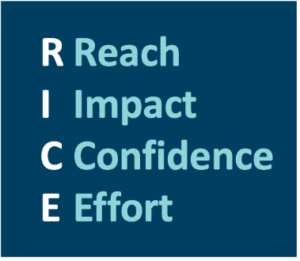
One of the key advantages of the RICE framework lies in its systematic nature. By incorporating multiple criteria, it allows for a holistic evaluation of each opportunity. The inclusion of Reach, Impact, and Effort provides a balanced perspective, ensuring that prioritization decisions are based on both potential benefits and practical considerations. However, the framework does have its drawbacks. As with any quantitative method, it may not capture qualitative aspects that are crucial for decision-making. The subjective nature of estimates, especially in the Confidence factor, introduces a level of uncertainty that organizations must navigate.
In practical application, organizations benefit from the RICE framework’s ability to provide a standardized approach to opportunity prioritization. It streamlines the decision-making process and helps teams focus on initiatives with the greatest potential. However, it is essential to acknowledge the limitations related to confidence estimates and the potential oversimplification of complex qualitative factors. Despite its shortcomings, the RICE framework remains a valuable tool in the toolkit of portfolio managers and decision-makers aiming to strike a balance between quantitative assessment and qualitative considerations in prioritizing growth opportunities.
2. Urgent/Important Matrix
The Urgent/Important Matrix, often referred to as the Eisenhower Matrix, has a rich history rooted in the principles of time management and decision-making. Named after President Dwight D. Eisenhower, who was known for his ability to prioritize tasks effectively, this matrix provides a straightforward approach to categorize opportunities or tasks based on their urgency and importance. The matrix features four quadrants: Urgent and Important, Important but Not Urgent, Urgent but Not Important, and Neither Urgent nor Important.

The advantages of the Urgent/Important Matrix lie in its simplicity and ease of use. Its visual representation allows for quick and intuitive prioritization of tasks. By differentiating between urgency and importance, it helps individuals and organizations allocate time and resources more efficiently. Moreover, the matrix encourages a proactive approach to time management, emphasizing the importance of addressing non-urgent but crucial tasks. The matrix is not without its limitations. Its reliance on subjective judgment for categorization makes it susceptible to individual biases. What one person deems urgent and important might differ from another’s perspective. Additionally, the matrix may oversimplify the complexity of certain opportunities, especially those that require a nuanced understanding of factors beyond urgency and importance.
In practical terms, the Urgent/Important Matrix is widely used for its quick and accessible nature. It is a valuable tool for individuals seeking to prioritize their tasks effectively. Nevertheless, users should be mindful of its subjective nature and consider combining it with other methodologies for a more comprehensive evaluation of growth opportunities.
3. ICE Method
The ICE Method, an acronym for Impact, Confidence, and Ease, represents a prioritization framework that seeks to evaluate growth opportunities by considering their potential impact, the level of confidence in achieving success, and the ease of execution. This methodology provides a balanced approach, taking into account both quantitative and qualitative aspects of opportunities.
In terms of its conceptualization, the ICE Method has evolved as a response to the need for a more nuanced evaluation of opportunities beyond a single-dimensional analysis. By considering impact, confidence, and ease, it aims to provide a comprehensive understanding of the potential value and feasibility of each opportunity.
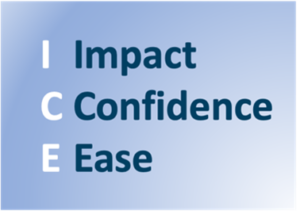
The advantages of the ICE Method lie in its flexibility and ability to capture both quantitative and qualitative factors. This allows for a more holistic evaluation, considering not only the potential impact of an opportunity but also the confidence in achieving that impact and the ease with which it can be executed. The inclusion of these multiple dimensions facilitates a more nuanced prioritization process. However, like any methodology, the ICE Method has its drawbacks. Its reliance on subjective assessments introduces an element of variability, as different stakeholders may perceive impact, confidence, and ease differently. The balance between these factors can also vary based on individual perspectives, potentially leading to disagreements during the prioritization process.
In practical terms, the ICE Method is commonly applied in strategic planning sessions and innovation workshops where a diverse group of stakeholders is involved in evaluating and prioritizing growth opportunities. While its subjective nature requires careful consideration, its ability to provide a more nuanced assessment makes it a valuable tool when used judiciously within a collaborative decision-making context.
4. Value/Complexity Matrix
The Value/Complexity Matrix, often utilized as a prioritization methodology, offers a visual tool to assess and map growth opportunities based on two key dimensions: value and complexity. This matrix aids in evaluating the trade-off between the potential value an opportunity may bring and the complexity involved in its implementation.
Conceptually, the Value/Complexity Matrix emerged as a response to the need for a more nuanced understanding of opportunities, acknowledging that the potential value of an initiative must be balanced against the inherent complexities associated with its execution.
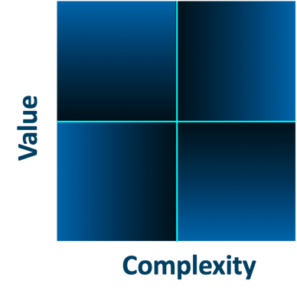
Advantages of this methodology include its ability to provide a visual representation, facilitating quick comprehension and aiding in decision-making. The matrix allows for a nuanced assessment by considering both value and complexity, providing a more holistic view of each opportunity.
However, the Value/Complexity Matrix has its share of disadvantages. Determining the precise position of an opportunity on the matrix involves subjective judgment, as stakeholders may interpret value and complexity differently. Additionally, quantifying and categorizing the multifaceted nature of complexity can be challenging, making it difficult to assign precise values to opportunities.
With regards to its practical use, the Value/Complexity Matrix finds application in strategic planning sessions and decision-making forums where a visual representation of opportunities is beneficial. Despite its subjective elements, the matrix proves useful when employed with a diverse group of stakeholders who bring varied perspectives to the evaluation process. Careful consideration of the potential biases and collaborative discussion can enhance the effectiveness of this methodology in practice.
5. Weighted Scoring Technique
The Weighted Scoring Technique stands out as a prioritization methodology, involving the assignment of weights to various dimensions or criteria for a comprehensive evaluation. This approach allows organizations to prioritize factors based on their significance, providing a quantitative framework for decision-making.
Conceptually, the Weighted Scoring Technique has its roots in the pursuit of a more structured and systematic method for evaluating opportunities. The history of this methodology is intertwined with the evolution of decision-making processes within organizations, seeking ways to balance and prioritize diverse factors in a more objective manner.
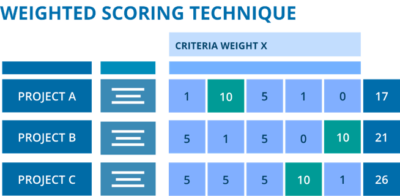
Advantages of the Weighted Scoring Technique include its quantitative approach, enabling organizations to assign numerical values to different criteria, leading to a more objective and structured assessment. Another advantage lies in its flexibility, as organizations can customize weights based on their specific priorities and objectives. Practical use of the Weighted Scoring Technique comes with certain challenges. The methodology demands clear definition and agreement on the weights assigned to different criteria, which can be a complex task requiring alignment among stakeholders. Additionally, the process can be time-consuming, particularly during the initial stages of setting up and agreeing upon the weights.
In everyday use, the Weighted Scoring Technique finds application in situations where organizations require a more quantitative and customizable approach to prioritize opportunities. Its practical utility is enhanced when used in collaborative settings, allowing stakeholders to contribute their insights and perspectives to the weighting process. Careful consideration of potential biases and transparent communication can help mitigate challenges associated with the application of this methodology.
To support flexible adaptation to each organization’s needs, the Weighted Scoring methodology stands out. Several key considerations contribute to the rationale for employing this methodology:
1. Objective Evaluation: The Weighted Scoring Technique facilitates an objective evaluation of opportunities. By assigning numerical values to different criteria, it reduces the subjectivity inherent in decision-making, enabling a more data-driven and impartial assessment.
2. Customization for Priorities: Organizations often have specific priorities or strategic goals that vary in importance. The methodology allows for customization by assigning weights to different criteria, reflecting the relative significance of each factor based on the organization’s unique priorities.
3. Comprehensive Assessment: The approach enables a comprehensive assessment of opportunities by considering multiple dimensions or criteria. This ensures that decision-makers take into account various factors that contribute to the overall viability and potential impact of each opportunity.
4. Quantitative Comparison: The Weighted Scoring Technique facilitates a quantitative comparison of different opportunities. This aspect is particularly beneficial when organizations need to compare and prioritize a multitude of options, providing a clear numerical basis for decision-making.
5. Alignment with Organizational Goals: Organizations can align the weighted criteria with their overarching goals and strategic objectives. This ensures that the prioritization process is directly linked to the organization’s mission, vision, and desired outcomes.
6. Facilitation of Stakeholder Collaboration: In collaborative decision-making settings, the methodology serves as a facilitator for engaging stakeholders. By involving relevant parties in the process of defining and assigning weights, the organization can harness diverse perspectives and insights.
7. Transparency and Accountability: The methodology promotes transparency in decision-making. Clear definitions of weights and criteria foster accountability within the organization, making it evident how decisions align with established priorities.
8. Risk Mitigation: Through a structured evaluation process, the Weighted Scoring Technique helps organizations identify potential risks and challenges associated with each opportunity. This proactive risk assessment contributes to more informed decision-making.
Overall, the Weighted Scoring Technique is a valuable tool for organizations seeking a systematic, customizable, and objective approach to prioritize opportunities in alignment with their strategic objectives. It addresses the complexity of decision-making by providing a clear and quantifiable framework that can be adapted to suit the specific needs and priorities of the organization.
When applying the Weighted Scoring methodology, several practical considerations should be taken into account to ensure its effectiveness and relevance to the specific context of the organization. These considerations help guide the implementation of the methodology and enhance its practical utility:
1. Clear Definition of Criteria
Ensure that the criteria that are used for evaluation are clearly specified and that all of the stakeholders have a clear understanding of them. In order to minimize ambiguity and misinterpretation, it is important to express the meaning and significance of each criterion in a clear and concise manner.
2. Collaborative Involvement
The process of defining and assigning weights to criteria should involve the participation of relevant stakeholders. Additionally, it is important to encourage collaboration in order to capture varied perspectives and to guarantee that the methodology accurately reflects the organization’s collective interests.
3. Weight Consensus
Through conversations and sessions aimed at developing consensus, aim to reach a consensus on the weights that have been assigned. In order to build a common understanding of the relative importance of each criterion, it is necessary to address any misunderstandings or discrepancies that may exist among the stakeholders.
4. Regular Review and Updates
The assigned weights should be reviewed on a regular basis and, if necessary, updated to account for any changes in the priorities of the company or any external events that may have occurred. Make certain that the approach continues to be in accordance with the ever-evolving objectives of the organizing body.
5. Data Availability and Accuracy
Make sure that the data that is connected with each criterion is both accurate and readily available. Therefore, in order to preserve the credibility of the evaluation procedure, you should make certain that the data that is utilized for scoring is accurate and up to date.
6. Scalability
It is important to take into consideration the scalability of the process, particularly when working with a diverse range of prospects. Determine whether the approach is capable of efficiently managing the extent of the organization’s current operations as well as its potential for future expansion.
7. Training and Communication
To ensure that all parties participating in the Weighted Scoring process have a thorough understanding of the methodology, its goal, and how to apply it in a consistent manner, it is imperative that training and communication be provided to the stakeholders involved in the process.
8. Balanced Criteria Selection
To achieve a balanced set of criteria that takes into account both quantitative and qualitative characteristics that are pertinent to the context of decision-making, you should strive to achieve this. Steer clear of a set of criteria that is excessively complicated, since this could result in confusion or make application more difficult.
9. Consideration of Risk and Uncertainty
In the process of assigning weights and scoring criteria, it is important to acknowledge the inherent uncertainties and risks that are involved. In order to manage uncertainties, it is necessary to implement techniques and to consider doing sensitivity analysis in order to evaluate the impact of different weights.
10. Adaptability to Changing Circumstances
The methodology should be designed with flexibility so that it can be adapted to changing conditions or events that were not anticipated. Make sure to incorporate systems that allow for periodic reevaluation and adjustments as required.
By accounting for these practical considerations, organizations can implement the Weighted Scoring methodology in a manner that aligns with their unique circumstances, promotes transparency, and enhances the robustness of the decision-making process. The advantage of including several dimensions in the evaluation, with the option to prioritize two, depending on the specific organization’s situation, outweighs other methodologies. It enables decision makers to prioritize opportunities using a transparent fact base while aligning the members of the organization in the process. Selecting two dimensions, for example the short-term impact on the bottom line vs. the short-term resources required, allows to identify the low hanging fruit to drive growth while keeping costs under control.

Case Study evolution of portfolio management: Novartis Navigating Innovation and Market Dynamics
Historical Context
Novartis has a rich history of adapting its portfolio management strategies to the ever-changing landscape of the pharmaceutical industry. The company’s evolution in portfolio management reflects a proactive response to challenges, regulatory shifts, and emerging opportunities.
Early Stages
In the early stages of its portfolio management journey, Novartis recognized the need to align its diverse range of therapeutic areas with a more strategic focus. This led to the establishment of therapeutic area-based business units, allowing for a more concentrated approach to resource allocation and innovation.

Integration of Quantitative Metrics
As the pharmaceutical landscape evolved, Novartis acknowledged the importance of incorporating quantitative metrics into its portfolio management approach. The company introduced key performance indicators (KPIs) and quantitative assessments to measure the potential reach, impact, and feasibility of its research and development (R&D) projects.
Introduction of Risk-Adjusted Approaches
The mid-2000s marked a pivotal moment in Novartis’s portfolio management evolution. Recognizing the inherent risks in drug development, regulatory processes, and market acceptance, the company introduced risk-adjusted return on investment (RAROI) methodologies. This shift aimed to provide a more nuanced evaluation of project potential, factoring in associated risks and uncertainties.
Patient-Centric Innovation Focus
In response to the industry’s increasing emphasis on patient outcomes and unmet medical needs, Novartis strategically integrated patient-centric innovation into its portfolio management. This shift involved a more thorough evaluation of projects based on their potential to address significant medical challenges and improve patient well-being.
Adaptation to Market Dynamics
The pharmaceutical landscape is characterized by rapid changes, including advancements in technology, shifts in healthcare policies, and evolving market dynamics. Novartis’s portfolio management evolved to become more adaptable and responsive to these changes. The company embraced an agile mindset, allowing for quicker adjustments to emerging opportunities and challenges.
Collaborative Cross-Functional Teams
To enhance portfolio decision-making, Novartis fostered collaboration among cross-functional teams. Bringing together expertise from research and development, commercial, regulatory affairs, and other relevant domains became integral to the decision-making process. This collaborative approach ensures that decisions align with both scientific advancements and market demands.
Integration of Digital Health and Data Analytics
In recent years, Novartis has leveraged digital health technologies and data analytics to enhance its portfolio management capabilities. Incorporating real-world evidence and leveraging data-driven insights have become essential components of decision-making processes. This evolution aligns with the broader industry trend towards leveraging technology for more informed decision-making.
Continuous Learning and Improvement
Novartis views its portfolio management approach as a dynamic process that requires continuous learning and improvement. Regular reviews and assessments of portfolio performance contribute to refining methodologies, ensuring that the company remains at the forefront of innovation.
Novartis’s journey in portfolio management exemplifies a commitment to evolution and adaptability. From early strategic realignment to the integration of quantitative metrics, risk-adjusted approaches, patient-centric innovation, and digital advancements, Novartis continues to refine its methodologies to navigate the complexities of the pharmaceutical industry successfully.

Exercise 1.12
Project Studies
Process Review
This workshop helps identify market and organizational growth drivers and constraints. Start with distinctiveness or market expansion to choose the dominating strategy. Technology can help you enter, develop, or change markets via novel solutions or service integrations that link existing and new markets. This technique has helped numerous companies identify and rank expansion prospects for brands, franchises, and the corporation. The concept that every organization has valuable market insights that may be used to accelerate growth drives the systematic identification and examination of different growth opportunities. You’ve analyzed how the latest publicly available technology and information are used intelligently to understand user expectations and customer experience strategies. Build on the introduced methodology by Stanford School of Design’s Design Thinking. Participants should capture the insights captured during the empathy, definition, ideation, prototyping, and testing steps. Cutting-edge healthcare and IT companies employ this method to produce and test new ideas quickly, boosting growth. This solid foundation framework is used throughout the program. This creates an early growth potential map by focusing on short-term, low-resource prospects. The workshop creates an initial list of growth opportunities based on the organization’s goals.
It is essential to make the Accelerate Growth program a priority, committing the time, focus, and dedication required to succeed. The program is designed to have a direct and strategic impact on the future of the organization. It is of critical importance to align the program with the company’s mission, purpose, its values and the key processes. The challenge facing many organizations today is to continuously drive growth and improve both their top and bottom lines. In order to ensure this alignment, complete the following tasks:
1. List the organization’s mission, purpose and values.
2. Reflect on how they enable and impede growth opportunities. Check how the actual investments line up with the priorities to maintain the business and to drive growth.
3. List the key processes to consider when embedding growth focus throughout the organization.
Process Re-Design
Achieving sustained growth within an organization necessitates more than just strategic planning and implementation; it demands a fundamental shift in mindset and a pervasive cultural orientation toward actively seeking and embracing growth opportunities. This entails fostering a dynamic and forward-thinking mentality across all levels of the organization. It involves cultivating a corporate culture that not only values innovation and change but actively encourages employees to explore, propose, and champion growth initiatives. This transformative mindset empowers individuals to view challenges as opportunities, promoting agility, adaptability, and a continuous quest for improvement. In essence, it’s about instilling a collective consciousness that perceives growth not as an occasional outcome but as an ongoing journey integral to the organizational DNA.
The workshop’s curriculum is meticulously crafted to serve a dual purpose: identifying growth opportunities and providing a structured framework for their preliminary prioritization. Through a combination of theoretical insights, practical exercises, and real-world case studies, participants are equipped with the skills to discern potential growth areas within their specific industry and organizational context. The courses guide individuals through the intricate process of recognizing unmet needs, market gaps, and untapped potentials. Furthermore, the workshop provides participants with methodologies and tools to conduct an initial assessment and prioritize growth opportunities based on key criteria such as impact, feasibility, and strategic alignment. This preliminary prioritization serves as a valuable starting point for organizations to focus their efforts and resources on the most promising avenues for growth.

The integration of the design thinking concept into an organization’s processes goes beyond a one-time implementation; it fosters sustainable and enduring behavioral changes. Design thinking is not just a set of methodologies; it’s a mindset and a collaborative approach that values empathy, ideation, and iteration. When woven into the fabric of an organization’s culture, it influences how problems are approached, solutions are developed, and challenges are navigated. This sustained behavioral change manifests in a workplace where innovation is not an isolated event but a continuous, ingrained practice. By encouraging teams to empathize with end-users, iterate on solutions, and embrace a human-centric perspective, organizations can cultivate a culture of adaptability and creativity. This, in turn, ensures that the principles of design thinking become embedded in day-to-day operations, contributing to the longevity and resilience of the organization in the face of evolving challenges.
Bring together the contents and exercises from the individual courses:
1. list the identified market growth drivers
2. list the identified organizational growth drivers
3. describe the focus of the fundamental strategic choices
4. the five most important growth opportunities from your perspective
5. Insights from empathizing with patients, caregivers and customers
6. Review the consolidated Point of View statement and reflect on any changes to the Why-How ladder
7. Reconcile the take aways from the Point of View statement with the results generated during the Ideation process
8. Review and refine the prototype plan
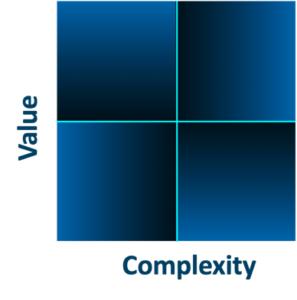
9. Prioritize which growth opportunities to test from an organizational perspective, plan the resources and time and how you will capture the insights.
10. Integrate this feedback with the preliminary list of growth opportunities developed in this course.
11. Consolidate and align on the two key dimensions to use during the prioritization of growth opportunities.
12. Update and consolidate the table developed in course 12 and map the different growth opportunities. Identify the internal potential sponsors and stakeholders to review with and secure alignment and support.
Resources
• Design Thinking for Business Innovation (Stanford Graduate School of Business) Description of the program of Stanford Graduate School of Business.
• IDEO U: Insights for Innovation (Online Learning Platform) IDEO U – Insights for Innovation. IDEO U, an online learning platform by the renowned design firm IDEO, provides courses on insights for innovation. These courses delve into design thinking methodologies and their practical application in various industries, offering valuable perspectives for those in pharma, biotech, and medtech.
• Design Thinking in Health and Life Sciences (McKinsey & Company). Design Thinking in Health and Life Sciences. McKinsey & Company provides insights into applying design thinking in the health and life sciences sector. The article discusses practical examples and case studies, offering strategic guidance for organizations in pharma and biotech.
• Biodesign: The Process of Innovating Medical Technologies (Stanford Byers Center for Biodesign). Stanford’s Biodesign program focuses on innovation in medical technologies. While not exclusively about design thinking, it incorporates human-centered design principles. The website provides resources, case studies, and information on the program.
• Design Thinking for MedicineCoursera – Design Thinking for Medicine. This Coursera course is dedicated to applying design thinking in the field of medicine. It covers topics such as patient-centered design, prototyping, and testing, providing insights relevant to pharma, biotech, and medtech.
• Journal of Medical Internet Research (JMIR) – Human Factors and Usability Studies: JMIR – Human Factors and Usability Studies.The Journal of Medical Internet Research publishes articles on human factors and usability studies in healthcare. Exploring these studies can offer perspectives on applying design thinking to enhance the user experience in pharma, biotech, and medtech.
• MIT Sloan Management Review – Design Thinking progress review. This article explores how design thinking can be a source of competitive advantage. While not industry-specific, the insights can be applied to the unique challenges of the pharma, biotech, and medtech sectors.
When utilizing these resources, it’s crucial to adapt the methodologies and insights to the specific context and regulatory landscape.
Measuring Success
In the realm of design thinking and pursuing growth opportunities, the significance of Key Performance Indicators (KPIs) and meaningful metrics cannot be overstated. KPIs serve as the compass, providing a clear direction and shared understanding within an organization undergoing the iterative process of identifying and prioritizing growth initiatives. They illuminate the path toward successful innovation by offering quantifiable insights into the effectiveness of the design thinking methodology, ensuring alignment with strategic goals, and fostering a culture of continuous improvement.
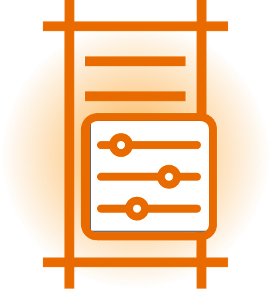
Understanding the “What” involves identifying the specific KPIs that resonate with the goals of the growth program. These may include metrics related to ideation effectiveness, prototype validation, and user testing outcomes. For instance, tracking the number of successfully validated prototypes or the degree of user satisfaction during testing can provide tangible indicators of progress. Equally vital is the “How” – the method of tracking and documenting results. Regularly capturing and analyzing KPI data, especially after each monthly workshop, facilitates real-time insights, enabling swift adjustments to strategies and methodologies. This dynamic approach, rooted in meaningful metrics, ensures that the design thinking journey remains responsive to evolving challenges and opportunities, steering the organization toward impactful and sustainable growth.
Align on a few meaningful metrics for your organization about the What and How. Make the reporting part of any output presentation so that it becomes part of the fabric.
1. Review the progress made and seek to understand the gaps that you observe, as well as the steps that worked well.
2. Identify the challenges encountered when pulling through to ensure that these can be addressed in the next steps of this program.
Program Benefits
Marketing
- Design thinking
- Marketing 5.0
- Ecosystem mapping
- Patient journey
- Leverage points
- Deep insights
- Competitive advantages
- Physician engagement
- Agile marketing
- Agile medical
Management
- Market expansion
- Market prioritization
- Market ecosystems
- Communication channels
- HCP platforms
- Patient engagement
- Data dissemination
- International RWE
- International expansion
- Value growth
Technology
- Digital marketing
- Digital maturity
- Digital capabilities
- Digital insights
- Digital KOL
- Artificial intelligence
- Generative ai
- Tech stack
- Cloud solutions
- Big data
Client Telephone Conference (CTC)
If you have any questions or if you would like to arrange a Client Telephone Conference (CTC) to discuss this particular Unique Consulting Service Proposition (UCSP) in more detail, please CLICK HERE.























